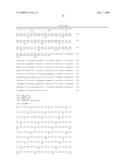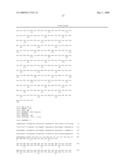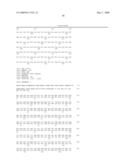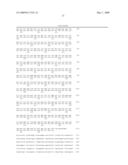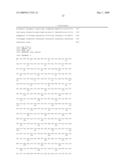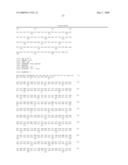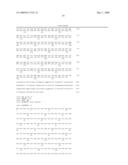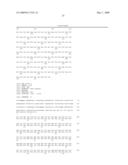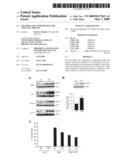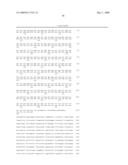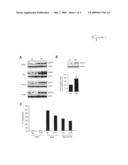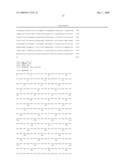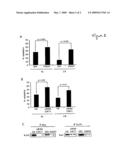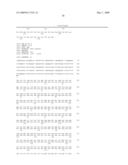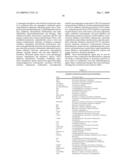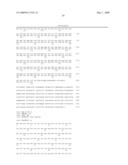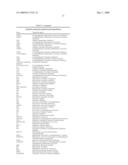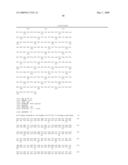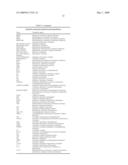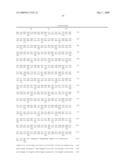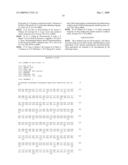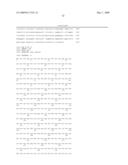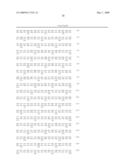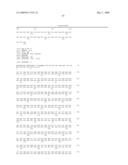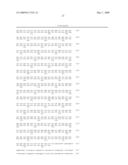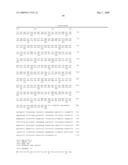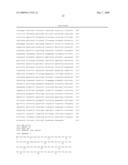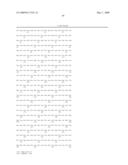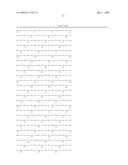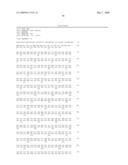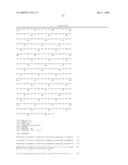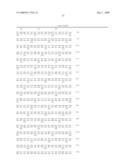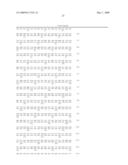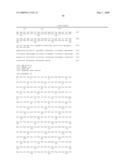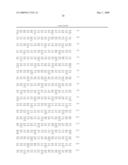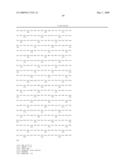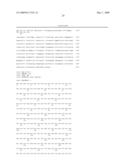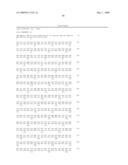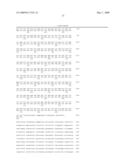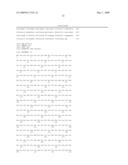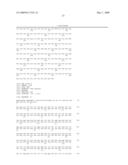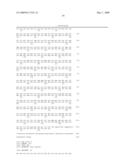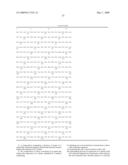Patent application title: METHODS AND COMPOSITIONS FOR INDUCING SIRTUINS
Inventors:
David A. Sinclair (Chestnut Hill, MA, US)
David A. Sinclair (Chestnut Hill, MA, US)
Assignees:
President and Fellows of Harvard College
IPC8 Class: AC12Q168FI
USPC Class:
435 6
Class name: Chemistry: molecular biology and microbiology measuring or testing process involving enzymes or micro-organisms; composition or test strip therefore; processes of forming such composition or test strip involving nucleic acid
Publication date: 2009-05-07
Patent application number: 20090117543
Claims:
1. A composition comprising a fraction of serum of a
calorically-restricted organism, wherein the fraction of serum induces
the expression of a sirtuin.
2. The composition of claim 1 enriched in an agent that induces the expression of a sirtuin, identified by a method comprising(i) obtaining one or more fractions of serum from a calorically-restricted organism;(ii) contacting the one or more fractions with a cell;(iii) determining the level of expression of a sirtuin in the cell, wherein a higher level of expression of the sirtuin in the cell contacted with a fraction relative to a cell that was not contacted with the fraction indicates that the fraction contains an agent that induces the expression of a sirtuin; and(iv) obtaining one or more subfractions of a fraction that contains an agent that induces the expression of a sirtuin and repeating steps (ii) and (iii).
3. The composition of claim 2, wherein the method further comprises repeating step (iv).
4. A method comprising contacting serum from a calorically-restricted organism with a cell and determining the level of expression of a sirtuin in the cell.
5. The method of claim 4 for determining the presence of an agent that induces the expression of a sirtuin in serum or a fraction thereof from a calorically-restricted organism, comprising(i) contacting a cell with a composition comprising serum or a fraction thereof from a calorically-restricted organism; and(ii) determining the level of expression of a sirtuin in the cell;wherein a higher level of sirtuin expression in the cell contacted with the composition comprising serum or a fraction thereof from a calorically-restricted organism relative to a composition that does not comprise serum from a calorically-restricted organism or relative to another fraction of serum from the calorically-restricted organism indicates that the serum or fraction thereof from the calorically-restricted organism comprises an agent that induces the expression of a sirtuin.
6. The method of claim 4 for enriching a composition in an agent that induces the expression of a sirtuin, comprisingi) obtaining one or more fractions of serum from a calorically-restricted organism;(ii) contacting the one or more fractions with a cell;(iii) determining the level of expression of a sirtuin in the cell, wherein a higher level of expression of the sirtuin in the cell contacted with a first fraction relative to a cell that was not contacted with the fraction or contacted with a second fraction indicates that the first fraction contains an agent that induces the expression of a sirtuin; and(iv) obtaining one or more subfractions of the fraction that contains an agent that induces the expression of a sirtuin and repeating steps (ii) and (iii),to thereby enrich a composition in an agent that induces the expression of a sirtuin.
7. The method of claim 6, further comprising repeating step (iv).
8. The method of claim 4 for identifying a factor in serum from a calorically-restricted organism that induces the expression of a sirtuin, comprisingi) obtaining one or more fractions of serum from a calorically-restricted organism;(ii) contacting the one or more fractions with a cell;(iii) determining the level of expression of a sirtuin in the cell, wherein a higher level of expression of the sirtuin in the cell contacted with a first fraction relative to a cell that was not contacted with the fraction or contacted with a second fraction indicates that the first fraction contains an agent that induces the expression of a sirtuin;(iv) obtaining one or more subfractions of the fraction that contains an agent that induces the expression of a sirtuin and repeating steps (ii) and (iii); and(v) repeating steps (i)-(iv) for a number of times sufficient to identify the factor that induces the expression of a sirtuin.
9. A method for increasing the expression of a sirtuin in a cell and/or reducing the susceptibility of a cell to apoptosis, comprising contacting the cell with serum or a fraction thereof from a calorically-restricted organism.
10. The method of claim 9, further comprising determining the level of expression of a sirtuin in the cell.
11. The method of claim 9, wherein the fraction is a composition enriched in an agent present in serum from a calorically-restricted organism.
12. The method of claim 9 for reducing the susceptibility of a cell to apoptosis, further comprising increasing the protein or activity level of Ku70 in the cell.
13. The method of claim 4 for identifying an agent that increases the expression of a sirtuin gene, comprising(i) contacting a cell comprising a reporter gene operably linked to a transcriptional control region of a sirtuin gene with serum or a fraction thereof from a calorically-restricted organism; and(ii) determining the level of expression of the reporter gene,(iii) wherein a higher level of expression of the reporter gene in the cell contacted with the serum or fraction thereof relative to a cell that was not contacted with the serum or fraction thereof indicates that the serum or fraction thereof comprises an agent that increases the expression of a sirtuin gene.
14. The method of claim 13, wherein the transcriptional control region is a promoter region.
15. The method of claim 13, wherein the sirtuin gene encodes SIRT1.
16. The method of claim 13, wherein the sirtuin gene encodes sir2.
17. A composition comprising a fraction from the serum of a non-calorically-restricted organism, wherein the fraction of serum inhibits the expression of a sirtuin.
18. A composition of claim 17 enriched in an agent that suppresses the expression of a sirtuin, identified by a method comprising(i) obtaining one or more fractions of serum from a non-calorically-restricted organism;(ii) contacting the one or more fractions with a cell;(iii) determining the level of expression of a sirtuin in the cell, wherein a lower level of expression of a sirtuin in the cell contacted with a first fraction relative to a cell that was contacted with serum from a calorically-restricted organism or relative to a cell that was contacted with a second fraction of serum from a non-calorically-restricted organism indicates that the first fraction contains an agent that inhibits the expression of a sirtuin; and(iv) obtaining one or more subfractions of the first fraction that contains an agent that inhibits the expression of a sirtuin and repeating steps (ii) and (iii).
19. The composition of claim 18, wherein the method further comprises repeating step (iv).
20. A method comprising contacting serum from a non-calorically-restricted organism with a cell and determining the level of expression of a sirtuin in the cell.
21. The method of claim 20 for determining the presence of an agent that inhibits the expression of a sirtuin in serum of a fraction thereof from a non-calorically-restricted organism, comprising(i) contacting a cell with a composition comprising serum or a fraction thereof from a non-calorically-restricted organism; and(ii) determining the level of expression of a sirtuin in the cell;wherein a lower level of sirtuin expression in the cell contacted with the composition comprising serum or a fraction thereof from a non-calorically-restricted organism relative to a composition comprising serum from a calorically-restricted organism or another fraction of the serum of the non-calorically-restricted organism indicates that the serum or fraction thereof from a non-calorically-restricted organism comprises an agent that induces the expression of a sirtuin.
22. The method of claim 20 for enriching a composition in an agent that inhibits the expression of a sirtuin, comprising(i) obtaining one or more fractions of serum from a non-calorically-restricted organism;(ii) contacting the one or more fractions with a cell;(iii) determining the level of expression of a sirtuin in the cell, wherein a lower level of expression of a sirtuin in the cell contacted with a first fraction relative to a cell that was contacted with serum from a calorically-restricted organism or relative to a cell that was contacted with a second fraction of serum from a non-calorically-restricted organism indicates that the first fraction contains an agent that inhibits the expression of a sirtuin; and(iv) obtaining one or more subfractions of the first fraction that contains an agent that inhibits the expression of a sirtuin and repeating steps (ii) and (iii).
23. The method of claim 22, further comprising repeating step (iv).
24. The method of claim 20 for identifying a factor in serum from a non-calorically-restricted organism that inhibits the expression of a sirtuin, comprising(i) obtaining one or more fractions of serum from a non-calorically-restricted organism;(ii) contacting the one or more fractions with a cell;(iii) determining the level of expression of a sirtuin in the cell, wherein a lower level of expression of a sirtuin in the cell contacted with a first fraction relative to a cell that was contacted with serum from a calorically-restricted organism or relative to a cell that was contacted with a second fraction of serum from a non-calorically-restricted organism indicates that the first fraction contains an agent that inhibits the expression of a sirtuin;(iv) obtaining one or more subfractions of the first fraction that contains an agent that inhibits the expression of a sirtuin and repeating steps (ii) and (iii); and(v) repeating steps (i)-(iv) for a number of times sufficient to identify the factor that inhibits the expression of a sirtuin.
25. A method for inhibiting the expression of a sirtuin in a cell and/or for increasing the susceptibility of a cell to apoptosis, comprising contacting the cell with serum or a fraction thereof from a non-calorically-restriction organism.
26. The method of claim 25, further comprising determining the level of expression of a sirtuin in the cell.
27. The method of claim 25, wherein the fraction is a composition enriched in an agent present in serum from a non-calorically-restricted organism.
28. The method of claim 25 for increasing the susceptibility of a cell to apoptosis, further comprising decreasing the protein or activity level of Ku70 in the cell.
29. The method of claim 20 for identifying an agent that decreases the expression of a sirtuin gene, comprising(i) contacting a cell comprising a reporter gene operably linked to a transcriptional control region of a sirtuin gene with serum or a fraction thereof from a non-calorically-restricted organism; and(ii) determining the level of expression of the reporter gene,(iii) wherein a lower level of expression of the reporter gene in the cell contacted with the serum or fraction thereof relative to a cell that was not contacted with the serum or fraction thereof indicates that the serum or fraction thereof comprises an agent that decreases the expression of a sirtuin gene.
30. The method of claim 29, wherein the transcriptional control region is a promoter region.
31. The method of claim 29, wherein the sirtuin gene encodes SIRT1.
32. The method of claim 29, wherein the sirtuin gene encodes sir2.
33. A method for determining whether a subject is calorically-restricted or resistant to a stress condition, comprising determining the protein level of a factor in the subject, wherein a higher level of the factor in the subject relative to that of a control subject indicates that the subject is calorically-restricted or resistant to stress.
34. The method of claim 33, comprising determining the level of a sirtuin protein in a tissue of the subject.
35. The method of claim 34, wherein the sirtuin is SIRT1.
36. The method of claim 33, comprising determining the level of a factor in the serum of the subject, wherein the factor increases the level of expression of a sirtuin.
37. The method of claim 36, wherein the sirtuin is SIRT1.
38. A composition comprising serum from a calorically-restricted organism and a 293T or human embryonic kidney cell.
39. A composition comprising serum from a calorically-restricted organism that is not a rat or a monkey and a cell.
40. The composition of claim 39, wherein the cell is a mammalian cell.
41. The composition of claim 40, wherein the cell is a human cell.
42. The composition of claim 39, wherein the organism is a mammal.
43. The composition of claim 42, wherein the mammal is a human.
44. A composition comprising isolated serum from a non-calorically-restricted organism that is not a rat or a monkey and a cell.
Description:
CROSS-REFERENCE TO RELATED APPLICATIONS
[0001]This application claims the benefit of U.S. Provisional Application No. 60/568,150, filed May 4, 2004, the content of which is specifically incorporated by reference herein.
BACKGROUND
[0002]In mammals, caloric restriction (CR) delays the onset of numerous age-associated diseases including cancer, atherosclerosis and diabetes, and can significantly increase median and maximum lifespan (1). The molecular mechanisms underlying this effect are not known. In the budding yeast Saccharomyces cerevisiae, CR extends lifespan by increasing the activity of Sir2 (2-5), a member of the conserved sirtuin family of NAD+-dependent deacetylases (6). In yeast and C. elegans, lifespan is extended by extra copies of the SIR2/Sir-2.1 gene (7, 8) or by small molecule sirtuin agonists (9). In mammals, it is becoming increasingly apparent that SIRT1 is a key regulator of cell defenses and cell survival in response to stress (10-14).
[0003]In response to damage or stress, cells may attempt to repair or defend themselves, but if unsuccessful, can undergo programmed cell death called apoptosis. Numerous studies show that aging is associated with increased rates of stress-induced apoptosis (15, 16) and the cumulative effects of cell loss have been implicated in various diseases including neurodegeneration, retinal degeneration, cardiovascular disease and frailty (16-20). Consistent with this, rodents subjected to CR or long-lived genetic mutants such as the p66sch knockout mouse are typically less prone to stress-induced apoptosis (15, 19, 21, 22). A critical step in initiating stress-induced apoptosis is the relocalization of the Bax protein from the cytoplasm to the outer mitochondrial membrane and the subsequent release of cytochrome c. Recent work has identified an important regulatory step in this pathway. Under normal conditions, Bax is rendered inactive by its tight association with the Ku70 protein (23, 24). In response to acute cell damage or stress, two critical lysines in Ku70 (K539, K542) become acetylated by the acetyltransferases CBP and PCAF and the Ku70-Bax interaction is disrupted, allowing Bax to localize to mitochondria (24).
SUMMARY
[0004]Provided herein are compositions, e.g., comprising a fraction of serum of a calorically-restricted organism, wherein the fraction of serum induces the expression of a sirtuin, e.g., SIRT1. A composition may be enriched in an agent that induces the expression of a sirtuin, identified by a method comprising, e.g., (i) obtaining one or more fractions of serum from a calorically-restricted organism; (ii) contacting the one or more fractions with a cell; (iii) determining the level of expression of a sirtuin in the cell, wherein a higher level of expression of the sirtuin in the cell contacted with a fraction relative to a cell that was not contacted with the fraction indicates that the fraction contains an agent that induces the expression of a sirtuin; and (iv) obtaining one or more subfractions of a fraction that contains an agent that induces the expression of a sirtuin and repeating steps (ii) and (iii). The method may further comprise repeating step (iv).
[0005]Also provided herein are methods comprising contacting serum from a calorically-restricted organism with a cell and determining the level of expression of a sirtuin in the cell. A method may be used for determining the presence of an agent that induces the expression of a sirtuin in serum or a fraction thereof from a calorically-restricted organism, and may comprise: (i) contacting a cell with a composition comprising serum or a fraction thereof from a calorically-restricted organism; and (ii) determining the level of expression of a sirtuin in the cell; wherein a higher level of sirtuin expression in the cell contacted with the composition comprising serum or a fraction thereof from a calorically-restricted organism relative to a composition that does not comprise serum from a calorically-restricted organism or relative to another fraction of serum from the calorically-restricted organism indicates that the serum or fraction thereof from the calorically-restricted organism comprises an agent that induces the expression of a sirtuin. A method may also be used for enriching a composition in an agent that induces the expression of a sirtuin, and may comprise: (i) obtaining one or more fractions of serum from a calorically-restricted organism; (ii) contacting the one or more fractions with a cell; (iii) determining the level of expression of a sirtuin in the cell, wherein a higher level of expression of the sirtuin in the cell contacted with a first fraction relative to a cell that was not contacted with the fraction or contacted with a second fraction indicates that the first fraction contains an agent that induces the expression of a sirtuin; and (iv) obtaining one, or more subfractions of the fraction that contains an agent that induces the expression of a sirtuin and repeating steps (ii) and (iii), to thereby enrich a composition in an agent that induces the expression of a sirtuin. A method may further comprise repeating step (iv). A method may also be used for identifying a factor in serum from a calorically-restricted organism that induces the expression of a sirtuin, and may comprise: (i) obtaining one or more fractions of serum from a calorically-restricted organism; (ii) contacting the one or more fractions with a cell; (iii) determining the level of expression of a sirtuin in the cell, wherein a higher level of expression of the sirtuin in the cell contacted with a first fraction relative to a cell that was not contacted with the fraction or contacted with a second fraction indicates that the first fraction contains an agent that induces the expression of a sirtuin; (iv) obtaining one or more subfractions of the fraction that contains an agent that induces the expression of a sirtuin and repeating steps (ii) and (iii); and (v) repeating steps (i)-(iv) for a number of times sufficient to identify the factor that induces the expression of a sirtuin.
[0006]Other methods that are provided include methods for increasing the expression of a sirtuin in a cell and/or reducing the susceptibility of a cell to apoptosis. A method may comprise contacting the cell with serum or a fraction thereof from a calorically-restricted organism. A method may further comprise determining the level of expression of a sirtuin in the cell. The fraction may be a composition enriched in an agent present in serum from a calorically-restricted organism or an isolated or purified factor therefrom. Methods for reducing the susceptibility of a cell to apoptosis may further comprise increasing the protein or activity level of Ku70 in the cell.
[0007]Methods also include those for identifying an agent that increases the expression of a sirtuin gene. A method may comprise (i) contacting a cell comprising a reporter gene operably linked to a transcriptional control region of a sirtuin gene with serum or a fraction thereof or factor purified, enriched or isolated therefrom, from a calorically-restricted organism; and (ii) determining the level of expression of the reporter gene, wherein a higher level of expression of the reporter gene in the cell contacted with the serum or fraction thereof relative to a cell that was not contacted with the serum or fraction thereof indicates that the serum or fraction thereof comprises an agent that increases the expression of a sirtuin gene. A transcriptional control region may be a promoter region. The sirtuin gene may encode SIRT1 or Sir2 from yeast. Also provided are compositions comprising a fraction from the serum of a non-calorically-restricted organism, wherein the fraction of serum inhibits the expression of a sirtuin. A composition may be enriched in an agent that suppresses the expression of a sirtuin, identified by a method comprising, e.g., (i) obtaining one or more fractions of serum from a non-calorically-restricted organism; (ii) contacting the one or more fractions with a cell; (iii) determining the level of expression of a sirtuin in the cell, wherein a lower level of expression of a sirtuin in the cell contacted with a first fraction relative to a cell that was contacted with serum from a calorically-restricted organism or relative to a cell that was contacted with a second fraction of serum from a non-calorically-restricted organism indicates that the first fraction contains an agent that inhibits the expression of a sirtuin; and (iv) obtaining one or more subfractions of the first fraction that contains an agent that inhibits the expression of a sirtuin and repeating steps (ii) and (iii). The method may further comprise repeating step (iv).
[0008]Methods describe herein also include methods comprising contacting serum from a non-calorically-restricted organism with a cell and determining the level of expression of a sirtuin in the cell. A method may be used for determining the presence of an agent that inhibits the expression of a sirtuin in serum of a fraction thereof from a non-calorically-restricted organism, and may comprise (i) contacting a cell with a composition comprising serum or a fraction thereof from a non-calorically-restricted organism; and (ii) determining the level of expression of a sirtuin in the cell; wherein a lower level of sirtuin expression in the cell contacted with the composition comprising serum or a fraction thereof from a non-calorically-restricted organism relative to a composition comprising serum from a calorically-restricted organism or another fraction of the serum of the non-calorically-restricted organism indicates that the serum or fraction thereof from a non-calorically-restricted organism comprises an agent that induces the expression of a sirtuin. A method may also be used for enriching a composition in an agent that inhibits the expression of a sirtuin, and may comprise (i) obtaining one or more fractions of serum from a non-calorically-restricted organism; (ii) contacting the one or more fractions with a cell; (iii) determining the level of expression of a sirtuin in the cell, wherein a lower level of expression of a sirtuin in the cell contacted with a first fraction relative to a cell that was contacted with serum from a calorically-restricted organism or relative to a cell that was contacted with a second fraction of serum from a non-calorically-restricted organism indicates that the first fraction contains an agent that inhibits the expression of a sirtuin; and (iv) obtaining one or more subfractions of the first fraction that contains an agent that inhibits the expression of a sirtuin and repeating steps (ii) and (iii). A method may further comprising repeating step (iv). A method may also be used for identifying a factor in serum from a non-calorically-restricted organism that inhibits the expression of a sirtuin, and may comprise (i) obtaining one or more fractions of serum from a non-calorically-restricted organism; (ii) contacting the one or more fractions with a cell; (iii) determining the level of expression of a sirtuin in the cell, wherein a lower level of expression of a sirtuin in the cell contacted with a first fraction relative to a cell that was contacted with serum from a calorically-restricted organism or relative to a cell that was contacted with a second fraction of serum from a non-calorically-restricted organism indicates that the first fraction contains an agent that inhibits the expression of a sirtuin; (iv) obtaining one or more subfractions of the first fraction that contains an agent that inhibits the expression of a sirtuin and repeating steps (ii) and (iii); and (v) repeating steps (i)-(iv) for a number of times sufficient to identify the factor that inhibits the expression of a sirtuin.
[0009]A method for inhibiting the expression of a sirtuin in a cell and/or for increasing the susceptibility of a cell to apoptosis may comprise contacting the cell with serum or a fraction thereof from a non-calorically-restriction organism. The method may further comprise determining the level of expression of a sirtuin, e.g., SIRT1, or an ortholog thereof, in the cell. The fraction may be a composition enriched in an agent present in serum from a non-calorically-restricted organism. The method may be used for increasing the susceptibility of a cell to apoptosis and may further comprise decreasing the protein or activity level of Ku70 in the cell. Also provided are methods for identifying an agent that decreases the expression of a sirtuin gene. A method may comprise: (i) contacting a cell comprising a reporter gene operably linked to a transcriptional control region of a sirtuin gene with serum or a fraction thereof from a non-calorically-restricted organism; and (ii) determining the level of expression of the reporter gene, (iii) wherein a lower level of expression of the reporter gene in the cell contacted with the serum or fraction thereof relative to a cell that was not contacted with the serum or fraction thereof indicates that the serum or fraction thereof comprises an agent that decreases the expression of a sirtuin gene. The transcriptional control region may be a promoter region. The sirtuin gene may encode SIRT1 or Sir2.
[0010]Also provided are methods, e.g., diagnostic methods. These may be used for determining whether a subject is calorically-restricted or resistant to a stress condition. A method may comprise determining the protein level of a factor in the subject, wherein a higher level of the factor in the subject relative to that of a control subject indicates that the subject is calorically-restricted or resistant to stress. The method may comprise determining the level of a sirtuin protein, e.g., SIRT1, in a tissue of the subject. The method may also comprise determining the level of a factor in the serum of the subject, wherein the factor increases the level of expression of a sirtuin, e.g., SIRT1.
[0011]Also provided are compositions comprising serum from a calorically-restricted or non-calorically-restricted organism and a cell, e.g., a 293T or human embryonic kidney cell. Other compositions comprise serum from a calorically-restricted or non-calorically restricted organism and a cell. In certain embodiments, the organism is a mammal, e.g., a human. In certain embodiments, the organism is not a rat or a monkey.
BRIEF DESCRIPTION OF THE DRAWINGS
[0012]FIG. 1. Caloric restriction increases SIRT1 expression in a variety of rat tissues and inhibits Bax-mediated apoptosis. (A) Twelve month old, male Fisher 344 rats were fed NIH-31 standard feed ad libitum (AL) or subjected to lifelong restriction starting immediately after weaning, with a daily food allotment of 60% of that eaten by the AL animals (CR). Water was available ad libitum for both groups. After sacrificing the animal, protein extracts from the liver, kidney, abdominal pads of adipose tissue, and the brain were prepared as described in (29). Extracts of tissues (˜25 μg) from three AL and three CR animals were separated by SDS-PAGE and probed with a rabbit polyclonal antibody against SIRT1, or monoclonal antibody against β-actin. (B) Total protein extracts (50 μg) from human embryonic kidney 293 cells were separated by SDS-PAGE and probed for SIRT1. β-actin served as a loading control. (C) 293T cells were grown in DME media containing 10% serum from either AL rats or CR rats as above. After 24 hrs, cells were transfected with YFP (1 μg), YFP-Bax (1 μg) or YFP-Bax (1 μg) and Ku70 (2 μg). The percentage of YFP positive cells with apoptotic nuclei was scored 24 hrs post-transfection. Values represent the average of three experiments in which at least 200 cells were counted. Error bars represent S.E.M.
[0013]FIG. 2. Attenuation of apoptosis by CR serum and the interaction between Ku70 and Bax is SIRT1-dependent. (A) 293 cells and 293 cells stably expressing the dominant negative SIRT1 H363Y mutation, were grown in DME media containing 10% serum from either AL or CR rats as described above. After 24 hrs, cells were transfected with YFP-Bax (1 μg) and Ku70 (2 μg). Percent apoptosis was determined 24 hrs post-transfection. (B) 293 cells were grown in AL or CR media and were transfected with either siRNA vector or siRNA-SIRT1 vector (1 μg). Twenty-four hrs post-transfection, the cells were again transfected with siRNA empty vector or siRNA-SIRT1 (1 μg) along with YFP, YFP-Bax or YFP-Bax and Ku70, as above. The percentage YFP-positive cells with apoptotic nuclei was scored 24 hrs following the second transfection. Statistical significance was determined by ANOVA. (C) Endogenous Ku70 and Bax from 293 cells or 293 cells stably expressing the H363Y SIRT1 allele were co-immunoprecipitated in Chaps buffer (150 mM sodium chloride, 10 mM Hepes pH 7.4, 1.0% CHAPS) and analyzed by Western blotting.
DETAILED DESCRIPTION
Definitions
[0014]As used herein, the following terms and phrases shall have the meanings set forth below. Unless defined otherwise, all technical and scientific terms used herein have the same meaning as commonly understood to one of ordinary skill in the art.
[0015]The singular forms "a," "an," and "the" include plural reference unless the context clearly dictates otherwise.
[0016]"Activating a sirtuin protein" refers to the action of producing an activated sirtuin protein, i.e., a sirtuin protein that is capable of performing at least one of its biological activities to at least some extent, e.g., with an increase of activity of at least about 10%, 50%, 2 fold or more. Biological activities of sirtuin proteins include deacetylation, e.g., of histones and p53; extending lifespan; increasing genomic stability; silencing transcription; and controlling the segregation of oxidized proteins between mother and daughter cells.
[0017]An "agent" or "factor" refers to any molecule or complex of molecules. A molecule or complex of molecules can be, e.g., a protein, a peptide, a nucleic acid, or a small organic molecule. An agent can be a growth factor, such as insulin-like growth factor (IGF)-1 or insulin. An agent may also be nicotinamide phosphoribosyltransferase (NAMPRT; E.C.2.4.2.12).
[0018]"Bax" refers to Bcl-2 Associated X protein. Bax is a proapoptotic protein that induces cell death by acting on mitochondria. Six alternatively spliced transcript variants, which encode different isoforms, have been reported for this gene. Exemplary nucleotide and amino acid sequences of human Bax isoform a include NM--138761 and NP--620116, respectively. Exemplary nucleotide and amino acid sequences of human Bax isoform β include NM--004324 and NP--004315, respectively. Exemplary nucleotide and amino acid sequences of human Bax protein isoform γ include NM--138762 and NP--620117, respectively. Exemplary nucleotide and amino acid sequences of human Bax isoform δ include NM--138763 and NP--620118, respectively. Exemplary nucleotide and amino acid sequences of human Bax isoform ε include NM--138764 and NP--620119, respectively. Exemplary nucleotide and amino acid sequences of human Bax isoform σ include NM--138765 and NP--620120, respectively.
[0019]A "calorically-restricted organism" refers to an organism that is on a calorically-restricted or "CR" diet, i.e., a diet according to which an organism is fed less than its ad libitum diet, e.g., 50 to 70% of an ad libitum diet. For example, a calorically-restricted diet can consist of 60% of the food intake relative to an ad libitum diet. In particular species, a calorically-restricted diet can also consist of a reduction of one nutrient relative to others. For example, calorically-restricted yeast may consist of yeast that is on a diet in which glucose or non-essential amino acids are reduced 50-80%. In flies, a CR diet may consist of lowering amino acids in the food or reducing the yeast concentration in the agar by more than 2 fold (aka dietary restriction). In rats, a CR diet may consist of reducing caloric intake 15-40% from what a rodent eats ad libitum without any deficiencies in nutrients. In monkeys, a CR diet may consist in reducing caloric intake 15-40% from what a monkey eats ad libitum without any deficiencies in nutrients. In humans, a CR diet may consist of reducing caloric intake 20-30% from a standard healthy diet for that person's age and weight without any deficiencies in nutrients. A "non-calorically-restricted organism" refers to an organism that is fed ad libitum.
[0020]A "composition enriched in an agent" refers to a composition in which the agent has been concentrated at least about 2, 5, 10, 30, 100, 300, or a 1000 times.
[0021]The terms "comprise" and "comprising" are used in the inclusive, open sense, meaning that additional elements may be included.
[0022]"Determining the level of expression of a sirtuin" refers to determining the level of the sirtuin protein or mRNA encoding such.
[0023]A "fraction of serum" refers to a portion of the serum, such as a portion obtained following any fractionation method, e.g., size fractionation, or affinity purification. A "subfraction" refers to a fraction of a fraction. A fraction of serum can be about 50% of the serum; about 5%; 1%; 10-1%; 10-2%; 10-3% or less of the serum, by volume or by weight.
[0024]The term "including" is used to mean "including but not limited to". "Including" and "including but not limited to" are used interchangeably.
[0025]To "induce the expression of a sirtuin" refers to increasing the protein level of a sirtuin. This can occur, e.g., by increasing the transcription of a gene encoding the sirtuin, by stabilizing the mRNA encoding the sirtuin or by stabilizing the sirtuin protein. Induction can be by a factor of about 50%, two fold, three fold, five fold, 10 fold, 100 fold or more.
[0026]"Inhibiting a sirtuin protein" refers to the action of reducing at least one of the biological activities of a sirtuin protein to at least some extent, e.g., at least about 10%, 50%, 2 fold or more.
[0027]"Ku70" refers to a DNA end-joining protein that was first characterized as part of the Ku70/Ku80 heterodimer. Exemplary nucleotide and amino acid sequences of human Ku70 are set forth as SEQ ID NOs: 19 and 20, corresponding to GenBank® Accession Numbers: NM--001469 and NP--001460, respectively. Genomic sequences can be found in GenBank Accession numbers NT--011520 and AC144560.3. Exemplary nucleotide and amino acid sequences of mouse Ku70 are GenBank® Accession Numbers: NM--010247, NP--034377, AH006747, and NT--081922. Exemplary nucleotide and amino acid sequences of rat Ku70 are GenBank® Accession Numbers: NM--139080, NP--620780, AB066102, and NW--047781. The Ku70/Ku80 heterodimer is essential for the repair of DNA double strand breaks by nonhomologous end joining as well as the rearrangement of antibody and T cell receptor genes via V(D)J recombination (Featherstone et al., Mutat. Res. 434:3-15 (1999)).
[0028]"Nicotinamide phosphribosyltransferase" (NAMPRT; E.C.2.4.2.12) is also known as pre-B-cell colony enhancing factor 1 (PBEF1) and visfatin, and exists as two isoforms (see, e.g., Samal et al. (1994) Mol. Cell. Biol. 14:1431, Rongwaux et al. (2002) Euro. J. Immunol. 32:3225 and Fukuhara et al. Science 307:426-30 (2005); U.S. Pat. Nos. 5,874,399 and 6,844,163). The sequence of isoform a is available under Genbank Accession numbers NM--005746, NP--005737 and U02020 and the sequence of isoform b is available under GenBank Accession numbers NM--182790, NP--877591 and BC020691. The nucleotide and amino acid sequences of human NAMPRT isoform a (NM--005746) are set forth as SEQ ID NOs: 21 and 22. The nucleotide and amino acid sequences of human NAMPRT isoform b (BC020691) are set forth as SEQ ID NOs: 23 and 23, respectively.
[0029]An "organism" or "subject" includes mammals as well as non-mammalian organisms. Mammals include humans and non-humans, e.g., ovines, bovines, sheep, horses, non-human primates, felines, canines, rats, and mice.
[0030]The term "pharmaceutically acceptable carrier" is art-recognized and refers to a pharmaceutically-acceptable material, composition or vehicle, such as a liquid or solid filler, diluent, excipient, solvent or encapsulating material, involved in carrying or transporting any subject composition or component thereof from one organ, or portion of the body, to another organ, or portion of the body. Each carrier must be "acceptable" in the sense of being compatible with the subject composition and its components and not injurious to the patient. Some examples of materials which may serve as pharmaceutically acceptable carriers include: (1) sugars, such as lactose, glucose and sucrose; (2) starches, such as corn starch and potato starch; (3) cellulose, and its derivatives, such as sodium carboxymethyl cellulose, ethyl cellulose and cellulose acetate; (4) powdered tragacanth; (5) malt; (6) gelatin; (7) talc; (8) excipients, such as cocoa butter and suppository waxes; (9) oils, such as peanut oil, cottonseed oil, safflower oil, sesame oil, olive oil, corn oil and soybean oil; (10) glycols, such as propylene glycol; (11) polyols, such as glycerin, sorbitol, mannitol and polyethylene glycol; (12) esters, such as ethyl oleate and ethyl laurate; (13) agar; (14) buffering agents, such as magnesium hydroxide and aluminum hydroxide; (15) alginic acid; (16) pyrogen-free water; (17) isotonic saline; (18) Ringer's solution; (19) ethyl alcohol; (20) phosphate buffer solutions; and (21) other non-toxic compatible substances employed in pharmaceutical formulations.
[0031]The term "prophylactic" or "therapeutic" treatment is art-recognized and refers to administration of a drug to a host. If it is administered prior to clinical manifestation of the unwanted condition (e.g., disease or other unwanted state of the host animal) then the treatment is prophylactic, i.e., it protects the host against developing the unwanted condition, whereas if administered after manifestation of the unwanted condition, the treatment is therapeutic (i.e., it is intended to diminish, ameliorate or maintain the existing unwanted condition or side effects therefrom).
[0032]To "reduce" or "inhibit the expression of a sirtuin" refers to reducing the protein level of a sirtuin by a factor of about 50%, two fold, three fold, five fold, 10 fold, 100 fold or more.
[0033]"Replicative lifespan" which is used interchangeably herein with "lifespan" of a cell refers to the number of daughter cells produced by an individual "mother cell." "Chronological aging," on the other hand, refers to the length of time a population of non-dividing cells remains viable when deprived of nutrients. "Increasing the lifespan of a cell" or "extending the lifespan of a cell," as applied to cells or organisms, refers to increasing the number of daughter cells produced by one cell; increasing the ability of cells or organisms to cope with stresses and combat damage, e.g., to DNA, proteins; and/or increasing the ability of cells or organisms to survive and exist in a living state for longer under a particular condition, e.g., stress. Lifespan can be increased by at least about 20%, 30%, 40%, 50%, 60% or between 20% and 70%, 30% and 60%, 40% and 60% or more using methods described herein.
[0034]"Sirtuin deacetylase protein family members;" "Sir2 family members;" "Sir2 protein family members;" or "sirtuin proteins" includes yeast Sir2, Sir-2.1, and human SIRT1 and SIRT2 proteins. The nucleotide and amino acid sequences of the human sirtuin, SIRT1 (silent mating type information regulation 2 homolog), are set forth as SEQ ID NOs: 1 and 2, respectively (corresponding to GenBank Accession numbers NM--012238 and NP--036370, respectively). The mouse homolog of SIRT1 is Sirt20. Other family members include the four additional yeast Sir2-like genes termed "HST genes" (homologues of Sir two) HST1, HST2, HST3 and HST4, and the six other human homologues: hSIRT2 (corresponding to Genbank Accession numbers NM--012237 and NP--036369 for variant 1; SEQ ID NOs: 3 and 4, respectively; and NM--030593 and NP--085096 for variant 2; SEQ ID NOs: 5 and 6, respectively); hSIRT3 (corresponding to Genbank Accession numbers NM--012239 and NP--036371; SEQ ID NOs: 7 and 8, respectively); hSIRT4 (corresponding to Genbank Accession numbers NM--012240 and NP--036372; SEQ ID NOs: 9 and 10, respectively); hSIRT5 (corresponding to Genbank Accession numbers NM--012241 and NP--036373 for variant 1 (SEQ ID NOs: 11 and 12, respectively) and NM--031244 and NP--112534 for variant 2 (SEQ ID NOs: 13 and 14, respectively)); hSIRT6 (corresponding to Genbank Accession numbers NM--016539 and NP--057623; SEQ ID NOs: 15 and 16, respectively); and hSIRT7 (corresponding to Genbank Accession numbers NM--016538 and NP--057622; SEQ ID NOs: 17 and 18, respectively) (Brachmann et al. (1995) Genes Dev. 9:2888 and Frye et al. (1999) BBRC 260:273). Human sirtuins are represented by upper case letters with or without an "h" in front (i.e., HST or hHST). Preferred sirtuins are those that share more similarities with SIRT1, i.e., hSIRT1, and/or Sir2 than with hSIRT2, such as those members having at least part of the N-terminal sequence present in SIRT1 and absent in SIRT2 such as SIRT3 has. Yeast Sir2 amino acid sequence can be found at GenBank Accession No. P53685. C. elegans Sir-2.1 amino acid sequence can be found at Genbank Accession No. NP--501912. Human SIRT1 genomic sequences can be found in any of the following GenBank entries (1) NT--008583; (2) AADD01108281.1; (3) AADB01061226.1; (4) AADC01091523.1; and (5) AL133551.13. Mouse SIRT1 genomic sequences can be found at either of the following two GenBank entries (1) NT--039495 and (2) CAAA01066320.1. Rat SIRT2 gene sequence (the homolog of human SIRT1) can be found, e.g., as GenBank Accession No. (1) NW--047557. Human SIR12 genomic sequence can be found in any of the following GenBank entries: (1) NT--0111009; (2) AADD01165337.1; (3) AADC01139123.1; and (4) AC011455.6.
[0035]"Stress" refers to any non-optimal condition for growth, development or reproduction. A "stress condition" can be exposure to heatshock; osmotic stress; a DNA damaging agent; inadequate salt level; inadequate nitrogen levels; inadequate nutrient level; radiation or a toxic compound, e.g., a toxin or chemical warfare agent (such as dirty bombs and other weapons that may be used in bioterrorism). "Inadequate levels" refer to levels that result in non-optimal condition for growth, development or reproduction.
[0036]"Substantially purified" refers to a protein that has been separated from components which naturally accompany it. Preferably the protein is at least about 80%, more preferably at least about 90%, and most preferably at least about 99% of the total material (by volume, by wet or dry weight, or by mole percent or mole fraction) in a sample. Purity can be measured by any appropriate method, e.g., in the case of polypeptides by column chromatography, gel electrophoresis or HPLC analysis.
[0037]A "transcriptional control region" of a gene refers to a portion of the gene that is involved in regulating, the level of transcription of the gene and can be, e.g., a promoter region (located 5' of the transcription initiation site), an untranslated region, or at least a portion of an intron.
[0038]The term "treating" a condition or disease is art-recognized and refers to curing as well as ameliorating at least one symptom of a condition or disease or preventing the condition or disease from worsening.
[0039]A "vector" is a self-replicating nucleic acid molecule that transfers an inserted nucleic acid molecule into and/or between host cells. The term includes vectors that function primarily for insertion of a nucleic acid molecule into a cell, replication of vectors that function primarily for the replication of nucleic acid, and expression vectors that function for transcription and/or translation of the DNA or RNA. Also included are vectors that provide more than one of the above functions. As used herein, "expression vectors" are defined as polynucleotides which, when introduced into an appropriate host cell, can be transcribed and translated into a polypeptide(s). An "expression system" usually connotes a suitable host cell comprised of an expression vector that can function to yield a desired expression product.
Exemplary Compositions
[0040]Provided herein are compositions comprising serum or isolated serum, fractions or agents thereof, from a calorically-restricted or non-calorically-restricted organism. The organism can be a mammal, such as a human. In certain embodiments, the organism is a mammal with the proviso that the mammal is not a rat or a monkey. The organism can also be an insect, such as a fly or a worm. The cell can be a mammalian cell, such as a human cell, e.g., a 293T or a human embryonic kidney cell. The serum preferably contains an agent that modulates expression of a sirtuin, e.g., sir2 or SIRT1. Modulation of expression of a sirtuin can be shown by any of numerous methods known in the art.
[0041]Also provided herein are fractions of serum from a calorically-restricted or non-calorically-restricted organism. Fractions may consist of fractions that are enriched in an agent that modulates the expression of a sirtuin. A composition may comprise a fraction from the serum of a calorically-restricted organism, wherein the fraction of serum induces the expression of a sirtuin, e.g., relative to serum from a non-calorically-restricted organism or relative to another fraction of the serum of a calorically-restricted organism. A composition may also comprise a fraction from the serum of a non-calorically-restricted organism, wherein the fraction of serum inhibits the expression of a sirtuin, e.g., relative to serum from a calorically-restricted organism or relative to another fraction of serum from a non-calorically-restricted organism.
[0042]Other compositions provided herein are compositions that are enriched in an agent that induces the expression of a sirtuin, identified, e.g., by a method comprising one or more of the following steps: (i) obtaining one or more fractions of serum from a calorically-restricted organism; (ii) contacting the one or more fractions with a cell; (iii) determining the level of expression of a sirtuin in the cell, wherein a higher level of expression of the sirtuin in the cell contacted with a fraction relative to a cell that was not contacted with the fraction indicates that the fraction contains an agent that induces the expression of a sirtuin; and (iv) obtaining one or more subfractions of a fraction that contains an agent that induces the expression of a sirtuin and repeating steps (ii) and (iii). The method may further comprise repeating step (iv). Another composition may be enriched in an agent that suppresses the expression of a sirtuin, identified, e.g., by a method comprising one or more of the following steps: (i) obtaining one or more fractions of serum from a non-calorically-restricted organism; (ii) contacting the one or more fractions with a cell; (iii) determining the level of expression of a sirtuin in the cell, wherein a lower level of expression of a sirtuin in the cell contacted with a first fraction relative to a cell that was contacted with serum from a calorically-restricted organism or relative to a cell that was contacted with a second fraction of serum from a non-calorically-restricted organism indicates that the first fraction contains an agent that inhibits the expression of a sirtuin; and (iv) obtaining one or more subfractions of the first fraction that contains an agent that inhibits the expression of a sirtuin and repeating steps (ii) and (iii). The method may further comprise repeating step (iv).
[0043]Other compositions comprise an isolated factor obtained from serum from a calorically-restricted or non-calorically-restricted organism that modulates the level of expression of a sirtuin. Yet other compositions comprise or consist of a combination of any of the compositions described herein. Compositions described herein may also be combined with other agents or compositions known to modulate (increase or decrease) the level or activity of sirtuins, such as those described in WO 05/002672.
[0044]Compositions also include those comprising serum, isolated serum or a fraction or agent thereof from a calorically-restricted or non-calorically-restricted organism and a cell. The cell can be a mammalian cell, such as a human cell, or a non-mammalian cell. In certain embodiments, the serum and cell do not normally occur together in nature. For example, the cell may be from an established cell line.
[0045]Also provided herein are methods for preparing a composition described herein, such as a method for isolating serum or a fraction thereof from a calorically-restricted or non-calorically-restricted organism. Other methods comprise contacting serum or a fraction thereof from a calorically-restricted organism and a cell.
Exemplary Methods for Identifying or Purifying a Factor
[0046]Further provided are methods for determining the presence of an agent that induces the expression of a sirtuin in serum or a fraction thereof from a calorically-restricted organism, comprising (i) contacting a cell with a composition comprising serum or a fraction thereof from a calorically-restricted organism; and (ii) determining the level of expression of a sirtuin in the cell; wherein a higher level of sirtuin expression in the cell contacted with the composition comprising serum or a fraction thereof from a calorically-restricted organism relative to, e.g., a composition that does not comprise serum from a calorically-restricted organism or relative to another fraction of serum from the calorically-restricted organism, indicates that the serum or fraction thereof from the calorically-restricted organism comprises an agent that induces the expression of a sirtuin.
[0047]A method for determining the presence of an agent that inhibits the expression of a sirtuin in serum or a fraction thereof from a non-calorically-restricted organism may comprise (i) contacting a cell with a composition comprising serum or a fraction thereof from a non-calorically-restricted organism; and (ii) determining the level of expression of a sirtuin in the cell; wherein a lower level of sirtuin expression in the cell contacted with the composition comprising serum or a fraction thereof from a non-calorically-restricted organism relative to, e.g., a composition comprising serum from a calorically-restricted organism or another fraction of the serum of the non-calorically-restricted organism indicates that the serum or fraction thereof from a non-calorically-restricted organism comprises an agent that induces the expression of a sirtuin.
[0048]A method for enriching a composition in an agent that induces the expression of a sirtuin may comprise one or more of the following steps: (i) obtaining one or more fractions of serum from a calorically-restricted organism; (ii) contacting the one or more fractions with a cell; (iii) determining the level of expression of a sirtuin in the cell, wherein a higher level of expression of the sirtuin in the cell contacted with a first fraction relative to a cell that was not contacted with the fraction or contacted with a second fraction indicates that the first fraction contains an agent that induces the expression of a sirtuin; and (iv) obtaining one or more subfractions of the fraction that contains an agent that induces the expression of a sirtuin and repeating steps (ii) and (iii), to thereby enrich a composition in an agent that induces the expression of a sirtuin. The method may further comprise repeating step (iv).
[0049]A method for enriching a composition in an agent that inhibits the expression of a sirtuin may comprise one or more of the following steps: (i) obtaining one or more fractions of serum from a non-calorically-restricted organism; (ii) contacting the one or more fractions with a cell; (iii) determining the level of expression of a sirtuin in the cell, wherein a lower level of expression of a sirtuin in the cell contacted with a first fraction relative to a cell that was contacted with serum from a calorically-restricted organism or relative to a cell that was contacted with a second fraction of serum from a non-calorically-restricted organism indicates that the first fraction contains an agent that inhibits the expression of a sirtuin; and (iv) obtaining one or more subfractions of the first fraction that contains an agent that inhibits the expression of a sirtuin and repeating steps (ii) and (iii). The method may further comprise repeating step (iv).
[0050]A method for identifying a factor in serum from a calorically-restricted organism that induces the expression of a sirtuin may comprise one or more of the following steps: (i) obtaining one or more fractions of serum from a calorically-restricted organism; (ii) contacting the one or more fractions with a cell; (iii) determining the level of expression of a sirtuin in the cell, wherein a higher level of expression of the sirtuin in the cell contacted with a first fraction relative to a cell that was not contacted with the fraction or contacted with a second fraction indicates that the first fraction contains an agent that induces the expression of a sirtuin; (iv) obtaining one or more subfractions of the fraction that contains an agent that induces the expression of a sirtuin and repeating steps (ii) and (iii); and (v) repeating steps (i)-(iv) for a number of times sufficient to allow identification the factor that induces the expression of a sirtuin. The number of times may be 2, 3, 5, 10, 20, 50 or more. A factor (or agent) may be identified by any of numerous well known methods, e.g., protein sequencing and mass spectrometry. Accordingly, a number of times sufficient to allow identification of the factor refers to a number of times sufficient to produce the factor (or agent) in sufficiently pure form for a particular technique of identification.
[0051]A method for identifying a factor in serum from a non-calorically-restricted organism that inhibits the expression of a sirtuin may comprise one or more of the following steps: (i) obtaining one or more fractions of serum from a non-calorically-restricted organism; (ii) contacting the one or more fractions with a cell; (iii) determining the level of expression of a sirtuin in the cell, wherein a lower level of expression of a sirtuin in the cell contacted with a first fraction relative to a cell that was contacted with serum from a calorically-restricted organism or relative to a cell that was contacted with a second fraction of serum from a non-calorically-restricted organism indicates that the first fraction contains an agent that inhibits the expression of a sirtuin; (iv) obtaining one or more subfractions of the first fraction that contains an agent that inhibits the expression of a sirtuin and repeating steps (ii) and (iii); and (v) repeating steps (i)-(iv) for a number of times sufficient to identify the factor that inhibits the expression of a sirtuin.
[0052]Other methods or the methods described herein may also be modified or complemented by adding to the serum or fraction thereof of calorically-restricted or non-calorically-restricted organisms fractions from other types of serum or purified factors. Fractions of serum from a calorically-restricted animal can be combined with fractions of serum from a non-calorically-restricted animal and the effect on sirtuin expression in a cell determined. Serum from non-calorically-restricted organisms may also be combined with a growth factor, e.g., IGF-1 or insulin, and the level of expression of a sirtuin may be determined. Thus, methods for identifying the presence of an agent in serum from non-calorically-restricted organisms that inhibits expression of a sirtuin may comprise contacting the serum with known factors, such as growth or differentiation factors, and determining the effect on the expression of the sirtuin.
Exemplary Methods of Treatment of Cells and Organisms
[0053]Other methods provided herein comprise methods for modulating, e.g., increasing or decreasing the expression of a sirtuin in a cell. An exemplary method comprises contacting the cell with serum or a fraction thereof from a calorically-restricted organism. Another exemplary method comprises contacting the cell with a composition enriched in an agent present in serum from a calorically-restricted organism. A method for inhibiting the expression of a sirtuin in a cell may comprise contacting the cell with serum or a fraction thereof from a non-calorically-restriction organism. Alternatively, the method comprises contacting the cell with a composition enriched in an agent present in serum from a non-calorically-restricted organism. These methods optionally include determining the level of expression of a sirtuin.
[0054]Also provided herein are methods for modulating the susceptibility of a cell to apoptosis, modulating lifespan extension, inhibiting tumor growth or size, modulating the resistance of a cell or organism to stress. For example, one method for reducing the susceptibility of a cell to apoptosis may comprise contacting the cell with serum or a fraction thereof from a calorically-restricted organism. A method for reducing the susceptibility of a cell to apoptosis may also comprise contacting the cell with a composition enriched in an agent present in serum from a calorically-restricted organism. Another method for reducing the susceptibility of a cell to apoptosis may comprise contacting the cell with serum or a fraction thereof from a calorically-restricted organism and increasing the protein or activity level of Ku70 protein in the cell.
[0055]Methods for increasing the susceptibility of a cell to apoptosis may comprise contacting the cell with serum from a non-calorically-restricted organism. Alternatively, a method for increasing the susceptibility of a cell to apoptosis may comprise contacting the cell with a composition enriched in an agent present in serum from a non-calorically-restricted organism. A method for increasing the susceptibility of a cell to apoptosis may also comprise contacting the cell with serum or a fraction thereof from a non-calorically-restricted organism and decreasing the protein or activity level of Ku70 protein in the cell.
[0056]The protein level of Ku70 can be modulated according to methods known in the art. It can be increased by, e.g., overexpressing a nucleic acid encoding Ku70. Exemplary methods are described, e.g., in Cohen et al. Science 305: 390-392 (2004) and Cohen et al. Mol. Cell. 13:627-38 (2004).
[0057]Once an agent whose presence in serum from calorically-restricted organisms or animals increases the level of sirtuins in cells or whose presence in serum from non-calorically-restricted organisms or animals decreases the level of sirtuins in cells has been identified, the expression of sirtuins in cells can be modulated by modulating the level or activity of such an agent. For example, such a factor may be contacted with a cell or administered to a subject in need thereof. Drugs that block the synthesis of such factors or that sequester them to particular cell or bodily locations may also be used and further developed.
[0058]Serum, fractions thereof, agents identified and/or purified as described herein, or drugs effecting the level or activity of these agents, can be used, e.g., for modulating the lifespan, susceptibility to apoptosis and stress resistance of cells and organisms. An agent or composition that increases the level of a sirtuin, e.g., SIRT1, may be used for mimicking calorie restriction and the effects thereof. For example, the agents can be used, e.g., in treating or preventing diseases, e.g., diseases of aging, such as cancer, diabetes, atherosclerosis, catexia, cataracts, autoimmune and neurological disorders. Agents can also be used as food supplements to render subjects to whom they are administered more resistant to stress and potentially to increase their lifespan. Agents could also be used in vitro or ex vivo, e.g., for providing cell or organ survival and stress resistance. Generally, an agent that stimulates sirtuin expression can be used to extend the lifespan of cells, to render cells more resistant to stress, and to reduce apoptosis. On the contrary, an agent that inhibits sirtuin expression can be used to reduce the lifespan of cells, to render cells more sensitive to stress and to stimulate apoptosis.
[0059]In one embodiment, cells are treated in vitro as described herein to mimic caloric restriction, such as to extend their lifespan, e.g., to keep them proliferating longer and/or increasing their resistance to stress or prevent apoptosis. This is particularly useful for primary cell cultures (i.e., cells obtained from an organism, e.g., a human), which are known to have only a limited lifespan in culture. Treating such cells according to methods described herein, e.g., by contacting them with a composition (consisting of or comprising, e.g., serum, a fraction thereof, a purified agent or a pure agent) that increases sirtuin expression, will result in increasing the amount of time that the cells are kept a live in culture. Embryonic stem (ES) cells and pluripotent cells, and cells differentiated therefrom, can also be treated according to the methods described herein such as to keep the cells or progeny thereof in culture for longer periods of time. Primary cultures of cells, ES cells, pluripotent cells and progeny thereof can be used, e.g., to identify compositions having particular biological effects on the cells or for testing the toxicity of compositions on the cells (i.e., cytotoxicity assays). Such cells can also be used for transplantation into a subject, e.g., after ex vivo modification.
[0060]In other embodiments, cells that are intended to be preserved for long periods of time are treated as described herein. The cells can be cells in suspension, e.g., blood cells, serum, biological growth media, or tissues or organs. For example, blood collected from an individual for administering to an individual can be treated as described herein, such as to preserve the blood cells for longer periods of time, such as for forensic purposes. Other cells that one may treat for extending their lifespan or protect against apoptosis include cells for consumption, e.g., cells from non-human mammals (such as meat), or plant cells (such as vegetables).
[0061]Generally, sirtuin-inducing compositions may be used for extending the lifespan of a cell; extending the proliferative capacity of a cell; slowing ageing of a cell; promoting the survival of a cell; delaying cellular senescence in a cell; or mimicking the effects of calorie restriction.
[0062]Compositions may also be applied during developmental and growth phases in mammals, plants, insects or microorganisms, in order to, e.g., alter, retard or accelerate the developmental and/or growth process.
[0063]In another embodiment, cells obtained from a subject, e.g., a human or other mammal, are treated according to methods described herein and then administered to the same or a different subject. Accordingly, cells or tissues obtained from a donor for use as a graft can be treated as described herein prior to administering to the recipient of the graft. For example, bone marrow cells can be obtained from a subject, treated ex vivo, e.g., to extend their lifespan, and then administered to a recipient. The graft can be an organ, a tissue or loose cells.
[0064]In yet other embodiments, cells are treated in vivo, e.g., to increase their lifespan or prevent apoptosis. For example, skin can be protected from aging, e.g., developing wrinkles, by treating skin, e.g., epithelial cells, as described herein. In an exemplary embodiment, skin is contacted with a pharmaceutical or cosmetic composition comprising a composition described herein. Exemplary skin afflictions or skin conditions include disorders or diseases associated with or caused by inflammation, sun damage or natural aging. For example, the compositions find utility in the prevention or treatment of contact dermatitis (including irritant contact dermatitis and allergic contact dermatitis), atopic dermatitis (also known as allergic eczema), actinic keratosis, keratinization disorders (including eczema), epidermolysis bullosa diseases (including penfigus), exfoliative dermatitis, seborrheic dermatitis, erythemas (including erythema multiform and erythema nodosum), damage caused by the sun or other light sources, discoid lupus erythematosus, dermatomyositis, skin cancer and the effects of natural aging. The formulations may be administered topically, to the skin or mucosal tissue, as an ointment, lotion, cream, microemulsion, gel, solution or the like, as further described herein, within the context of a dosing regimen effective to bring about the desired result. A dose of active agent may be in the range of about 0.005 to about 1 micromoles per kg per day, preferably about 0.05 to about 0.75 micromoles per kg per day, more typically about 0.075 to about 0.5 micromoles per kg per day. It will be recognized by those skilled in the art that the optimal quantity and spacing of individual dosages will be determined by the nature and extent of the condition being treated, the site of administration, and the particular individual undergoing treatment, and that such optimums can be determined by conventional techniques. That is, an optimal dosing regimen for any particular patient, i.e., the number and frequency of doses, can be ascertained using conventional course of treatment determination tests. Generally, a dosing regimen involves administration of the topical formulation at least once daily, and preferably one to four times daily, until symptoms have subsided.
[0065]Topical formulations may also be used as preventive, e.g., chemopreventive, compositions. When used in a chemopreventive method, susceptible skin is treated prior to any visible condition in a particular individual.
[0066]Compositions can also be delivered locally, e.g., to a tissue or organ within a subject, such as by injection, e.g., to extend the lifespan of the cells; protect against apoptosis or induce apoptosis.
[0067]Generally, sirtuin-inducing compositions may be used in methods for treating or preventing a disease or condition induced or exacerbated by cellular senescence in a subject; methods for decreasing the rate of senescence of a subject, e.g., after onset of senescence; methods for extending the lifespan of a subject; methods for treating or preventing a disease or condition relating to lifespan; methods for treating or preventing a disease or condition relating to the proliferative capacity of cells; and methods for treating or preventing a disease or condition resulting from cell damage or death. In certain embodiments, the disease or condition does not result from oxidative stress. In certain embodiments, a method does not significantly increase the resistance of the subject to oxidative stress. In certain embodiments, the method does not act by decreasing the rate of occurrence of diseases that shorten the lifespan of a subject. In certain embodiments, a method does not act by reducing the lethality caused by a disease, such as cancer.
[0068]In yet another embodiment, a sirtuin-inducing composition is administered to a subject, such as to generally increase the lifespan of its cells and to protect its cells against stress and/or against apoptosis. It is believed that treating a subject with a composition described herein is similar to subjecting the subject to hormesis, i.e., mild stress that is beneficial to organisms and may extend their lifespan. For example, a composition can be taken by subjects as a food or dietary supplement. In one embodiment, such a composition is a component of a multi-vitamin complex. Compositions can also be added to existing formulations that are taken on a daily basis, e.g., statins and aspirin. Compositions may also be used as food additives.
[0069]Compositions described herein could also be taken as one component of a multi-drug complex or as a supplement in addition to a multi-drug regimen. In one embodiment, this multi-drug complex or regimen would include drugs or compositions for the treatment or prevention of aging-related diseases, e.g., stroke, heart disease, arthritis, high blood pressure, Alzheimer's. In another embodiment, this multi-drug regimen would include chemotherapeutic drugs for the treatment of cancer. In a specific embodiment, a composition could be used to protect non-cancerous cells from the effects of chemotherapy.
[0070]Sirtuin-inducing compositions may be administered to a subject to prevent aging and aging-related consequences or diseases, such as stroke, heart disease, such as heart failure, arthritis, high blood pressure, and Alzheimer's disease. Other conditions that can be treated include ocular disorders, e.g., associated with the aging of the eye, such as cataracts, glaucoma, and macular degeneration. Sirtuin-inducing compositions described herein can also be administered to subjects for treatment of diseases, e.g., chronic diseases, associated with cell death, such as to protect the cells from cell death. Exemplary diseases include those associated with neural cell death (e.g., neurodegenerative diseases) or muscular cell death, such as Parkinson's disease, Alzheimer's disease, multiple sclerosis, amniotropic lateral sclerosis, and muscular dystrophy; AIDS; fulminant hepatitis; diseases linked to degeneration of the brain, such as Creutzfeld-Jakob disease, retinitis pigmentosa and cerebellar degeneration; myelodysplasis such as aplastic anemia; ischemic diseases such as myocardial infarction and stroke; hepatic diseases such as alcoholic hepatitis, hepatitis B and hepatitis C; joint-diseases such as osteoarthritis; atherosclerosis; alopecia; damage to the skin due to UV light; lichen planus; atrophy of the skin; cataract; and graft rejections.
[0071]Cardiovascular diseases that can be treated or prevented include cardiomyopathy or myocarditis; such as idiopathic cardiomyopathy, metabolic cardiomyopathy, alcoholic cardiomyopathy, drug-induced cardiomyopathy, ischemic cardiomyopathy, and hypertensive cardiomyopathy. Also treatable or preventable using methods described herein are atheromatous disorders of the major blood vessels (macrovascular disease) such as the aorta, the coronary arteries, the carotid arteries, the cerebrovascular arteries, the renal arteries, the iliac arteries, the femoral arteries, and the popliteal arteries. Other vascular diseases that can be treated or prevented include those related to the retinal arterioles, the glomerular arterioles, the vasa nervorum, cardiac arterioles, and associated capillary beds of the eye, the kidney, the heart, and the central and peripheral nervous systems.
[0072]The compositions may also be used for increasing HDL levels in plasma of an individual.
[0073]Yet other disorders that may be treated with compositions that induce the expression of a sirtuin include restenosis, e.g., following coronary intervention, and disorders relating to an abnormal level of high density and low density cholesterol. Sirtuin inducer compositions may also be used for treating or preventing viral infections, such as infections by influenza, herpes or papilloma virus. They may also be used as antifungal agents, anti-inflammatory agents, neuroprotective agents, and agents for preventing or treating excessive weight, obesity, prediabetic conditions, insulin resistance, hyperinsulinemia, hyperproinsulinemia, delayed insulin release, dyslipidemia, hyperglycemia, impaired glucose tolerance, diabetes (e.g., diabetes type II), metabolic syndrome, syndrome X, retinopathy, peripheral neuropathy, nephropathy, hypertension, and other coronary artery diseases (CADs) and consequences thereof.
[0074]Sirtuin-inducing compositions described herein can also be administered to a subject suffering from an acute disease, e.g., damage to an organ or tissue, e.g., a subject suffering from stroke or myocardial infarction or a subject suffering from a spinal cord injury. Compositions can also be used to repair an alcoholic's liver.
[0075]Sirtuin-inducing compositions can also be administered to subjects who have recently received or are likely to receive a dose of radiation. In one embodiment, the dose of radiation is received as part of a work-related or medical procedure, e.g., working in a nuclear power plant, flying an airplane, an X-ray, CAT scan, or the administration of a radioactive dye for medical imaging; in such an embodiment, the composition is administered as a prophylactic measure. In another embodiment, the radiation exposure is received unintentionally, e.g., as a result of an industrial accident, terrorist act, or act of war involving radioactive material. In such a case, the composition is preferably administered as soon as possible after the exposure to inhibit apoptosis and the subsequent development of acute radiation syndrome.
[0076]Compositions that reduce or inhibit sirtuin expression may be administered to a subject in conditions in which apoptosis of certain cells is desired. Higher a mounts of compositions that stimulate sirtuin expression relative to those that inhibit apoptosis may also be used for inducing apoptosis (see, e.g., WO 05/002672). For example, cancer may be treated or prevented. Exemplary cancers are those of the brain and kidney; hormone-dependent cancers including breast, prostate, testicular, and ovarian cancers; lymphomas, and leukemias. In cancers associated with solid tumors, a activating composition may be administered directly into the tumor. Cancer of blood cells, e.g., leukemia can be treated by administering a activating composition into the blood stream or into the bone marrow. Benign cell growth can also be treated, e.g., warts. Other diseases that can be treated include autoimmune diseases, e.g., systemic lupus erythematosus, scleroderma, and arthritis, in which autoimmune cells should be removed. Viral infections such as herpes, HIV, adenovirus, and HTLV-1 associated malignant and benign disorders can also be treated by administration of compositions. Alternatively, cells can be obtained from a subject, treated ex vivo to remove certain undesirable cells, e.g., cancer cells, and administered back to the same or a different subject.
[0077]Chemotherapeutic agents that may be coadministered with compositions described herein as having anti-cancer activity (e.g., compositions that induce apoptosis; compositions that reduce lifespan or compositions that render cells sensitive to stress) include: aminoglutethimide, amsacrine, anastrozole, asparaginase, bcg, bicalutamide, bleomycin, buserelin, busulfan, camptothecin, capecitabine, carboplatin, carmustine, chlorambucil, cisplatin, cladribine, clodronate, colchicine, cyclophosphamide, cyproterone, cytarabine, dacarbazine, dactinomycin, daunorubicin, dienestrol, diethylstilbestrol, docetaxel, doxorubicin, epirubicin, estradiol, estramustine, etoposide, exemestane, filgrastim, fludarabine, fludrocortisone, fluorouracil, fluoxymesterone, flutamide, gemcitabine, genistein, goserelin, hydroxyurea, idarubicin, ifosfamide, imatinib, interferon, irinotecan, irinotecan, letrozole, leucovorin, leuprolide, levamisole, lomustine, mechlorethamine, medroxyprogesterone, megestrol, melphalan, mercaptopurine, mesna, methotrexate, mitomycin, mitotane, mitoxantrone, nilutamide, nocodazole, ocreotide, oxaliplatin, paclitaxel, pamidronate, pentostatin, plicamycin, porfimer, procarbazine, raltitrexed, rituximab, streptozocin, suramin, tamoxifen, temozolomide, teniposide, testosterone, thioguanine, thiotepa, titanocene dichloride, topotecan, trastuzumab, tretinoin, vinblastine, vincristine, vindesine, and vinorelbine.
[0078]These chemotherapeutic agents may be categorized by their mechanism of action into, for example, following groups: anti-metabolites/anti-cancer agents, such as pyrimidine analogs (5-fluorouracil, floxuridine, capecitabine, gemcitabine and cytarabine) and purine analogs, folate antagonists and related inhibitors (mercaptopurine, thioguanine, pentostatin and 2-chlorodeoxyadenosine (cladribine)); antiproliferative/antimitotic agents including natural products such as vinca alkaloids (vinblastine, vincristine, and vinorelbine), microtubule disrupters such as taxane (paclitaxel, docetaxel), vincristin, vinblastin, nocodazole, epothilones and navelbine, epidipodophyllotoxins (teniposide), DNA damaging agents (actinomycin, amsacrine, anthracyclines, bleomycin, busulfan, camptothecin, carboplatin, chlorambucil, cisplatin, cyclophosphamide, cytoxin, dactinomycin, daunorubicin, docetaxel, doxorubicin, epirubicin, hexamethylmelamineoxaliplatin, iphosphamide, melphalan, mechlorethamine, mitomycin, mitoxantrone, nitrosourea, paclitaxel, plicamycin, procarbazine, teniposide, triethiylenethiophosphoramide and etoposide (VP16)); antibiotics such as dactinomycin (actinomycin D), daunorubicin, doxorubicin (adriamycin), idarubicin, anthracyclines, mitoxantrone, bleomycins, plicamycin (mithramycin) and mitomycin; enzymes (L-asparaginase which systemically metabolizes L-asparagine and deprives cells which do not have the capacity to synthesize their own asparagine); antiplatelet agents; antiproliferative/antimitotic alkylating agents such as nitrogen mustards (mechlorethamine, cyclophosphamide and analogs, melphalan, chlorambucil), ethylenimines and methylmelamines (hexamethylmelamine and thiotepa), alkyl sulfonates-busulfan, nitrosoureas (carmustine (BCNU) and analogs, streptozocin), trazenes-dacarbazinine (DTIC); antiproliferative/antimitotic antimetabolites such as folic acid analogs (methotrexate); platinum coordination complexes (cisplatin, carboplatin), procarbazine, hydroxyurea, mitotane, aminoglutethimide; hormones, hormone analogs (estrogen, tamoxifen, goserelin, bicalutamide, nilutamide) and aromatase inhibitors (letrozole, anastrozole); anticoagulants (heparin, synthetic heparin salts and other inhibitors of thrombin); fibrinolytic agents (such as tissue plasminogen activator, streptokinase and urokinase), aspirin, COX-2 inhibitors, dipyridamole, ticlopidine, clopidogrel, abciximab; antimigratory agents; antisecretory agents (breveldin); immunosuppressives (cyclosporine, tacrolimus (FK-506), sirolimus (rapamycin), azathioprine, mycophenolate mofetil); anti-angiogenic compositions (TNP-470, genistein) and growth factor inhibitors (vascular endothelial growth factor (VEGF) inhibitors, fibroblast growth factor (FGF) inhibitors, epidermal growth factor (EGF) inhibitors); angiotensin receptor blocker; nitric oxide donors; anti-sense oligonucleotides; antibodies (trastuzumab); cell cycle inhibitors and differentiation inducers (tretinoin); mTOR inhibitors, topoisomerase inhibitors (doxorubicin (adriamycin), amsacrine, camptothecin, daunorubicin, dactinomycin, eniposide, epirubicin, etoposide, idarubicin, irinotecan (CPT-11) and mitoxantrone, topotecan, irinotecan), corticosteroids (cortisone, dexamethasone, hydrocortisone, methylprednisolone, prednisone, and prednisolone); growth factor signal transduction kinase inhibitors; mitochondrial dysfunction inducers and caspase activators; chromatin disrupters.
[0079]These chemotherapeutic agents may be used by themselves with a composition described herein as inducing cell death or reducing lifespan or increasing sensitivity to stress and/or in combination with other chemotherapeutics agents. Many combinatorial therapies have been developed, including but not limited to those listed in Table 1.
TABLE-US-00001 TABLE 1 Exemplary conventional combination cancer chemotherapy Name Therapeutic agents ABV Doxorubicin, Bleomycin, Vinblastine ABVD Doxorubicin, Bleomycin, Vinblastine, Dacarbazine AC (Breast) Doxorubicin, Cyclophosphamide AC (Sarcoma) Doxorubicin, Cisplatin AC (Neuroblastoma) Cyclophosphamide, Doxorubicin ACE Cyclophosphamide, Doxorubicin, Etoposide ACe Cyclophosphamide, Doxorubicin AD Doxorubicin, Dacarbazine AP Doxorubicin, Cisplatin ARAC-DNR Cytarabine, Daunorubicin B-CAVe Bleomycin, Lomustine, Doxorubicin, Vinblastine BCVPP Carmustine, Cyclophosphamide, Vinblastine, Procarbazine, Prednisone BEACOPP Bleomycin, Etoposide, Doxorubicin, Cyclophosphamide, Vincristine, Procarbazine, Prednisone, Filgrastim BEP Bleomycin, Etoposide, Cisplatin BIP Bleomycin, Cisplatin, Ifosfamide, Mesna BOMP Bleomycin, Vincristine, Cisplatin, Mitomycin CA Cytarabine, Asparaginase CABO Cisplatin, Methotrexate, Bleomycin, Vincristine CAF Cyclophosphamide, Doxorubicin, Fluorouracil CAL-G Cyclophosphamide, Daunorubicin, Vincristine, Prednisone, Asparaginase CAMP Cyclophosphamide, Doxorubicin, Methotrexate, Procarbazine CAP Cyclophosphamide, Doxorubicin, Cisplatin CaT Carboplatin, Paclitaxel CAV Cyclophosphamide, Doxorubicin, Vincristine CAVE ADD CAV and Etoposide CA-VP16 Cyclophosphamide, Doxorubicin, Etoposide CC Cyclophosphamide, Carboplatin CDDP/VP-16 Cisplatin, Etoposide CEF Cyclophosphamide, Epirubicin, Fluorouracil CEPP(B) Cyclophosphamide, Etoposide, Prednisone, with or without/ Bleomycin CEV Cyclophosphamide, Etoposide, Vincristine CF Cisplatin, Fluorouracil or Carboplatin Fluorouracil CHAP Cyclophosphamide or Cyclophosphamide, Altretamine, Doxorubicin, Cisplatin ChlVPP Chlorambucil, Vinblastine, Procarbazine, Prednisone CHOP Cyclophosphamide, Doxorubicin, Vincristine, Prednisone CHOP-BLEO Add Bleomycin to CHOP CISCA Cyclophosphamide, Doxorubicin, Cisplatin CLD-BOMP Bleomycin, Cisplatin, Vincristine, Mitomycin CMF Methotrexate, Fluorouracil, Cyclophosphamide CMFP Cyclophosphamide, Methotrexate, Fluorouracil, Prednisone CMFVP Cyclophosphamide, Methotrexate, Fluorouracil, Vincristine, Prednisone CMV Cisplatin, Methotrexate, Vinblastine CNF Cyclophosphamide, Mitoxantrone, Fluorouracil CNOP Cyclophosphamide, Mitoxantrone, Vincristine, Prednisone COB Cisplatin, Vincristine, Bleomycin CODE Cisplatin, Vincristine, Doxorubicin, Etoposide COMLA Cyclophosphamide, Vincristine, Methotrexate, Leucovorin, Cytarabine COMP Cyclophosphamide, Vincristine, Methotrexate, Prednisone Cooper Regimen Cyclophosphamide, Methotrexate, Fluorouracil, Vincristine, Prednisone COP Cyclophosphamide, Vincristine, Prednisone COPE Cyclophosphamide, Vincristine, Cisplatin, Etoposide COPP Cyclophosphamide, Vincristine, Procarbazine, Prednisone CP(Chronic lymphocytic Chlorambucil, Prednisone leukemia) CP (Ovarian Cancer) Cyclophosphamide, Cisplatin CT Cisplatin, Paclitaxel CVD Cisplatin, Vinblastine, Dacarbazine CVI Carboplatin, Etoposide, Ifosfamide, Mesna CVP Cyclophosphamide, Vincristine, Prednisome CVPP Lomustine, Procarbazine, Prednisone CYVADIC Cyclophosphamide, Vincristine, Doxorubicin, Dacarbazine DA Daunorubicin, Cytarabine DAT Daunorubicin, Cytarabine, Thioguanine DAV Daunorubicin, Cytarabine, Etoposide DCT Daunorubicin, Cytarabine, Thioguanine DHAP Cisplatin, Cytarabine, Dexamethasone DI Doxorubicin, Ifosfamide DTIC/Tamoxifen Dacarbazine, Tamoxifen DVP Daunorubicin, Vincristine, Prednisone EAP Etoposide, Doxorubicin, Cisplatin EC Etoposide, Carboplatin EFP Etoposie, Fluorouracil, Cisplatin ELF Etoposide, Leucovorin, Fluorouracil EMA 86 Mitoxantrone, Etoposide, Cytarabine EP Etoposide, Cisplatin EVA Etoposide, Vinblastine FAC Fluorouracil, Doxorubicin, Cyclophosphamide FAM Fluorouracil, Doxorubicin, Mitomycin FAMTX Methotrexate, Leucovorin, Doxorubicin FAP Fluorouracil, Doxorubicin, Cisplatin F-CL Fluorouracil, Leucovorin FEC Fluorouracil, Cyclophosphamide, Epirubicin FED Fluorouracil, Etoposide, Cisplatin FL Flutamide, Leuprolide FZ Flutamide, Goserelin acetate implant HDMTX Methotrexate, Leucovorin Hexa-CAF Altretamine, Cyclophosphamide, Methotrexate, Fluorouracil ICE-T Ifosfamide, Carboplatin, Etoposide, Paclitaxel, Mesna IDMTX/6-MP Methotrexate, Mercaptopurine, Leucovorin IE Ifosfamide, Etoposie, Mesna IfoVP Ifosfamide, Etoposide, Mesna IPA Ifosfamide, Cisplatin, Doxorubicin M-2 Vincristine, Carmustine, Cyclophosphamide, Prednisone, Melphalan MAC-III Methotrexate, Leucovorin, Dactinomycin, Cyclophosphamide MACC Methotrexate, Doxorubicin, Cyclophosphamide, Lomustine MACOP-B Methotrexate, Leucovorin, Doxorubicin, Cyclophosphamide, Vincristine, Bleomycin, Prednisone MAID Mesna, Doxorubicin, Ifosfamide, Dacarbazine m-BACOD Bleomycin, Doxorubicin, Cyclophosphamide, Vincristine, Dexamethasone, Methotrexate, Leucovorin MBC Methotrexate, Bleomycin, Cisplatin MC Mitoxantrone, Cytarabine MF Methotrexate, Fluorouracil, Leucovorin MICE Ifosfamide, Carboplatin, Etoposide, Mesna MINE Mesna, Ifosfamide, Mitoxantrone, Etoposide mini-BEAM Carmustine, Etoposide, Cytarabine, Melphalan MOBP Bleomycin, Vincristine, Cisplatin, Mitomycin MOP Mechlorethamine, Vincristine, Procarbazine MOPP Mechlorethamine, Vincristine, Procarbazine, Prednisone MOPP/ABV Mechlorethamine, Vincristine, Procarbazine, Prednisone, Doxorubicin, Bleomycin, Vinblastine MP (multiple myeloma) Melphalan, Prednisone MP (prostate cancer) Mitoxantrone, Prednisone MTX/6-MO Methotrexate, Mercaptopurine MTX/6-MP/VP Methotrexate, Mercaptopurine, Vincristine, Prednisone MTX-CDDPAdr Methotrexate, Leucovorin, Cisplatin, Doxorubicin MV (breast cancer) Mitomycin, Vinblastine MV (acute myelocytic Mitoxantrone, Etoposide leukemia) M-VAC Methotrexate Vinblastine, Doxorubicin, Cisplatin MVP Mitomycin Vinblastine, Cisplatin MVPP Mechlorethamine, Vinblastine, Procarbazine, Prednisone NFL Mitoxantrone, Fluorouracil, Leucovorin NOVP Mitoxantrone, Vinblastine, Vincristine OPA Vincristine, Prednisone, Doxorubicin OPPA Add Procarbazine to OPA. PAC Cisplatin, Doxorubicin PAC-I Cisplatin, Doxorubicin, Cyclophosphamide PA-CI Cisplatin, Doxorubicin PC Paclitaxel, Carboplatin or Paclitaxel, Cisplatin PCV Lomustine, Procarbazine, Vincristine PE Paclitaxel, Estramustine PFL Cisplatin, Fluorouracil, Leucovorin POC Prednisone, Vincristine, Lomustine ProMACE Prednisone, Methotrexate, Leucovorin, Doxorubicin, Cyclophosphamide, Etoposide ProMACE/cytaBOM Prednisone, Doxorubicin, Cyclophosphamide, Etoposide, Cytarabine, Bleomycin, Vincristine, Methotrexate, Leucovorin, Cotrimoxazole PRoMACE/MOPP Prednisone, Doxorubicin, Cyclophosphamide, Etoposide, Mechlorethamine, Vincristine, Procarbazine, Methotrexate, Leucovorin Pt/VM Cisplatin, Teniposide PVA Prednisone, Vincristine, Asparaginase PVB Cisplatin, Vinblastine, Bleomycin PVDA Prednisone, Vincristine, Daunorubicin, Asparaginase SMF Streptozocin, Mitomycin, Fluorouracil TAD Mechlorethamine, Doxorubicin, Vinblastine, Vincristine, Bleomycin, Etoposide, Prednisone TCF Paclitaxel, Cisplatin, Fluorouracil TIP Paclitaxel, Ifosfamide, Mesna, Cisplatin TTT Methotrexate, Cytarabine, Hydrocortisone Topo/CTX Cyclophosphamide, Topotecan, Mesna VAB-6 Cyclophosphamide, Dactinomycin, Vinblastine, Cisplatin, Bleomycin VAC Vincristine, Dactinomycin, Cyclophosphamide VACAdr Vincristine, Cyclophosphamide, Doxorubicin, Dactinomycin, Vincristine VAD Vincristine, Doxorubicin, Dexamethasone VATH Vinblastine, Doxorubicin, Thiotepa, Flouxymesterone VBAP Vincristine, Carmustine, Doxorubicin, Prednisone VBCMP Vincristine, Carmustine, Melphalan, Cyclophosphamide, Prednisone VC Vinorelbine, Cisplatin VCAP Vincristine, Cyclophosphamide, Doxorubicin, Prednisone VD Vinorelbine, Doxorubicin VelP Vinblastine, Cisplatin, Ifosfamide, Mesna VIP Etoposide, Cisplatin, Ifosfamide, Mesna VM Mitomycin, Vinblastine VMCP Vincristine, Melphalan, Cyclophosphamide, Prednisone VP Etoposide, Cisplatin V-TAD Etoposide, Thioguanine, Daunorubicin, Cytarabine 5 + 2 Cytarabine, Daunorubicin, Mitoxantrone 7 + 3 Cytarabine with/, Daunorubicin or Idarubicin or Mitoxantrone "8 in 1" Methylprednisolone, Vincristine, Lomustine, Procarbazine, Hydroxyurea, Cisplatin, Cytarabine, Dacarbazine
[0080]In addition to conventional chemotherapeutics, the compositions described herein as capable of inducing cell death or reducing lifespan can also be used with antisense RNA, RNAi or other polynucleotides to inhibit the expression of the cellular components that contribute to unwanted cellular proliferation that are targets of conventional chemotherapy. Such targets are, merely to illustrate, growth factors, growth factor receptors, cell cycle regulatory proteins, transcription factors, or signal transduction kinases.
[0081]The methods may be advantageous over combination therapies known in the art because they may allow conventional chemotherapeutic agents to exert greater effect at lower dosage. In a preferred embodiment, the effective dose (ED50) for a chemotherapeutic agent or combination of conventional chemotherapeutic agents when used in combination with a composition described herein is at least 2 fold less than the ED50 for the chemotherapeutic agent alone, and even more preferably at 5 fold, 10 fold or even 25 fold less. Conversely, the therapeutic index (TI) for such chemotherapeutic agent or combination of such chemotherapeutic agent when used in combination with a composition described herein can be at least 2 fold greater than the TI for conventional chemotherapeutic regimen alone, and even more preferably at 5 fold, 10 fold or even 25 fold greater.
[0082]Sirtuin inhibitory compositions may also be used to stimulate weight gain, e.g., in subjects with cachexia.
[0083]Other combination therapies include conjoint administration with nicotinamide, NAD+ or salts thereof, or other Vitamin B3 analogs. Carnitines, such as L-carnitine, may also be co-administered, particularly for treating cerebral stroke, loss of memory, pre-senile dementia, Alzheimer's disease or preventing or treating disorders elicited by the use of neurotoxic drugs. Cyclooxygenase inhibitors, e.g., a COX-2 inhibitor, may also be co-administered for treating certain conditions described herein, such as an inflammatory condition or a neurologic disease.
[0084]Compositions or coformulations comprising a sirtuin inducer or inhibitor composition and another agent, e.g., a chemotherapeutic agent, an antiviral agent, nicotinamide, NAD+ or salts thereof, Vitamin B3 analogs, retinoids, alpha-hydroxy acid, ascorbic acid, are also encompassed herein.
[0085]Subjects that may be treated as described herein include eukaryotes, such as mammals, e.g., humans, ovines, bovines, equines, porcines, canines, felines, non-human primate, mice, and rats. Cells that may be treated include eukaryotic cells, e.g., from a subject described above, or plant cells, yeast cells and prokaryotic cells, e.g., bacterial cells. For example, activating compositions may be administered to farm animals to improve their ability to withstand farming conditions longer.
[0086]In other embodiments, methods described herein are applied to yeast cells. Situations in which it may be desirable to extend the lifespan of yeast cells include any process in which yeast is used, e.g., the making of beer, yogurt, and bakery items, e.g., bread. Use of yeast having an extended lifespan can result in using less yeast or in having the yeast be active for longer periods of time. Yeast or other mammalian cells used for recombinantly producing proteins may also be treated as described herein.
[0087]Compositions may also be used to increase lifespan, stress resistance, and resistance to apoptosis in plants. In one embodiment, a composition is applied to plants, e.g., on a periodic basis, or to fungi. In another embodiment, plants are genetically modified to produce a composition. In another embodiment, plants and fruits are treated with a composition prior to picking and shipping to increase resistance to damage during shipping. Plant seeds may also be contacted with compositions described herein, e.g., to preserve them.
[0088]Compositions may also be used to increase lifespan, stress resistance and resistance to apoptosis in insects. In this embodiment, compositions would be applied to useful insects, e.g., bees and other insects that are involved in pollination of plants. In a specific embodiment, a composition would be applied to bees involved in the production of honey. Generally, the methods described herein may be applied to any organism, e.g., eukaryote, that may have commercial importance. For example, they can be applied to fish (aquaculture) and birds (e.g., chicken and fowl).
[0089]Higher doses of compositions may also be used as a pesticide by interfering with the regulation of silenced genes and the regulation of apoptosis during development. In this embodiment, a composition may be applied to plants using a method known in the art that ensures the composition is bio-available to insect larvae, and not to plants.
[0090]At least in view of the link between reproduction and longevity (Longo and Finch, Science, 2002), the compositions can be applied to affect the reproduction of organisms such as insects, animals and microorganisms.
Pharmaceutical Compositions and Methods
[0091]A method may comprise administering to a subject, e.g., a subject in need thereof, a therapeutically effective amount of a composition, e.g., a pharmaceutical composition, comprising an agent that modulates the level of expression of a sirtuin.
[0092]Pharmaceutical compositions for use in accordance with the present methods may be formulated in conventional manner using one or more physiologically acceptable carriers or excipients. Thus, activating compositions and their physiologically acceptable salts and solvates may be formulated for administration by, for example, injection, inhalation or insufflation (either through the mouth or the nose) or oral, buccal, parenteral or rectal administration. In one embodiment, the composition is administered locally, at the site where the target cells, e.g., diseased cells, are present, i.e., in the blood or in a joint.
[0093]Compositions can be formulated for a variety of loads of administration, including systemic and topical or localized administration. Techniques and formulations generally may be found in Remmington's Pharmaceutical Sciences, Meade Publishing Co., Easton, Pa. For systemic administration, injection is preferred, including intramuscular, intravenous, intraperitoneal, and subcutaneous. For injection, the compositions can be formulated in liquid solutions, preferably in physiologically compatible buffers such as Hank's solution or Ringer's solution. In addition, the compositions may be formulated in solid form and redissolved or suspended immediately prior to use. Lyophilized forms are also included.
[0094]For oral administration, the pharmaceutical compositions may take the form of, for example, tablets, lozenges, or capsules prepared by conventional means with pharmaceutically acceptable excipients such as binding agents (e.g., pregelatinised maize starch, polyvinylpyrrolidone or hydroxypropyl methylcellulose); fillers (e.g., lactose, microcrystalline cellulose or calcium hydrogen phosphate); lubricants (e.g., magnesium stearate, talc or silica); disintegrants (e.g., potato starch or sodium starch glycolate); or wetting agents (e.g., sodium lauryl sulphate). The tablets may be coated by methods well known in the art. Liquid preparations for oral administration may take the form of, for example, solutions, syrups or suspensions, or they may be presented as a dry product for constitution with water or other suitable vehicle before use. Such liquid preparations may be prepared by conventional means with pharmaceutically acceptable additives such as suspending agents (e.g., sorbitol syrup, cellulose derivatives or hydrogenated edible fats); emulsifying agents (e.g., lecithin or acacia); non-aqueous vehicles (e.g., ationd oil, oily esters, ethyl alcohol or fractionated vegetable oils); and preservatives (e.g., methyl or propyl-p-hydroxybenzoates or sorbic acid). The preparations may also contain buffer salts, flavoring, coloring and sweetening agents as appropriate. Preparations for oral administration may be suitably formulated to give controlled release of the active composition.
[0095]For administration by inhalation, the compositions may be conveniently delivered in the form of an aerosol spray presentation from pressurized packs or a nebuliser, with the use of a suitable propellant, e.g., dichlorodifluoromethane, trichlorofluoromethane, dichlorotetrafluoroethane, carbon dioxide or other suitable gas. In the case of a pressurized aerosol the dosage unit may be determined by providing a valve to deliver a metered amount Capsules and cartridges of e.g., gelatin, for use in an inhaler or insufflator may be formulated containing a powder mix of the composition and a suitable powder base such as lactose or starch.
[0096]The compositions may be formulated for parenteral administration by injection, e.g., by bolus injection or continuous infusion. Formulations for injection may be presented in unit dosage form, e.g., in ampoules or in multi-dose containers, with an added preservative. The compositions may take such forms as suspensions, solutions or emulsions in oily or aqueous vehicles, and may contain formulatory agents such as suspending, stabilizing and/or dispersing agents. Alternatively, the active ingredient may be in powder form for constitution with a suitable vehicle, e.g., sterile pyrogen-free water, before use.
[0097]The compositions may also be formulated in rectal compositions such as suppositories or retention enemas, e.g., containing conventional suppository bases such as cocoa butter or other glycerides.
[0098]In addition to the formulations described previously, the compositions may also be formulated as a depot preparation. Such long acting formulations may be administered by implantation (for example subcutaneously or intramuscularly) or by intramuscular injection. Thus, for example, the compositions may be formulated with suitable polymeric or hydrophobic materials (for example as an emulsion in an acceptable oil) or ion exchange resins, or as sparingly soluble derivatives, for example, as a sparingly soluble salt.
[0099]Pharmaceutical compositions (including cosmetic preparations) may comprise from about 0.00001 to 100% such as from 0.001 to 10% or from 0.1% to 5% by weight of one or more compositions described herein.
[0100]In one embodiment, a composition described herein, is incorporated into a topical formulation containing a topical carrier that is generally suited to topical drug administration and comprising any such material known in the art. The topical carrier may be selected so as to provide the composition in the desired form, e.g., as an ointment, lotion, cream, microemulsion, gel, oil, solution, or the like, and may be comprised of a material of either naturally occurring or synthetic origin. It is preferable that the selected carrier not adversely affect the active agent or other components of the topical formulation. Examples of suitable topical carriers for use herein include water, alcohols and other nontoxic organic solvents, glycerin, mineral oil, silicone, petroleum jelly, lanolin, fatty acids, vegetable oils, parabens, waxes, and the like.
[0101]Formulations may be colorless, odorless ointments, lotions, creams, microemulsions and gels.
[0102]Compositions may be incorporated into ointments, which generally are semisolid preparations which are typically based on petrolatum or other petroleum derivatives. The specific ointment base to be used, as will be appreciated by those skilled in the art, is one that will provide for optimum drug delivery, and, preferably, will provide for other desired characteristics as well, e.g., emolliency or the like. As with other carriers or vehicles, an ointment base should be inert, stable, nonirritating and nonsensitizing. As explained in Remington's, cited in the preceding section, ointment bases may be grouped in four classes: oleaginous bases; emulsifiable bases; emulsion bases; and water-soluble bases. Oleaginous ointment bases include, for example, vegetable oils, fats obtained from animals, and semisolid hydrocarbons obtained from petroleum. Emulsifiable ointment bases, also known as absorbent ointment bases, contain little or no water and include, for example, hydroxystearic sulfate, anhydrous lanolin and hydrophilic petrolatum. Emulsion ointment bases are either water-in-oil (W/O) emulsions or oil-in-water (O/W) emulsions, and include, for example, cetyl alcohol, glyceryl monostearate, lanolin and stearic acid. Exemplary water-soluble ointment bases are prepared from polyethylene glycols (PEGs) of varying molecular weight; again, reference may be had to Remington's, supra, for further information.
[0103]Compositions may be incorporated into lotions, which generally are preparations to be applied to the skin surface without friction, and are typically liquid or semiliquid preparations in which solid particles, including the active agent, are present in a water or alcohol base. Lotions are usually suspensions of solids, and may comprise a liquid oily emulsion of the oil-in-water type. Lotions are preferred formulations for treating large body areas, because of the ease of applying a more fluid composition. It is generally necessary that the insoluble matter in a lotion be finely divided. Lotions will typically contain suspending agents to produce better dispersions as well as compositions useful for localizing and holding the active agent in contact with the skin, e.g., methylcellulose, sodium carboxymethylcellulose, or the like. An exemplary lotion formulation for use in conjunction with the present method contains propylene glycol mixed with a hydrophilic petrolatum such as that which may be obtained under the trademark Aquaphor® Beiersdorf, Inc. (Norwalk, Conn.).
[0104]Compositions may be incorporated into creams, which generally are viscous liquid or semisolid emulsions, either oil-in-water or water-in-oil. Cream bases are water-washable, and contain an oil phase, an emulsifier and an aqueous phase. The oil phase is generally comprised of petrolatum and a fatty alcohol such as cetyl or stearyl alcohol; the aqueous phase usually, although not necessarily, exceeds the oil phase in volume, and generally contains a humectant. The emulsifier in a cream formulation, as explained in Remington's, supra, is generally a nonionic, anionic, cationic or amphoteric surfactant.
[0105]Compositions may be incorporated into microemulsions, which generally are thermodynamically stable, isotropically clear dispersions of two immiscible liquids, such as oil and water, stabilized by an interfacial film of surfactant molecules (Encyclopedia of Pharmaceutical Technology (New York: Marcel, Dekker, 1992), volume 9). For the preparation of microemulsions, surfactant (emulsifier), co-surfactant (co-emulsifier), an oil phase and a water phase are necessary. Suitable surfactants include any surfactants that are useful in the preparation of emulsions, e.g., emulsifiers that are typically used in the preparation of creams. The co-surfactant (or "co-emulsifer") is generally selected from the group of polyglycerol derivatives, glycerol derivatives and fatty alcohols. Preferred emulsifier/co-emulsifier combinations are generally although not necessarily selected from the group consisting of: glyceryl monostearate and polyoxyethylene stearate; polyethylene glycol and ethylene glycol palmitostearate; and caprylic and capric triglycerides and oleoyl macrogolglycerides. The water phase includes not only water but also, typically, buffers, glucose, propylene glycol, polyethylene glycols, preferably lower molecular weight polyethylene glycols (e.g., PEG 300 and PEG 400), and/or glycerol, and the like, while the oil phase will generally comprise, for example, fatty acid esters, modified vegetable oils, silicone oils, mixtures of mono-di- and triglycerides, mono- and di-esters of PEG (e.g., oleoyl macrogol glycerides), etc.
[0106]Compositions may be incorporated into gel formulations, which generally are semisolid systems consisting of either suspensions made up of small inorganic particles (two-phase systems) or large organic molecules distributed substantially uniformly throughout a carrier liquid (single phase gels). Single phase gels can be made, for example, by combining the active agent, a carrier liquid and a suitable gelling agent such as tragacanth (at 2 to 5%), sodium alginate (at 2-10%), gelatin (at 2-15%), methylcellulose (at 3-5%), sodium carboxymethylcellulose (at 2-5%), carbomer (at 0.3-5%) or polyvinyl alcohol (at 10-20%) together and mixing until a characteristic semisolid product is produced. Other suitable gelling agents include methylhydroxycellulose, polyoxyethylene-polyoxypropylene, hydroxyethylcellulose and gelatin. Although gels commonly employ aqueous carrier liquid, alcohols and oils can be used as the carrier liquid as well.
[0107]Various additives, known to those skilled in the art, may be included in formulations, e.g., topical formulations. Examples of additives include, but are not limited to, solubilizers, skin permeation enhancers, opacifiers, preservatives (e.g., anti-oxidants), gelling agents, buffering agents, surfactants (particularly nonionic and amphoteric surfactants), emulsifiers, emollients, thickening agents, stabilizers, humectants, colorants, fragrance, and the like. Inclusion of solubilizers and/or skin permeation enhancers is particularly preferred, along with emulsifiers, emollients and preservatives. An optimum topical formulation comprises approximately: 2 wt. % to 60 wt. %, preferably 2 wt. % to 50 wt. %, solubilizer and/or skin permeation enhancer; 2 wt. % to 50 wt. %, preferably 2 wt. % to 20 wt. %, emulsifiers; 2 wt. % to 20 wt. % emollient; and 0.01 to 0.2 wt. % preservative, with the active agent and carrier (e.g., water) making of the remainder of the formulation.
[0108]A skin permeation enhancer serves to facilitate passage of therapeutic levels of active agent to pass through a reasonably sized area of unbroken skin. Suitable enhancers are well known in the art and include, for example: lower alkanols such as methanol ethanol and 2-propanol; alkyl methyl sulfoxides such as dimethylsulfoxide (DMSO), decylmethylsulfoxide (C.sub. 10 MSO) and tetradecylmethyl sulfoxide; pyrrolidones such as 2-pyrrolidone, N-methyl-2-pyrrolidone and N--(-hydroxyethyl)pyrrolidone; urea; N,N-diethyl-m-toluamide; C2-C6 alkanediols; miscellaneous solvents such as dimethyl formamide (DMF), N,N-dimethylacetamide (DMA) and tetrahydrofurfuryl alcohol; and the 1-substituted azacycloheptan-2-ones, particularly 1-n-dodecylcyclazacycloheptan-2-one (laurocapram; available under the trademark Azone® from Whitby Research Incorporated, Richmond, Va.).
[0109]Examples of solubilizers include, but are not limited to, the following: hydrophilic ethers such as diethylene glycol monoethyl ether (ethoxydiglycol, available commercially as Transcutol®) and diethylene glycol monoethyl ether oleate (available commercially as Softcutol®); polyethylene castor oil derivatives such as polyoxy 35 castor oil, polyoxy 40 hydrogenated castor oil, etc.; polyethylene glycol, particularly lower molecular weight polyethylene glycols such as PEG 300 and PEG 400, and polyethylene glycol derivatives such as PEG-8 caprylic/capric glycerides (available commercially as Labrasol®); alkyl methyl sulfoxides such as DMSO; pyrrolidones such as 2-pyrrolidone and N-methyl-2-pyrrolidone; and DMA. Many solubilizers can also act as absorption enhancers. A single solubilizer may be incorporated into the formulation, or a mixture of solubilizers may be incorporated therein.
[0110]Suitable emulsifiers and co-emulsifiers include, without limitation, those emulsifiers and co-emulsifiers described with respect to microemulsion formulations. Emollients include, for example, propylene glycol, glycerol, isopropyl myristate, polypropylene glycol-2 (PPG-2) myristyl ether propionate, and the like.
[0111]Other active agents may also be included in formulations, e.g., other anti-inflammatory agents, analgesics, antimicrobial agents, antifungal agents, antibiotics, vitamins, antioxidants, and sunblock a gents commonly found in sunscreen formulations including, but not limited to, anthranilates, benzophenones (particularly benzophenone-3), camphor derivatives, cinnamates (e.g., octyl methoxycinnamate), dibenzoyl methanes (e.g., butyl methoxydibenzoyl methane), p-aminobenzoic acid (PABA) and derivatives thereof, and salicylates (e.g., octyl salicylate).
[0112]In certain topical formulations, the active agent is present in an amount in the range of approximately 0.25 wt. % to 75 wt. % of the formulation, preferably in the range of approximately 0.25 wt. % to 30 wt. % of the formulation, more preferably in the range of approximately 0.5 wt. % to 15 wt. % of the formulation, and most preferably in the range of approximately 1.0 wt. % to 10 wt. % of the formulation.
[0113]Topical skin treatment compositions can be packaged in a suitable container to suit its viscosity and intended use by the consumer. For example, a lotion or cream can be packaged in a bottle or a roll-ball applicator, or a propellant-driven aerosol device or a container fitted with a pump suitable for finger operation. When the composition is a cream, it can simply be stored in a non-deformable bottle or squeeze container, such as a tube or a lidded jar. The composition may also be included in capsules such as those described in U.S. Pat. No. 5,063,507. Accordingly, also provided are closed containers containing a cosmetically acceptable composition as herein defined.
[0114]In an alternative embodiment, a pharmaceutical formulation is provided for oral or parenteral administration, in which case the formulation may comprises an activating composition-containing microemulsion as described above, but may contain alternative pharmaceutically acceptable carriers, vehicles, additives, etc. particularly suited to oral or parenteral drug administration. Alternatively, an activating composition-containing microemulsion may be administered orally or parenterally substantially as described above, without modification.
[0115]Conditions of the eye can be treated or prevented by, e.g., systemic, topical, intraocular injection of a composition described herein, or by insertion of a sustained release device that releases a composition described herein.
[0116]Cells, e.g., treated ex vivo with a composition described herein, can be administered according to methods for administering a graft to a subject, which may be accompanied, e.g., by administration of an immunosuppressant drug, e.g., cyclosporin A. For general principles in medicinal formulation, the reader is referred to Cell Therapy: Stem Cell Transplantation, Gene Therapy, and Cellular Immunotherapy, by G. Morstyn & W. Sheridan eds, Cambridge University Press, 1996; and Hematopoietic Stem Cell Therapy, E. D. Ball, J. Lister & P. Law, Churchill Livingstone, 2000.
[0117]Toxicity and therapeutic efficacy of compositions can be determined by standard pharmaceutical procedures in cell cultures or experimental animals. The LD50 is the dose lethal to 50% of the population). The ED50 is the dose therapeutically effective in 50% of the population. The dose ratio between toxic and therapeutic effects (LD50/ED50) is the therapeutic index. Compositions that exhibit large therapeutic indexes are preferred. While compositions that exhibit toxic side effects may be used, care should be taken to design a delivery system that targets such compositions to the site of affected tissue in order to minimize potential damage to uninfected cells and, thereby, reduce side effects.
[0118]The data obtained from the cell culture assays and animal studies can be used in formulating a range of dosage for use in humans. The dosage of such compositions may lie within a range of circulating concentrations that include the ED50 with little or no toxicity. The dosage may vary within this range depending upon the dosage form employed and the route of administration utilized. For any composition, the therapeutically effective dose can be estimated initially from cell culture assays. A dose may be formulated in animal models to achieve a circulating plasma concentration range that includes the IC50 (i.e., the concentration of the test composition that achieves a half-maximal inhibition of symptoms) as determined in cell culture. Such information can be used to more accurately determine useful doses in humans. Levels in plasma may be measured, for example, by high performance liquid chromatography.
Exemplary Diagnostic Methods
[0119]Diagnostic methods are also provided herein. For example, one method may comprise determining whether a subject is calorically-restricted. The method may comprise determining the protein level of a sirtuin in the subject, e.g., in a cell of the subject, wherein a higher level of the sirtuin in the subject relative to that of a control subject indicates that the subject is calorically-restricted. The method may also comprise determining the level of a factor that modulates the level of expression of a sirtuin, e.g., a factor present in the serum of the subject, which factor increases the level of expression of a sirtuin in a cell. A control subject may be a healthy individual that is on an ad libitum diet. A higher level may be a level of at least about 50%, 2, 3, 5, 10, 30, or 100 fold.
[0120]A diagnostic method for determining whether a subject is calorically restricted may be combined with a method for treating a subject to reduce aging or aging-related diseases or conditions, e.g., as further described herein. For example, a method may comprise changing the diet of a subject, e.g., by reducing caloric intake, and determining the level of SIRT1 in a cell of the subject, wherein a higher level of SIRT1 in a cell of the subject after the change in diet relative to its level before the change of diet indicates that the subject is being treated to reduce aging or aging-related diseases or conditions.
[0121]Another diagnostic method may comprise determining whether a subject is more or less resistant to stress conditions relative to a control subject. An exemplary method comprises determining the protein level of a sirtuin in the subject, e.g., in a cell of the subject, wherein a higher level of the sirtuin in the subject relative to that of a control subject or value indicates that the subject is more resistant to stress conditions, whereas a lower level of the sirtuin in the subject relative to that of a control subject indicates that the subject is less resistant to stress conditions. The method may also comprise determining the level of a factor that modulates the level of expression of a sirtuin, e.g., a factor present in the serum of the subject, which factor increases the level of expression of a sirtuin in a cell. A higher or lower level may be a level of at least about 50%, 2, 3, 5, 10, 30, or 100 fold relative to that in the control subject.
[0122]A method that comprises measuring the level of a sirtuin in a subject may also be used to determine the general health of a subject and to monitor the general health of a subject who is receiving a treatment.
[0123]The level of a sirtuin may be measured in the blood or serum of the subject or in a tissue of the subject. A tissue may be fat tissue, such as comprising adipose cells and visceral fat, kidney tissue, liver tissue and brain tissue. The level of a sirtuin may also be determined in blood cells, skin cells, and hair cells (hair follicle).
[0124]The level of expression of a sirtuin may be determined by measuring the level of a sirtuin protein or transcript, such as mRNA. Protein levels may be determined according to conventional methods, e.g., using an antibody that binds specifically to a sirtuin.
Exemplary Screening Methods
[0125]Other methods provided herein are methods for identifying an agent that modulates the expression of a sirtuin gene. In one embodiment, the method comprises (i) contacting a cell comprising a reporter gene operably linked to a transcriptional control region of a sirtuin gene with a test agent; and (ii) determining the level of expression of the reporter gene, wherein a different level of expression of the reporter gene in the cell contacted with the test agent relative to a cell that was not contacted with the test agent indicates that the test agent is an agent that modulates the expression of a sirtuin gene, e.g., a gene encoding SIRT1 or Sir2. The transcriptional control region may be a promoter region, such as having a nucleotide sequence provided in any of the GenBank Accession Nos set forth herein. The promoter region may comprise about 50, 100, 300, 500 or more nucleotides. An assay may further comprise determining whether a cell is calorically restricted or possesses one or more of the characteristics thereof, such as an extended lifespan or an increased resistance to stress. This may comprise measuring the level of a sirtuin, e.g., SIRT1 or Sirt2, in the cell comprising the reporter gene and contacted with the test agent. The assay may further comprise comparing the level of the sirtuin in the cell contacted with the test agent with the level of the sirtuin in a cell that was not contacted with the test agent.
[0126]A reporter gene assay as described herein may also comprise contacting a cell or cell lysate comprising a sirtuin regulatory sequence-reporter gene with serum or a fraction or purified factor thereof, from a calorically-restricted or non-calorically-restricted subject.
[0127]An assay for identifying an agent that modulates the expression of a sirtuin may comprise contacting a cell with a test agent and determining the level of expression of a sirtuin, such as with an antibody or a nucleic acid probe.
Exemplary Kits
[0128]Also provided herein are kits, e.g., kits for therapeutic purposes or kits for modulating the lifespan of cells or modulating apoptosis. A kit may comprise one or more sirtuin-inducing or inhibitory compositions described herein, e.g., in premeasured doses. A kit may optionally comprise devices for contacting cells with the compositions and instructions for use. Devices include syringes, stents and other devices for introducing a composition into a subject or applying it to the skin of a subject.
[0129]Other kits may be used for diagnostic purposes. Exemplary kits may comprise an agent for determining the level of a sirtuin in a cell or tissue or the level of a serum factor that modulates the expression of a sirtuin. For example, a kit may comprise an antibody binding specifically to a sirtuin or to a factor inducing a sirtuin. Kits may also comprise probes, such as nucleic acid probes, for detecting the level of expression of a sirtuin. A kit may further comprise a device or means for obtaining a biological sample; a reagent for treating a biological sample for measuring the level of a sirtuin; or a secondary reagent, such as a secondary antibody. Controls, such as positive or negative controls may also be included, as well as a reference chart indicating levels of sirtuins in cells in particular conditions, e.g., a level of a sirtuin in a cell of a calorically restricted animal.
[0130]Another kit may comprise one or more reagents necessary for identifying and/or purifying and/or enriching a composition in a serum factor inducing the expression of a sirtuin.
[0131]The present description is further illustrated by the following examples, which should not be construed as limiting in any way. The contents of all cited references (including literature references, issued patents, published patent applications and GenBank Accession numbers, as cited throughout this application) are hereby expressly incorporated by reference.
[0132]The practice of the present methods will employ, unless otherwise indicated, conventional techniques of cell biology, cell culture, molecular biology, transgenic biology, microbiology, recombinant DNA, and immunology, which are within the skill of the art. Such techniques are explained fully in the literature. See, for example, Molecular Cloning A Laboratory Manual, 2nd Ed., ed. by Sambrook, Fritsch and Maniatis (Cold Spring Harbor Laboratory Press: 1989); DNA Cloning, Volumes I and II (D. N. Glover ed., 1985); Oligonucleotide Synthesis (M. J. Gait ed., 1984); Mullis et al. U.S. Pat. No. 4,683,195; Nucleic Acid Hybridization (B. D. Hames & S. J. Higgins eds. 1984); Transcription And Translation (B. D. Hames & S. J. Higgins eds. 1984); Culture Of Animal Cells (R. I. Freshney, Alan R. Liss, Inc., 1987); Immobilized Cells And Enzymes (IRL Press, 1986); B. Perbal, A Practical Guide To Molecular Cloning (1984); the treatise, Methods In Enzymology (Academic Press, Inc., N.Y.); Gene Transfer Vectors For Mammalian Cells (J. H. Miller and M. P. Calos eds., 1987, Cold Spring Harbor Laboratory); Methods In Enzymology, Vols. 154 and 155 (Wu et al. eds.), Immunochemical Methods In Cell And Molecular Biology (Mayer and Walker, eds., Academic Press, London, 1987); Handbook Of Experimental Immunology, Volumes I-IV (D. M. Weir and C. C. Blackwell, eds., 1986); Manipulating the Mouse Embryo, (Cold Spring Harbor Laboratory Press, Cold Spring Harbor, N.Y., 1986).
EXAMPLES
Example 1
Calorie Restriction Promotes Cell Survival by Inducing SIRT1
[0133]Given the role of yeast Sir2 in lifespan extension by CR (2, 3), we investigated whether the mammalian SIRT1, might also be involved in the CR response. Tissues were extracted from 12 month-old rats that had either been fed ad libitum (AL) or had been fed a CR diet (60% of AL) since weaning. 29. Animals were 12 month old, male Fisher 344 rats obtained from the animal vivarium at the Gerontology research center. Animals were fed NIH-31 standard feed. The CR animals were subjected to lifelong restriction, starting immediately after weaning, with a daily food allotment of 60% of that eaten by the AL animals. Water was available ad libitum for both groups. The animals were kept in a 12/12 hour light-dark cycle. Animals were sacrificed by decapitation early in the morning. Liver, kidney, abdominal pads of a dispose tissue, and the brain were removed and immediately frozen in liquid nitrogen. All procedures were approved by the Gerontology Research Center Animal Care and Use Committee: the NIA is AAALAC accredited. For analysis of SIRT1 protein levels, approximately 250 mg (brain, kidney, liver, muscle) or 1 g (adipose tissue) of tissue was homogenized in buffer C (2% lithium lauryl sulfate; 200 mM Tris-Cl, pH 7.5; 1 mM EDTA; phosphatase inhibitor cocktails; and a protease inhibitor cocktail). Following centrifugation the pellet and lipid layer (adipose tissue only) were discarded. An aliquot of the supernatant was set aside for use in protein assays, and the remaining samples were stored at -80° C. An aliquot of the supernatant was set aside for use in protein assays, and the remaining samples were stored at -80° C. For adipose tissue, an initial centrifugation was performed to allow removal of the lipid. Nonidet P40 was then added to a final concentration of 1%, as well as sodium deoxycholate to a final concentration of 0.25%. Following centrifugation (RCF=15,400) pellets were discarded and an aliquot of the supernatant was set aside for use in protein assays. Samples were stored at -80° C.
[0134]The results indicated that, compared to AL animals, the CR animals had significantly higher levels of SIRT1 protein in most tissues including brain, visceral fat pads, kidney, and liver (FIG. 1A).
[0135]To investigate whether SIRT1 might be responsible for the ability of CR to protect cells from stress-induced apoptosis, we utilized an in vitro cell culture model that recapitulates key in vivo proliferative and phenotypic features of CR (25). In this system, cells are cultured in the presence of serum from calorically-restricted rats, resulting in the induction of characteristic stress-response genes and the attenuation of stress-induced apoptosis (25). Consistent with our finding in tissues from calorically-restricted animals, SIRT1 levels were ˜2-fold higher in human embryonic kidney cells (293T) grown in the presence of CR versus AL serum (FIG. 1B).
[0136]To test the effect of CR serum on the susceptibility of cells to stress-induced apoptosis, we utilized a well-characterized assay whereby 293T cells are transfected with a Bax-YFP expression construct and YFP-positive cells are scored 24 hr later for a fragmented nucleus, a common marker of apoptosis (23, 24). 293T cells grown in serum from CR animals were less susceptible to Bax-transfection, compared to cells grown in media with AL serum, and this effect was enhanced by co-expressing Ku70 (FIG. 1C).
[0137]If CR serum attenuates apoptosis by boosting SIRT1 expression, then interfering with SIRT1 function should block its effect. To test this, we overexpressed the dominant negative SIRT1 allele SIRT1-H363Y, or siRNA against SIRT1 (pU6-siRNA-SIRT1 vector), and performed apoptosis assays as described above in the presence of AL or CR serum. Interference of SIRT1 function by either method severely abrogated the ability of CR to attenuate Bax-mediated apoptosis (FIGS. 2A, B). Both the dominant-negative and SIRT1 siRNA significantly abrogated the association between Ku70 and Bax (FIG. 2C).
[0138]Thus, CR induces SIRT1 expression in a wide array of tissues and this shifts the balance away from cell death towards cell survival. We postulate that in mammals, the induction of SIRT1 by CR represents a survival response that slows the age-dependent deterioration of physiological function by promoting the long-term survival of irreplaceable cells. It is interesting to note that the mammalian response to CR differs from that of budding yeast, in which Sir2 protein levels remain unchanged and enzymatic activity is regulated by small metabolites (3, 4). Calorically-restricted rodents and long-lived mutant mice are protected from cancer despite attenuating apoptosis (1, 22) possibly because (i) their cells possess heightened defenses and repair mechanisms (10, 14, 27) and (ii) they still retain the ability to undergo apoptosis if the damage is beyond repair (10). The induction of SIRT1 in visceral fat pads is particularly interesting in light of the recent demonstration that this tissue is involved in the regulation of rodent lifespan (28).
REFERENCES
[0139]1. E. J. Masoro, Caloric restriction and aging: an update. Exp Gerontol 35, 299-305. (2000). [0140]2. S. J. Lin, P. A. Defossez, L. Guarente, Requirement of NAD and SIR2 for life-span extension by calorie restriction in Saccharomyces cerevisiae. Science 289, 2126-8. (2000). [0141]3. R. M. Anderson, K. J. Bitterman, J. G. Wood, O. Medvedik, D. A. Sinclair, Nicotinamide and Pnc1 govern lifespan extension by calorie restriction in S. cerevisiae. Nature 423, 181-5 (2003). [0142]4. S. J. Lin, E. Ford, M. Haigis, G. Liszt, L. Guarente, Calorie restriction extends yeast life span by lowering the level of NADH. Genes Dev 18, 12-6 (2004). [0143]5. M. Kaeberlein, A. A. Andalis, G. R. Fink, L. Guarente, High osmolarity extends life span in Saccharomyces cerevisiae by a mechanism related to calorie restriction. Mol Cell Biol 22, 8056-66 (2002). [0144]6. S. Hekimi, L. Guarente, Genetics and the specificity of the aging process. Science 299, 1351-4 (2003). [0145]7. M. Kaeberlein, M. McVey, L. Guarente, The SER2/3/4 complex and SIR2 alone promote longevity in Saccharomyces cerevisiae by two different mechanisms. Genes Dev 13, 2570-80. (1999). [0146]8. H. A. Tissenbaum, L. Guarente, Increased dosage of a sir-2 gene extends lifespan in Caenorhabditis elegans. Nature 410, 227-30. (2001). [0147]9. K. T. Howitz, K. J. Bitterman, H. Y. Cohen, D. W. Lamming, S. Lavu, J. G. Wood, R. E. Zipkin, P. Chung, A. Kisielewski, L. L. Zhang, B. Scherer, D. A. Sinclair, Small molecule activators of sirtuins extend Saccharomyces cerevisiae lifespan. Nature 425, 191-6 (2003). [0148]10. A. Brunet, L. B. Sweeney, J. F. Sturgill, K. F. Chua, P. L. Greer, Y. Lin, H. Tran, S. E. Ross, R. Mostoslavsky, H. Y. Cohen, L. S. Hu, H. L. Cheng, M. P. Jedrychowski, S. P. Gygi, D. A. Sinclair, F. W. Alt, M. E. Greenberg, Stress-Dependent Regulation of FOXO Transcription Factors by the SIRT1 Deacetylase. Science (2004). [0149]11. H. Vaziri, S. K. Dessain, E. N. Eaton, S. I. Imai, R. A. Frye, T. K. Pandita, L. Guarente, R. A. Weinberg, hSIR2(SIRT1) Functions as an NAD-Dependent p53 Deacetylase. Cell 107, 149-59. (2001). [0150]12. J. Luo, A. Y. Nikolaev, S. Imai, D. Chen, F. Su, A. Shiloh, L. Guarente, W. Gu, Negative Control of p53 by Sir2alpha Promotes Cell Survival under Stress. Cell 107, 137-48. (2001). [0151]13. E. P. M. Langley, Faretta M, Bauer U M, Frye R A, Minucci S, Pelicci P G, Kouzarides T., Human SIR2 deacetylates p53 and antagonizes PML/p53-induced cellular senescence. Embo J 21, 2383-2396 (2002). [0152]14. M. C. Motta, N. Divecha, M. Lemieux, C. Kamel, D. Chen, W. Gu, Y. Bultsma, M. McBurney, L. Guarente, Mammalian SIRT1 represses forkhead transcription factors. Cell 116, 551-63 (2004). [0153]15. K. Ando, Y. Higami, T. Tsuchiya, T. Kanematsu, I. Shimokawa, Impact of aging and life-long calorie restriction on expression of apoptosis-related genes in male F344 rat liver. Microsc Res Tech 59, 293-300 (2002). [0154]16. Y. Higami, I. Shimokawa, Apoptosis in the aging process. Cell Tissue Res 301, 125-32 (2000). [0155]17. H. R. Warner, Apoptosis: a two-edged sword in aging. Ann N Y Acad Sci 887, 1-11 (1999). [0156]18. Y. Zhang, B. Herman, Ageing and apoptosis. Mech Ageing Dev 123, 245-60 (2002). [0157]19. J. Campisi, Cellular senescence and apoptosis: how cellular responses might influence aging phenotypes. Exp Gerontol 38, 5-11 (2003). [0158]20. D. C. Wallace, Mitochondrial diseases in man and mouse. Science 283, 1482-8 (1999). [0159]21. R. R. Shelke, C. Leeuwenburgh, Lifelong caloric restriction increases expression of apoptosis repressor with a caspase recruitment domain (ARC) in the brain. Faseb J 17, 494-6 (2003). [0160]22. E. Migliaccio, M. Giorgio, S. Mele, G. Pelicci, P. Reboldi, P. P. Pandolfi, L. Lanfrancone, P. G. Pelicci, The p66shc adaptor protein controls oxidative stress response and life span in mammals. Nature 402, 309-13. (1999). [0161]23. M. Sawada, W. Sun, P. Hayes, K. Leskov, D. A. Boothman, S. Matsuyama, Ku70 suppresses the apoptotic translocation of Bax to mitochondria. Nat Cell Biol 5, 320-9 (2003). [0162]24. H. Y. Cohen, S. Lavu, K. J. Bitterman, B. Hekking, T. A. Imahiyeiobo, C. Miller, R. Frye, H. Ploegh, B. M. Kessler, D. A. Sinclair, Acetylation of the C Terminus of Ku70 by CBP and PCAF Controls Bax-Mediated Apoptosis. Mol Cell 13, 627-38 (2004). [0163]25. R. de Cabo, S. Furer-Galban, R. M. Anson, C. Gilman, M. Gorospe, M. A. Lane, An in vitro model of caloric restriction. Exp Gerontol 38, 631-9 (2003). [0164]26. H. L. Cheng, R. Mostoslavsky, S. Saito, J. P. Manis, Y. Gu, P. Patel, R. Bronson, E. Appella, F. W. Alt, K. F. Chua, Developmental defects and p53 hyperacetylation in Sir2 homolog (SIRT1)-deficient mice. Proc Natl Acad Sci USA 100, 10794-9 (2003). [0165]27. H. Tran, A. Brunet, J. M. Grenier, S. R. Datta, A. J. Fornace, Jr., P. S. DiStefano, L. W. Chiang, M. E. Greenberg, DNA repair pathway stimulated by the forkhead transcription factor FOXO3a through the Gadd45 protein. Science 296, 530-4 (2002). [0166]28. M. Bluher, B. B. Kahn, C. R. Kahn, Extended longevity in mice lacking the insulin receptor in adipose tissue. Science 299, 572-4 (2003).
EQUIVALENTS
[0167]Those skilled in the art will recognize, or be able to ascertain using no more than routine experimentation, many equivalents of the specific embodiments described herein. Such equivalents are intended to be encompassed by the following claims.
Sequence CWU
1
2414107DNAHomo sapiensCDS(54)..(2294) 1gtcgagcggg agcagaggag gcgagggagg
agggccagag aggcagttgg aag atg 56Met1gcg gac gag gcg gcc ctc gcc
ctt cag ccc ggc ggc tcc ccc tcg gcg 104Ala Asp Glu Ala Ala Leu Ala
Leu Gln Pro Gly Gly Ser Pro Ser Ala 5 10
15gcg ggg gcc gac agg gag gcc gcg tcg tcc ccc gcc ggg gag
ccg ctc 152Ala Gly Ala Asp Arg Glu Ala Ala Ser Ser Pro Ala Gly Glu
Pro Leu 20 25 30cgc aag agg ccg
cgg aga gat ggt ccc ggc ctc gag cgg agc ccg ggc 200Arg Lys Arg Pro
Arg Arg Asp Gly Pro Gly Leu Glu Arg Ser Pro Gly 35 40
45gag ccc ggt ggg gcg gcc cca gag cgt gag gtg ccg gcg
gcg gcc agg 248Glu Pro Gly Gly Ala Ala Pro Glu Arg Glu Val Pro Ala
Ala Ala Arg50 55 60
65ggc tgc ccg ggt gcg gcg gcg gcg gcg ctg tgg cgg gag gcg gag gca
296Gly Cys Pro Gly Ala Ala Ala Ala Ala Leu Trp Arg Glu Ala Glu Ala
70 75 80gag gcg gcg gcg gca ggc
ggg gag caa gag gcc cag gcg act gcg gcg 344Glu Ala Ala Ala Ala Gly
Gly Glu Gln Glu Ala Gln Ala Thr Ala Ala 85 90
95gct ggg gaa gga gac aat ggg ccg ggc ctg cag ggc cca
tct cgg gag 392Ala Gly Glu Gly Asp Asn Gly Pro Gly Leu Gln Gly Pro
Ser Arg Glu 100 105 110cca ccg ctg
gcc gac aac ttg tac gac gaa gac gac gac gac gag ggc 440Pro Pro Leu
Ala Asp Asn Leu Tyr Asp Glu Asp Asp Asp Asp Glu Gly 115
120 125gag gag gag gaa gag gcg gcg gcg gcg gcg att ggg
tac cga gat aac 488Glu Glu Glu Glu Glu Ala Ala Ala Ala Ala Ile Gly
Tyr Arg Asp Asn130 135 140
145ctt ctg ttc ggt gat gaa att atc act aat ggt ttt cat tcc tgt gaa
536Leu Leu Phe Gly Asp Glu Ile Ile Thr Asn Gly Phe His Ser Cys Glu
150 155 160agt gat gag gag gat
aga gcc tca cat gca agc tct agt gac tgg act 584Ser Asp Glu Glu Asp
Arg Ala Ser His Ala Ser Ser Ser Asp Trp Thr 165
170 175cca agg cca cgg ata ggt cca tat act ttt gtt cag
caa cat ctt atg 632Pro Arg Pro Arg Ile Gly Pro Tyr Thr Phe Val Gln
Gln His Leu Met 180 185 190att ggc
aca gat cct cga aca att ctt aaa gat tta ttg ccg gaa aca 680Ile Gly
Thr Asp Pro Arg Thr Ile Leu Lys Asp Leu Leu Pro Glu Thr 195
200 205ata cct cca cct gag ttg gat gat atg aca ctg
tgg cag att gtt att 728Ile Pro Pro Pro Glu Leu Asp Asp Met Thr Leu
Trp Gln Ile Val Ile210 215 220
225aat atc ctt tca gaa cca cca aaa agg aaa aaa aga aaa gat att aat
776Asn Ile Leu Ser Glu Pro Pro Lys Arg Lys Lys Arg Lys Asp Ile Asn
230 235 240aca att gaa gat gct
gtg aaa tta ctg caa gag tgc aaa aaa att ata 824Thr Ile Glu Asp Ala
Val Lys Leu Leu Gln Glu Cys Lys Lys Ile Ile 245
250 255gtt cta act gga gct ggg gtg tct gtt tca tgt gga
ata cct gac ttc 872Val Leu Thr Gly Ala Gly Val Ser Val Ser Cys Gly
Ile Pro Asp Phe 260 265 270agg tca
agg gat ggt att tat gct cgc ctt gct gta gac ttc cca gat 920Arg Ser
Arg Asp Gly Ile Tyr Ala Arg Leu Ala Val Asp Phe Pro Asp 275
280 285ctt cca gat cct caa gcg atg ttt gat att gaa
tat ttc aga aaa gat 968Leu Pro Asp Pro Gln Ala Met Phe Asp Ile Glu
Tyr Phe Arg Lys Asp290 295 300
305cca aga cca ttc ttc aag ttt gca aag gaa ata tat cct gga caa ttc
1016Pro Arg Pro Phe Phe Lys Phe Ala Lys Glu Ile Tyr Pro Gly Gln Phe
310 315 320cag cca tct ctc tgt
cac aaa ttc ata gcc ttg tca gat aag gaa gga 1064Gln Pro Ser Leu Cys
His Lys Phe Ile Ala Leu Ser Asp Lys Glu Gly 325
330 335aaa cta ctt cgc aac tat acc cag aac ata gac acg
ctg gaa cag gtt 1112Lys Leu Leu Arg Asn Tyr Thr Gln Asn Ile Asp Thr
Leu Glu Gln Val 340 345 350gcg gga
atc caa agg ata att cag tgt cat ggt tcc ttt gca aca gca 1160Ala Gly
Ile Gln Arg Ile Ile Gln Cys His Gly Ser Phe Ala Thr Ala 355
360 365tct tgc ctg att tgt aaa tac aaa gtt gac tgt
gaa gct gta cga gga 1208Ser Cys Leu Ile Cys Lys Tyr Lys Val Asp Cys
Glu Ala Val Arg Gly370 375 380
385gat att ttt aat cag gta gtt cct cga tgt cct agg tgc cca gct gat
1256Asp Ile Phe Asn Gln Val Val Pro Arg Cys Pro Arg Cys Pro Ala Asp
390 395 400gaa ccg ctt gct atc
atg aaa cca gag att gtg ttt ttt ggt gaa aat 1304Glu Pro Leu Ala Ile
Met Lys Pro Glu Ile Val Phe Phe Gly Glu Asn 405
410 415tta cca gaa cag ttt cat aga gcc atg aag tat gac
aaa gat gaa gtt 1352Leu Pro Glu Gln Phe His Arg Ala Met Lys Tyr Asp
Lys Asp Glu Val 420 425 430gac ctc
ctc att gtt att ggg tct tcc ctc aaa gta aga cca gta gca 1400Asp Leu
Leu Ile Val Ile Gly Ser Ser Leu Lys Val Arg Pro Val Ala 435
440 445cta att cca agt tcc ata ccc cat gaa gtg cct
cag ata tta att aat 1448Leu Ile Pro Ser Ser Ile Pro His Glu Val Pro
Gln Ile Leu Ile Asn450 455 460
465aga gaa cct ttg cct cat ctg cat ttt gat gta gag ctt ctt gga gac
1496Arg Glu Pro Leu Pro His Leu His Phe Asp Val Glu Leu Leu Gly Asp
470 475 480tgt gat gtc ata att
aat gaa ttg tgt cat agg tta ggt ggt gaa tat 1544Cys Asp Val Ile Ile
Asn Glu Leu Cys His Arg Leu Gly Gly Glu Tyr 485
490 495gcc aaa ctt tgc tgt aac cct gta aag ctt tca gaa
att act gaa aaa 1592Ala Lys Leu Cys Cys Asn Pro Val Lys Leu Ser Glu
Ile Thr Glu Lys 500 505 510cct cca
cga aca caa aaa gaa ttg gct tat ttg tca gag ttg cca ccc 1640Pro Pro
Arg Thr Gln Lys Glu Leu Ala Tyr Leu Ser Glu Leu Pro Pro 515
520 525aca cct ctt cat gtt tca gaa gac tca agt tca
cca gaa aga act tca 1688Thr Pro Leu His Val Ser Glu Asp Ser Ser Ser
Pro Glu Arg Thr Ser530 535 540
545cca cca gat tct tca gtg att gtc aca ctt tta gac caa gca gct aag
1736Pro Pro Asp Ser Ser Val Ile Val Thr Leu Leu Asp Gln Ala Ala Lys
550 555 560agt aat gat gat tta
gat gtg tct gaa tca aaa ggt tgt atg gaa gaa 1784Ser Asn Asp Asp Leu
Asp Val Ser Glu Ser Lys Gly Cys Met Glu Glu 565
570 575aaa cca cag gaa gta caa act tct agg aat gtt gaa
agt att gct gaa 1832Lys Pro Gln Glu Val Gln Thr Ser Arg Asn Val Glu
Ser Ile Ala Glu 580 585 590cag atg
gaa aat ccg gat ttg aag aat gtt ggt tct agt act ggg gag 1880Gln Met
Glu Asn Pro Asp Leu Lys Asn Val Gly Ser Ser Thr Gly Glu 595
600 605aaa aat gaa aga act tca gtg gct gga aca gtg
aga aaa tgc tgg cct 1928Lys Asn Glu Arg Thr Ser Val Ala Gly Thr Val
Arg Lys Cys Trp Pro610 615 620
625aat aga gtg gca aag gag cag att agt agg cgg ctt gat ggt aat cag
1976Asn Arg Val Ala Lys Glu Gln Ile Ser Arg Arg Leu Asp Gly Asn Gln
630 635 640tat ctg ttt ttg cca
cca aat cgt tac att ttc cat ggc gct gag gta 2024Tyr Leu Phe Leu Pro
Pro Asn Arg Tyr Ile Phe His Gly Ala Glu Val 645
650 655tat tca gac tct gaa gat gac gtc tta tcc tct agt
tct tgt ggc agt 2072Tyr Ser Asp Ser Glu Asp Asp Val Leu Ser Ser Ser
Ser Cys Gly Ser 660 665 670aac agt
gat agt ggg aca tgc cag agt cca agt tta gaa gaa ccc atg 2120Asn Ser
Asp Ser Gly Thr Cys Gln Ser Pro Ser Leu Glu Glu Pro Met 675
680 685gag gat gaa agt gaa att gaa gaa ttc tac aat
ggc tta gaa gat gag 2168Glu Asp Glu Ser Glu Ile Glu Glu Phe Tyr Asn
Gly Leu Glu Asp Glu690 695 700
705cct gat gtt cca gag aga gct gga gga gct gga ttt ggg act gat gga
2216Pro Asp Val Pro Glu Arg Ala Gly Gly Ala Gly Phe Gly Thr Asp Gly
710 715 720gat gat caa gag gca
att aat gaa gct ata tct gtg aaa cag gaa gta 2264Asp Asp Gln Glu Ala
Ile Asn Glu Ala Ile Ser Val Lys Gln Glu Val 725
730 735aca gac atg aac tat cca tca aac aaa tca tag
tgtaataatt gtgcaggtac 2317Thr Asp Met Asn Tyr Pro Ser Asn Lys Ser
740 745aggaattgtt ccaccagcat taggaacttt agcatgtcaa
aatgaatgtt tacttgtgaa 2377ctcgatagag caaggaaacc agaaaggtgt aatatttata
ggttggtaaa atagattgtt 2437tttcatggat aatttttaac ttcattattt ctgtacttgt
acaaactcaa cactaacttt 2497ttttttttta aaaaaaaaaa ggtactaagt atcttcaatc
agctgttggt caagactaac 2557tttcttttaa aggttcattt gtatgataaa ttcatatgtg
tatatataat tttttttgtt 2617ttgtctagtg agtttcaaca tttttaaagt tttcaaaaag
ccatcggaat gttaaattaa 2677tgtaaaggga cagctaatct agaccaaaga atggtatttt
cacttttctt tgtaacattg 2737aatggtttga agtactcaaa atctgttacg ctaaactttt
gattctttaa cacaattatt 2797tttaaacact ggcattttcc aaaactgtgg cagctaactt
tttaaaatct caaatgacat 2857gcagtgtgag tagaaggaag tcaacaatat gtggggagag
cactcggttg tctttacttt 2917taaaagtaat acttggtgct aagaatttca ggattattgt
atttacgttc aaatgaagat 2977ggcttttgta cttcctgtgg acatgtagta atgtctatat
tggctcataa aactaacctg 3037aaaaacaaat aaatgctttg gaaatgtttc agttgcttta
gaaacattag tgcctgcctg 3097gatcccctta gttttgaaat atttgccatt gttgtttaaa
tacctatcac tgtggtagag 3157cttgcattga tcttttccac aagtattaaa ctgccaaaat
gtgaatatgc aaagcctttc 3217tgaatctata ataatggtac ttctactggg gagagtgtaa
tattttggac tgctgttttc 3277cattaatgag gagagcaaca ggcccctgat tatacagttc
caaagtaata agatgttaat 3337tgtaattcag ccagaaagta catgtctccc attgggagga
tttggtgtta aataccaaac 3397tgctagccct agtattatgg agatgaacat gatgatgtaa
cttgtaatag cagaatagtt 3457aatgaatgaa actagttctt ataatttatc tttatttaaa
agcttagcct gccttaaaac 3517tagagatcaa ctttctcagc tgcaaaagct tctagtcttt
caagaagttc atactttatg 3577aaattgcaca gtaagcattt atttttcaga ccatttttga
acatcactcc taaattaata 3637aagtattcct ctgttgcttt agtatttatt acaataaaaa
gggtttgaaa tatagctgtt 3697ctttatgcat aaaacaccca gctaggacca ttactgccag
agaaaaaaat cgtattgaat 3757ggccatttcc ctacttataa gatgtctcaa tctgaattta
tttggctaca ctaaagaatg 3817cagtatattt agttttccat ttgcatgatg tttgtgtgct
atagatgata ttttaaattg 3877aaaagtttgt tttaaattat ttttacagtg aagactgttt
tcagctcttt ttatattgta 3937catagtcttt tatgtaattt actggcatat gttttgtaga
ctgtttaatg actggatatc 3997ttccttcaac ttttgaaata caaaaccagt gttttttact
tgtacactgt tttaaagtct 4057attaaaattg tcatttgact tttttctgtt aaaaaaaaaa
aaaaaaaaaa 41072747PRTHomo sapiens 2Met Ala Asp Glu Ala Ala
Leu Ala Leu Gln Pro Gly Gly Ser Pro Ser1 5
10 15Ala Ala Gly Ala Asp Arg Glu Ala Ala Ser Ser Pro
Ala Gly Glu Pro 20 25 30Leu
Arg Lys Arg Pro Arg Arg Asp Gly Pro Gly Leu Glu Arg Ser Pro 35
40 45Gly Glu Pro Gly Gly Ala Ala Pro Glu
Arg Glu Val Pro Ala Ala Ala 50 55
60Arg Gly Cys Pro Gly Ala Ala Ala Ala Ala Leu Trp Arg Glu Ala Glu65
70 75 80Ala Glu Ala Ala Ala
Ala Gly Gly Glu Gln Glu Ala Gln Ala Thr Ala 85
90 95Ala Ala Gly Glu Gly Asp Asn Gly Pro Gly Leu
Gln Gly Pro Ser Arg 100 105
110Glu Pro Pro Leu Ala Asp Asn Leu Tyr Asp Glu Asp Asp Asp Asp Glu
115 120 125Gly Glu Glu Glu Glu Glu Ala
Ala Ala Ala Ala Ile Gly Tyr Arg Asp 130 135
140Asn Leu Leu Phe Gly Asp Glu Ile Ile Thr Asn Gly Phe His Ser
Cys145 150 155 160Glu Ser
Asp Glu Glu Asp Arg Ala Ser His Ala Ser Ser Ser Asp Trp
165 170 175Thr Pro Arg Pro Arg Ile Gly
Pro Tyr Thr Phe Val Gln Gln His Leu 180 185
190Met Ile Gly Thr Asp Pro Arg Thr Ile Leu Lys Asp Leu Leu
Pro Glu 195 200 205Thr Ile Pro Pro
Pro Glu Leu Asp Asp Met Thr Leu Trp Gln Ile Val 210
215 220Ile Asn Ile Leu Ser Glu Pro Pro Lys Arg Lys Lys
Arg Lys Asp Ile225 230 235
240Asn Thr Ile Glu Asp Ala Val Lys Leu Leu Gln Glu Cys Lys Lys Ile
245 250 255Ile Val Leu Thr Gly
Ala Gly Val Ser Val Ser Cys Gly Ile Pro Asp 260
265 270Phe Arg Ser Arg Asp Gly Ile Tyr Ala Arg Leu Ala
Val Asp Phe Pro 275 280 285Asp Leu
Pro Asp Pro Gln Ala Met Phe Asp Ile Glu Tyr Phe Arg Lys 290
295 300Asp Pro Arg Pro Phe Phe Lys Phe Ala Lys Glu
Ile Tyr Pro Gly Gln305 310 315
320Phe Gln Pro Ser Leu Cys His Lys Phe Ile Ala Leu Ser Asp Lys Glu
325 330 335Gly Lys Leu Leu
Arg Asn Tyr Thr Gln Asn Ile Asp Thr Leu Glu Gln 340
345 350Val Ala Gly Ile Gln Arg Ile Ile Gln Cys His
Gly Ser Phe Ala Thr 355 360 365Ala
Ser Cys Leu Ile Cys Lys Tyr Lys Val Asp Cys Glu Ala Val Arg 370
375 380Gly Asp Ile Phe Asn Gln Val Val Pro Arg
Cys Pro Arg Cys Pro Ala385 390 395
400Asp Glu Pro Leu Ala Ile Met Lys Pro Glu Ile Val Phe Phe Gly
Glu 405 410 415Asn Leu Pro
Glu Gln Phe His Arg Ala Met Lys Tyr Asp Lys Asp Glu 420
425 430Val Asp Leu Leu Ile Val Ile Gly Ser Ser
Leu Lys Val Arg Pro Val 435 440
445Ala Leu Ile Pro Ser Ser Ile Pro His Glu Val Pro Gln Ile Leu Ile 450
455 460Asn Arg Glu Pro Leu Pro His Leu
His Phe Asp Val Glu Leu Leu Gly465 470
475 480Asp Cys Asp Val Ile Ile Asn Glu Leu Cys His Arg
Leu Gly Gly Glu 485 490
495Tyr Ala Lys Leu Cys Cys Asn Pro Val Lys Leu Ser Glu Ile Thr Glu
500 505 510Lys Pro Pro Arg Thr Gln
Lys Glu Leu Ala Tyr Leu Ser Glu Leu Pro 515 520
525Pro Thr Pro Leu His Val Ser Glu Asp Ser Ser Ser Pro Glu
Arg Thr 530 535 540Ser Pro Pro Asp Ser
Ser Val Ile Val Thr Leu Leu Asp Gln Ala Ala545 550
555 560Lys Ser Asn Asp Asp Leu Asp Val Ser Glu
Ser Lys Gly Cys Met Glu 565 570
575Glu Lys Pro Gln Glu Val Gln Thr Ser Arg Asn Val Glu Ser Ile Ala
580 585 590Glu Gln Met Glu Asn
Pro Asp Leu Lys Asn Val Gly Ser Ser Thr Gly 595
600 605Glu Lys Asn Glu Arg Thr Ser Val Ala Gly Thr Val
Arg Lys Cys Trp 610 615 620Pro Asn Arg
Val Ala Lys Glu Gln Ile Ser Arg Arg Leu Asp Gly Asn625
630 635 640Gln Tyr Leu Phe Leu Pro Pro
Asn Arg Tyr Ile Phe His Gly Ala Glu 645
650 655Val Tyr Ser Asp Ser Glu Asp Asp Val Leu Ser Ser
Ser Ser Cys Gly 660 665 670Ser
Asn Ser Asp Ser Gly Thr Cys Gln Ser Pro Ser Leu Glu Glu Pro 675
680 685Met Glu Asp Glu Ser Glu Ile Glu Glu
Phe Tyr Asn Gly Leu Glu Asp 690 695
700Glu Pro Asp Val Pro Glu Arg Ala Gly Gly Ala Gly Phe Gly Thr Asp705
710 715 720Gly Asp Asp Gln
Glu Ala Ile Asn Glu Ala Ile Ser Val Lys Gln Glu 725
730 735Val Thr Asp Met Asn Tyr Pro Ser Asn Lys
Ser 740 74531963DNAHomo
sapiensCDS(201)..(1367) 3gtgttgtacg aaagcgcgtc tgcggccgca atgtctgctg
agagttgtag ttctgtgccc 60tatcacggcc actcccattt ctggtgccgt cacgggacag
agcagtcggt gacaggacag 120agcagtcggt gacgggacac agtggttggt gacgggacag
agcggtcggt gacagcctca 180agggcttcag caccgcgccc atg gca gag cca gac ccc
tct cac cct ctg gag 233Met Ala Glu Pro Asp Pro Ser His Pro Leu Glu1
5 10acc cag gca ggg aag gtg cag gag gct cag
gac tca gat tca gac tct 281Thr Gln Ala Gly Lys Val Gln Glu Ala Gln
Asp Ser Asp Ser Asp Ser 15 20
25gag gga gga gcc gct ggt gga gaa gca gac atg gac ttc ctg cgg aac
329Glu Gly Gly Ala Ala Gly Gly Glu Ala Asp Met Asp Phe Leu Arg Asn
30 35 40tta ttc tcc cag acg ctc agc ctg
ggc agc cag aag gag cgt ctg ctg 377Leu Phe Ser Gln Thr Leu Ser Leu
Gly Ser Gln Lys Glu Arg Leu Leu 45 50
55gac gag ctg acc ttg gaa ggg gtg gcc cgg tac atg cag agc gaa cgc
425Asp Glu Leu Thr Leu Glu Gly Val Ala Arg Tyr Met Gln Ser Glu Arg60
65 70 75tgt cgc aga gtc atc
tgt ttg gtg gga gct gga atc tcc aca tcc gca 473Cys Arg Arg Val Ile
Cys Leu Val Gly Ala Gly Ile Ser Thr Ser Ala 80
85 90ggc atc ccc gac ttt cgc tct cca tcc acc ggc
ctc tat gac aac cta 521Gly Ile Pro Asp Phe Arg Ser Pro Ser Thr Gly
Leu Tyr Asp Asn Leu 95 100
105gag aag tac cat ctt ccc tac cca gag gcc atc ttt gag atc agc tat
569Glu Lys Tyr His Leu Pro Tyr Pro Glu Ala Ile Phe Glu Ile Ser Tyr
110 115 120ttc aag aaa cat ccg gaa ccc
ttc ttc gcc ctc gcc aag gaa ctc tat 617Phe Lys Lys His Pro Glu Pro
Phe Phe Ala Leu Ala Lys Glu Leu Tyr 125 130
135cct ggg cag ttc aag cca acc atc tgt cac tac ttc atg cgc ctg ctg
665Pro Gly Gln Phe Lys Pro Thr Ile Cys His Tyr Phe Met Arg Leu Leu140
145 150 155aag gac aag ggg
cta ctc ctg cgc tgc tac acg cag aac ata gat acc 713Lys Asp Lys Gly
Leu Leu Leu Arg Cys Tyr Thr Gln Asn Ile Asp Thr 160
165 170ctg gag cga ata gcc ggg ctg gaa cag gag
gac ttg gtg gag gcg cac 761Leu Glu Arg Ile Ala Gly Leu Glu Gln Glu
Asp Leu Val Glu Ala His 175 180
185ggc acc ttc tac aca tca cac tgc gtc agc gcc agc tgc cgg cac gaa
809Gly Thr Phe Tyr Thr Ser His Cys Val Ser Ala Ser Cys Arg His Glu
190 195 200tac ccg cta agc tgg atg aaa
gag aag atc ttc tct gag gtg acg ccc 857Tyr Pro Leu Ser Trp Met Lys
Glu Lys Ile Phe Ser Glu Val Thr Pro 205 210
215aag tgt gaa gac tgt cag agc ctg gtg aag cct gat atc gtc ttt ttt
905Lys Cys Glu Asp Cys Gln Ser Leu Val Lys Pro Asp Ile Val Phe Phe220
225 230 235ggt gag agc ctc
cca gcg cgt ttc ttc tcc tgt atg cag tca gac ttc 953Gly Glu Ser Leu
Pro Ala Arg Phe Phe Ser Cys Met Gln Ser Asp Phe 240
245 250ctg aag gtg gac ctc ctc ctg gtc atg ggt
acc tcc ttg cag gtg cag 1001Leu Lys Val Asp Leu Leu Leu Val Met Gly
Thr Ser Leu Gln Val Gln 255 260
265ccc ttt gcc tcc ctc atc agc aag gca ccc ctc tcc acc cct cgc ctg
1049Pro Phe Ala Ser Leu Ile Ser Lys Ala Pro Leu Ser Thr Pro Arg Leu
270 275 280ctc atc aac aag gag aaa gct
ggc cag tcg gac cct ttc ctg ggg atg 1097Leu Ile Asn Lys Glu Lys Ala
Gly Gln Ser Asp Pro Phe Leu Gly Met 285 290
295att atg ggc ctc gga gga ggc atg gac ttt gac tcc aag aag gcc tac
1145Ile Met Gly Leu Gly Gly Gly Met Asp Phe Asp Ser Lys Lys Ala Tyr300
305 310 315agg gac gtg gcc
tgg ctg ggt gaa tgc gac cag ggc tgc ctg gcc ctt 1193Arg Asp Val Ala
Trp Leu Gly Glu Cys Asp Gln Gly Cys Leu Ala Leu 320
325 330gct gag ctc ctt gga tgg aag aag gag ctg
gag gac ctt gtc cgg agg 1241Ala Glu Leu Leu Gly Trp Lys Lys Glu Leu
Glu Asp Leu Val Arg Arg 335 340
345gag cac gcc agc ata gat gcc cag tcg ggg gcg ggg gtc ccc aac ccc
1289Glu His Ala Ser Ile Asp Ala Gln Ser Gly Ala Gly Val Pro Asn Pro
350 355 360agc act tca gct tcc ccc aag
aag tcc ccg cca cct gcc aag gac gag 1337Ser Thr Ser Ala Ser Pro Lys
Lys Ser Pro Pro Pro Ala Lys Asp Glu 365 370
375gcc agg aca aca gag agg gag aaa ccc cag tga cagctgcatc tcccaggcgg
1390Ala Arg Thr Thr Glu Arg Glu Lys Pro Gln380
385gatgccgagc tcctcaggga cagctgagcc ccaaccgggc ctggccccct cttaaccagc
1450agttcttgtc tggggagctc agaacatccc ccaatctctt acagctccct ccccaaaact
1510ggggtcccag caaccctggc ccccaacccc agcaaatctc taacacctcc tagaggccaa
1570ggcttaaaca ggcatctcta ccagccccac tgtctctaac cactcctggg ctaaggagta
1630acctccctca tctctaactg cccccacggg gccagggcta ccccagaact tttaactctt
1690ccaggacagg gagcttcggg cccccactct gtctcctgcc cccgggggcc tgtggctaag
1750taaaccatac ctaacctacc ccagtgtggg tgtgggcctc tgaatataac ccacacccag
1810cgtaggggga gtctgagccg ggagggctcc cgagtctctg ccttcagctc ccaaagtggg
1870tggtgggccc ccttcacgtg ggacccactt cccatgctgg atgggcagaa gacattgctt
1930attggagaca aattaaaaac aaaaacaact aac
19634389PRTHomo sapiens 4Met Ala Glu Pro Asp Pro Ser His Pro Leu Glu Thr
Gln Ala Gly Lys1 5 10
15Val Gln Glu Ala Gln Asp Ser Asp Ser Asp Ser Glu Gly Gly Ala Ala
20 25 30Gly Gly Glu Ala Asp Met Asp
Phe Leu Arg Asn Leu Phe Ser Gln Thr 35 40
45Leu Ser Leu Gly Ser Gln Lys Glu Arg Leu Leu Asp Glu Leu Thr
Leu 50 55 60Glu Gly Val Ala Arg Tyr
Met Gln Ser Glu Arg Cys Arg Arg Val Ile65 70
75 80Cys Leu Val Gly Ala Gly Ile Ser Thr Ser Ala
Gly Ile Pro Asp Phe 85 90
95Arg Ser Pro Ser Thr Gly Leu Tyr Asp Asn Leu Glu Lys Tyr His Leu
100 105 110Pro Tyr Pro Glu Ala Ile
Phe Glu Ile Ser Tyr Phe Lys Lys His Pro 115 120
125Glu Pro Phe Phe Ala Leu Ala Lys Glu Leu Tyr Pro Gly Gln
Phe Lys 130 135 140Pro Thr Ile Cys His
Tyr Phe Met Arg Leu Leu Lys Asp Lys Gly Leu145 150
155 160Leu Leu Arg Cys Tyr Thr Gln Asn Ile Asp
Thr Leu Glu Arg Ile Ala 165 170
175Gly Leu Glu Gln Glu Asp Leu Val Glu Ala His Gly Thr Phe Tyr Thr
180 185 190Ser His Cys Val Ser
Ala Ser Cys Arg His Glu Tyr Pro Leu Ser Trp 195
200 205Met Lys Glu Lys Ile Phe Ser Glu Val Thr Pro Lys
Cys Glu Asp Cys 210 215 220Gln Ser Leu
Val Lys Pro Asp Ile Val Phe Phe Gly Glu Ser Leu Pro225
230 235 240Ala Arg Phe Phe Ser Cys Met
Gln Ser Asp Phe Leu Lys Val Asp Leu 245
250 255Leu Leu Val Met Gly Thr Ser Leu Gln Val Gln Pro
Phe Ala Ser Leu 260 265 270Ile
Ser Lys Ala Pro Leu Ser Thr Pro Arg Leu Leu Ile Asn Lys Glu 275
280 285Lys Ala Gly Gln Ser Asp Pro Phe Leu
Gly Met Ile Met Gly Leu Gly 290 295
300Gly Gly Met Asp Phe Asp Ser Lys Lys Ala Tyr Arg Asp Val Ala Trp305
310 315 320Leu Gly Glu Cys
Asp Gln Gly Cys Leu Ala Leu Ala Glu Leu Leu Gly 325
330 335Trp Lys Lys Glu Leu Glu Asp Leu Val Arg
Arg Glu His Ala Ser Ile 340 345
350Asp Ala Gln Ser Gly Ala Gly Val Pro Asn Pro Ser Thr Ser Ala Ser
355 360 365Pro Lys Lys Ser Pro Pro Pro
Ala Lys Asp Glu Ala Arg Thr Thr Glu 370 375
380Arg Glu Lys Pro Gln38551931DNAHomo sapiensCDS(257)..(1312)
5cgaaagcgcg tctgcggccg caatgtctgc tgagagttgt agttctgtgc cctatcacgg
60ccactcccat ttctggtgcc gtcacgggac agagcagtcg gtgacaggac agagcagtcg
120gtgacgggac acagtggttg gtgacgggac agagcggtcg gtgacagcct caagggcttc
180agcaccgcgc ccatggcaga gccagaccga ctcagattca gactctgagg gaggagccgc
240tggtggagaa gcagac atg gac ttc ctg cgg aac tta ttc tcc cag acg ctc
292Met Asp Phe Leu Arg Asn Leu Phe Ser Gln Thr Leu1 5
10agc ctg ggc agc cag aag gag cgt ctg ctg gac gag ctg acc ttg
gaa 340Ser Leu Gly Ser Gln Lys Glu Arg Leu Leu Asp Glu Leu Thr Leu
Glu 15 20 25ggg gtg gcc cgg tac
atg cag agc gaa cgc tgt cgc aga gtc atc tgt 388Gly Val Ala Arg Tyr
Met Gln Ser Glu Arg Cys Arg Arg Val Ile Cys 30 35
40ttg gtg gga gct gga atc tcc aca tcc gca ggc atc ccc gac
ttt cgc 436Leu Val Gly Ala Gly Ile Ser Thr Ser Ala Gly Ile Pro Asp
Phe Arg45 50 55 60tct
cca tcc acc ggc ctc tat gac aac cta gag aag tac cat ctt ccc 484Ser
Pro Ser Thr Gly Leu Tyr Asp Asn Leu Glu Lys Tyr His Leu Pro
65 70 75tac cca gag gcc atc ttt gag
atc agc tat ttc aag aaa cat ccg gaa 532Tyr Pro Glu Ala Ile Phe Glu
Ile Ser Tyr Phe Lys Lys His Pro Glu 80 85
90ccc ttc ttc gcc ctc gcc aag gaa ctc tat cct ggg cag ttc
aag cca 580Pro Phe Phe Ala Leu Ala Lys Glu Leu Tyr Pro Gly Gln Phe
Lys Pro 95 100 105acc atc tgt cac
tac ttc atg cgc ctg ctg aag gac aag ggg cta ctc 628Thr Ile Cys His
Tyr Phe Met Arg Leu Leu Lys Asp Lys Gly Leu Leu 110
115 120ctg cgc tgc tac acg cag aac ata gat acc ctg gag
cga ata gcc ggg 676Leu Arg Cys Tyr Thr Gln Asn Ile Asp Thr Leu Glu
Arg Ile Ala Gly125 130 135
140ctg gaa cag gag gac ttg gtg gag gcg cac ggc acc ttc tac aca tca
724Leu Glu Gln Glu Asp Leu Val Glu Ala His Gly Thr Phe Tyr Thr Ser
145 150 155cac tgc gtc agc gcc
agc tgc cgg cac gaa tac ccg cta agc tgg atg 772His Cys Val Ser Ala
Ser Cys Arg His Glu Tyr Pro Leu Ser Trp Met 160
165 170aaa gag aag atc ttc tct gag gtg acg ccc aag tgt
gaa gac tgt cag 820Lys Glu Lys Ile Phe Ser Glu Val Thr Pro Lys Cys
Glu Asp Cys Gln 175 180 185agc ctg
gtg aag cct gat atc gtc ttt ttt ggt gag agc ctc cca gcg 868Ser Leu
Val Lys Pro Asp Ile Val Phe Phe Gly Glu Ser Leu Pro Ala 190
195 200cgt ttc ttc tcc tgt atg cag tca gac ttc ctg
aag gtg gac ctc ctc 916Arg Phe Phe Ser Cys Met Gln Ser Asp Phe Leu
Lys Val Asp Leu Leu205 210 215
220ctg gtc atg ggt acc tcc ttg cag gtg cag ccc ttt gcc tcc ctc atc
964Leu Val Met Gly Thr Ser Leu Gln Val Gln Pro Phe Ala Ser Leu Ile
225 230 235agc aag gca ccc ctc
tcc acc cct cgc ctg ctc atc aac aag gag aaa 1012Ser Lys Ala Pro Leu
Ser Thr Pro Arg Leu Leu Ile Asn Lys Glu Lys 240
245 250gct ggc cag tcg gac cct ttc ctg ggg atg att atg
ggc ctc gga gga 1060Ala Gly Gln Ser Asp Pro Phe Leu Gly Met Ile Met
Gly Leu Gly Gly 255 260 265ggc atg
gac ttt gac tcc aag aag gcc tac agg gac gtg gcc tgg ctg 1108Gly Met
Asp Phe Asp Ser Lys Lys Ala Tyr Arg Asp Val Ala Trp Leu 270
275 280ggt gaa tgc gac cag ggc tgc ctg gcc ctt gct
gag ctc ctt gga tgg 1156Gly Glu Cys Asp Gln Gly Cys Leu Ala Leu Ala
Glu Leu Leu Gly Trp285 290 295
300aag aag gag ctg gag gac ctt gtc cgg agg gag cac gcc agc ata gat
1204Lys Lys Glu Leu Glu Asp Leu Val Arg Arg Glu His Ala Ser Ile Asp
305 310 315gcc cag tcg ggg gcg
ggg gtc ccc aac ccc agc act tca gct tcc ccc 1252Ala Gln Ser Gly Ala
Gly Val Pro Asn Pro Ser Thr Ser Ala Ser Pro 320
325 330aag aag tcc ccg cca cct gcc aag gac gag gcc agg
aca aca gag agg 1300Lys Lys Ser Pro Pro Pro Ala Lys Asp Glu Ala Arg
Thr Thr Glu Arg 335 340 345gag aaa
ccc cag tga cagctgcatc tcccaggcgg gatgccgagc tcctcaggga 1355Glu Lys
Pro Gln 350cagctgagcc ccaaccgggc ctggccccct cttaaccagc agttcttgtc
tggggagctc 1415agaacatccc ccaatctctt acagctccct ccccaaaact ggggtcccag
caaccctggc 1475ccccaacccc agcaaatctc taacacctcc tagaggccaa ggcttaaaca
ggcatctcta 1535ccagccccac tgtctctaac cactcctggg ctaaggagta acctccctca
tctctaactg 1595cccccacggg gccagggcta ccccagaact tttaactctt ccaggacagg
gagcttcggg 1655cccccactct gtctcctgcc cccgggggcc tgtggctaag taaaccatac
ctaacctacc 1715ccagtgtggg tgtgggcctc tgaatataac ccacacccag cgtaggggga
gtctgagccg 1775ggagggctcc cgagtctctg ccttcagctc ccaaagtggg tggtgggccc
ccttcacgtg 1835ggacccactt cccatgctgg atgggcagaa gacattgctt attggagaca
aattaaaaac 1895aaaaacaact aacaaaaaaa aaaaaaaaaa aaaaaa
19316352PRTHomo sapiens 6Met Asp Phe Leu Arg Asn Leu Phe Ser
Gln Thr Leu Ser Leu Gly Ser1 5 10
15Gln Lys Glu Arg Leu Leu Asp Glu Leu Thr Leu Glu Gly Val Ala
Arg 20 25 30Tyr Met Gln Ser
Glu Arg Cys Arg Arg Val Ile Cys Leu Val Gly Ala 35
40 45Gly Ile Ser Thr Ser Ala Gly Ile Pro Asp Phe Arg
Ser Pro Ser Thr 50 55 60Gly Leu Tyr
Asp Asn Leu Glu Lys Tyr His Leu Pro Tyr Pro Glu Ala65 70
75 80Ile Phe Glu Ile Ser Tyr Phe Lys
Lys His Pro Glu Pro Phe Phe Ala 85 90
95Leu Ala Lys Glu Leu Tyr Pro Gly Gln Phe Lys Pro Thr Ile
Cys His 100 105 110Tyr Phe Met
Arg Leu Leu Lys Asp Lys Gly Leu Leu Leu Arg Cys Tyr 115
120 125Thr Gln Asn Ile Asp Thr Leu Glu Arg Ile Ala
Gly Leu Glu Gln Glu 130 135 140Asp Leu
Val Glu Ala His Gly Thr Phe Tyr Thr Ser His Cys Val Ser145
150 155 160Ala Ser Cys Arg His Glu Tyr
Pro Leu Ser Trp Met Lys Glu Lys Ile 165
170 175Phe Ser Glu Val Thr Pro Lys Cys Glu Asp Cys Gln
Ser Leu Val Lys 180 185 190Pro
Asp Ile Val Phe Phe Gly Glu Ser Leu Pro Ala Arg Phe Phe Ser 195
200 205Cys Met Gln Ser Asp Phe Leu Lys Val
Asp Leu Leu Leu Val Met Gly 210 215
220Thr Ser Leu Gln Val Gln Pro Phe Ala Ser Leu Ile Ser Lys Ala Pro225
230 235 240Leu Ser Thr Pro
Arg Leu Leu Ile Asn Lys Glu Lys Ala Gly Gln Ser 245
250 255Asp Pro Phe Leu Gly Met Ile Met Gly Leu
Gly Gly Gly Met Asp Phe 260 265
270Asp Ser Lys Lys Ala Tyr Arg Asp Val Ala Trp Leu Gly Glu Cys Asp
275 280 285Gln Gly Cys Leu Ala Leu Ala
Glu Leu Leu Gly Trp Lys Lys Glu Leu 290 295
300Glu Asp Leu Val Arg Arg Glu His Ala Ser Ile Asp Ala Gln Ser
Gly305 310 315 320Ala Gly
Val Pro Asn Pro Ser Thr Ser Ala Ser Pro Lys Lys Ser Pro
325 330 335Pro Pro Ala Lys Asp Glu Ala
Arg Thr Thr Glu Arg Glu Lys Pro Gln 340 345
35071927DNAHomo sapiensCDS(103)..(1299) 7ggcgccgggg
gcgggggtgg gaggcggagg cggggccggg gcgccgcggg cggggcgccg 60ggggcggggc
gagtccggag gactcctcgg actgcgcgga ac atg gcg ttc tgg 114Met Ala Phe
Trp1ggt tgg cgc gcc gcg gca gcc ctc cgg ctg tgg ggc cgg gta gtt gaa
162Gly Trp Arg Ala Ala Ala Ala Leu Arg Leu Trp Gly Arg Val Val Glu5
10 15 20cgg gtc gag gcc ggg
gga ggc gtg ggg ccg ttt cag gcc tgc ggc tgt 210Arg Val Glu Ala Gly
Gly Gly Val Gly Pro Phe Gln Ala Cys Gly Cys 25
30 35cgg ctg gtg ctt ggc ggc agg gac gat gtg agt
gcg ggg ctg aga ggc 258Arg Leu Val Leu Gly Gly Arg Asp Asp Val Ser
Ala Gly Leu Arg Gly 40 45
50agc cat ggg gcc cgc ggt gag ccc ttg gac ccg gcg cgc ccc ttg cag
306Ser His Gly Ala Arg Gly Glu Pro Leu Asp Pro Ala Arg Pro Leu Gln
55 60 65agg cct ccc aga ccc gag gtg ccc
agg gca ttc cgg agg cag ccg agg 354Arg Pro Pro Arg Pro Glu Val Pro
Arg Ala Phe Arg Arg Gln Pro Arg 70 75
80gca gca gct ccc agt ttc ttc ttt tcg agt att aaa ggt gga aga agg
402Ala Ala Ala Pro Ser Phe Phe Phe Ser Ser Ile Lys Gly Gly Arg Arg85
90 95 100tcc ata tct ttt
tct gtg ggt gct tca agt gtt gtt gga agt gga ggc 450Ser Ile Ser Phe
Ser Val Gly Ala Ser Ser Val Val Gly Ser Gly Gly 105
110 115agc agt gac aag ggg aag ctt tcc ctg cag
gat gta gct gag ctg att 498Ser Ser Asp Lys Gly Lys Leu Ser Leu Gln
Asp Val Ala Glu Leu Ile 120 125
130cgg gcc aga gcc tgc cag agg gtg gtg gtc atg gtg ggg gcc ggc atc
546Arg Ala Arg Ala Cys Gln Arg Val Val Val Met Val Gly Ala Gly Ile
135 140 145agc aca ccc agt ggc att cca
gac ttc aga tcg ccg ggg agt ggc ctg 594Ser Thr Pro Ser Gly Ile Pro
Asp Phe Arg Ser Pro Gly Ser Gly Leu 150 155
160tac agc aac ctc cag cag tac gat ctc ccg tac ccc gag gcc att ttt
642Tyr Ser Asn Leu Gln Gln Tyr Asp Leu Pro Tyr Pro Glu Ala Ile Phe165
170 175 180gaa ctc cca ttc
ttc ttt cac aac ccc aag ccc ttt ttc act ttg gcc 690Glu Leu Pro Phe
Phe Phe His Asn Pro Lys Pro Phe Phe Thr Leu Ala 185
190 195aag gag ctg tac cct gga aac tac aag ccc
aac gtc act cac tac ttt 738Lys Glu Leu Tyr Pro Gly Asn Tyr Lys Pro
Asn Val Thr His Tyr Phe 200 205
210ctc cgg ctg ctt cat gac aag ggg ctg ctt ctg cgg ctc tac acg cag
786Leu Arg Leu Leu His Asp Lys Gly Leu Leu Leu Arg Leu Tyr Thr Gln
215 220 225aac atc gat ggg ctt gag aga
gtg tcg ggc atc cct gcc tca aag ctg 834Asn Ile Asp Gly Leu Glu Arg
Val Ser Gly Ile Pro Ala Ser Lys Leu 230 235
240gtt gaa gct cat gga acc ttt gcc tct gcc acc tgc aca gtc tgc caa
882Val Glu Ala His Gly Thr Phe Ala Ser Ala Thr Cys Thr Val Cys Gln245
250 255 260aga ccc ttc cca
ggg gag gac att cgg gct gac gtg atg gca gac agg 930Arg Pro Phe Pro
Gly Glu Asp Ile Arg Ala Asp Val Met Ala Asp Arg 265
270 275gtt ccc cgc tgc ccg gtc tgc acc ggc gtt
gtg aag ccc gac att gtg 978Val Pro Arg Cys Pro Val Cys Thr Gly Val
Val Lys Pro Asp Ile Val 280 285
290ttc ttt ggg gag ccg ctg ccc cag agg ttc ttg ctg cat gtg gtt gat
1026Phe Phe Gly Glu Pro Leu Pro Gln Arg Phe Leu Leu His Val Val Asp
295 300 305ttc ccc atg gca gat ctg ctg
ctc atc ctt ggg acc tcc ctg gag gtg 1074Phe Pro Met Ala Asp Leu Leu
Leu Ile Leu Gly Thr Ser Leu Glu Val 310 315
320gag cct ttt gcc agc ttg acc gag gcc gtg cgg agc tca gtt ccc cga
1122Glu Pro Phe Ala Ser Leu Thr Glu Ala Val Arg Ser Ser Val Pro Arg325
330 335 340ctg ctc atc aac
cgg gac ttg gtg ggg ccc ttg gct tgg cat cct cgc 1170Leu Leu Ile Asn
Arg Asp Leu Val Gly Pro Leu Ala Trp His Pro Arg 345
350 355agc agg gac gtg gcc cag ctg ggg gac gtg
gtt cac ggc gtg gaa agc 1218Ser Arg Asp Val Ala Gln Leu Gly Asp Val
Val His Gly Val Glu Ser 360 365
370cta gtg gag ctt ctg ggc tgg aca gaa gag atg cgg gac ctt gtg cag
1266Leu Val Glu Leu Leu Gly Trp Thr Glu Glu Met Arg Asp Leu Val Gln
375 380 385cgg gaa act ggg aag ctt gat
gga cca gac aaa tag gatgatggct 1312Arg Glu Thr Gly Lys Leu Asp
Gly Pro Asp Lys 390 395gcccccacac aataaatggt
aacataggag acatccacat cccaattctg acaagacctc 1372atgcctgaag acagcttggg
caggtgaaac cagaatatgt gaactgagtg gacacccgag 1432gctgccactg gaatgtcttc
tcaggccatg agctgcagtg actggtaggg ctgtgtttac 1492agtcagggcc accccgtcac
atatacaaag gagctgcctg cctgtttgct gtgttgaact 1552cttcactctg ctgaagctcc
taatggaaaa agctttcttc tgactgtgac cctcttgaac 1612tgaatcagac caactggaat
cccagaccga gtctgctttc tgtgcctagt tgaacggcaa 1672gctcggcatc tgttggttac
aagatccaga cttgggccga gcggtcccca gccctcttca 1732tgttccgaag tgtagtcttg
aggccctggt gccgcacttc tagcatgttg gtctccttta 1792gtggggctat ttttaatgag
agaaaatctg ttctttccag catgaaatac atttagtctc 1852ctcaaaggga aaaaaaaaaa
aaaaaaaaaa aaaaaaaaaa aaaaaaaaaa aaaaaaaaaa 1912aaaaaaaaaa aaaaa
19278399PRTHomo sapiens 8Met
Ala Phe Trp Gly Trp Arg Ala Ala Ala Ala Leu Arg Leu Trp Gly1
5 10 15Arg Val Val Glu Arg Val Glu
Ala Gly Gly Gly Val Gly Pro Phe Gln 20 25
30Ala Cys Gly Cys Arg Leu Val Leu Gly Gly Arg Asp Asp Val
Ser Ala 35 40 45Gly Leu Arg Gly
Ser His Gly Ala Arg Gly Glu Pro Leu Asp Pro Ala 50 55
60Arg Pro Leu Gln Arg Pro Pro Arg Pro Glu Val Pro Arg
Ala Phe Arg65 70 75
80Arg Gln Pro Arg Ala Ala Ala Pro Ser Phe Phe Phe Ser Ser Ile Lys
85 90 95Gly Gly Arg Arg Ser Ile
Ser Phe Ser Val Gly Ala Ser Ser Val Val 100
105 110Gly Ser Gly Gly Ser Ser Asp Lys Gly Lys Leu Ser
Leu Gln Asp Val 115 120 125Ala Glu
Leu Ile Arg Ala Arg Ala Cys Gln Arg Val Val Val Met Val 130
135 140Gly Ala Gly Ile Ser Thr Pro Ser Gly Ile Pro
Asp Phe Arg Ser Pro145 150 155
160Gly Ser Gly Leu Tyr Ser Asn Leu Gln Gln Tyr Asp Leu Pro Tyr Pro
165 170 175Glu Ala Ile Phe
Glu Leu Pro Phe Phe Phe His Asn Pro Lys Pro Phe 180
185 190Phe Thr Leu Ala Lys Glu Leu Tyr Pro Gly Asn
Tyr Lys Pro Asn Val 195 200 205Thr
His Tyr Phe Leu Arg Leu Leu His Asp Lys Gly Leu Leu Leu Arg 210
215 220Leu Tyr Thr Gln Asn Ile Asp Gly Leu Glu
Arg Val Ser Gly Ile Pro225 230 235
240Ala Ser Lys Leu Val Glu Ala His Gly Thr Phe Ala Ser Ala Thr
Cys 245 250 255Thr Val Cys
Gln Arg Pro Phe Pro Gly Glu Asp Ile Arg Ala Asp Val 260
265 270Met Ala Asp Arg Val Pro Arg Cys Pro Val
Cys Thr Gly Val Val Lys 275 280
285Pro Asp Ile Val Phe Phe Gly Glu Pro Leu Pro Gln Arg Phe Leu Leu 290
295 300His Val Val Asp Phe Pro Met Ala
Asp Leu Leu Leu Ile Leu Gly Thr305 310
315 320Ser Leu Glu Val Glu Pro Phe Ala Ser Leu Thr Glu
Ala Val Arg Ser 325 330
335Ser Val Pro Arg Leu Leu Ile Asn Arg Asp Leu Val Gly Pro Leu Ala
340 345 350Trp His Pro Arg Ser Arg
Asp Val Ala Gln Leu Gly Asp Val Val His 355 360
365Gly Val Glu Ser Leu Val Glu Leu Leu Gly Trp Thr Glu Glu
Met Arg 370 375 380Asp Leu Val Gln Arg
Glu Thr Gly Lys Leu Asp Gly Pro Asp Lys385 390
39591174DNAHomo sapiensCDS(21)..(962) 9gtccgtagag ctgtgagaga atg aag
atg agc ttt gcg ttg act ttc agg tca 53Met Lys Met Ser Phe Ala Leu Thr
Phe Arg Ser1 5 10gca aaa ggc cgt tgg atc
gca aac ccc agc cag ccg tgc tcg aaa gcc 101Ala Lys Gly Arg Trp Ile
Ala Asn Pro Ser Gln Pro Cys Ser Lys Ala 15 20
25tcc att ggg tta ttt gtg cca gca agt cct cct ctg gac
cct gag aag 149Ser Ile Gly Leu Phe Val Pro Ala Ser Pro Pro Leu Asp
Pro Glu Lys 30 35 40gtc aaa gag
tta cag cgc ttc atc acc ctt tcc aag aga ctc ctt gtg 197Val Lys Glu
Leu Gln Arg Phe Ile Thr Leu Ser Lys Arg Leu Leu Val 45
50 55atg act ggg gca gga atc tcc acc gaa tcg ggg ata
cca gac tac agg 245Met Thr Gly Ala Gly Ile Ser Thr Glu Ser Gly Ile
Pro Asp Tyr Arg60 65 70
75tca gaa aaa gtg ggg ctt tat gcc cgc act gac cgc agg ccc atc cag
293Ser Glu Lys Val Gly Leu Tyr Ala Arg Thr Asp Arg Arg Pro Ile Gln
80 85 90cat ggt gat ttt gtc cgg
agt gcc cca atc cgc cag cgg tac tgg gcg 341His Gly Asp Phe Val Arg
Ser Ala Pro Ile Arg Gln Arg Tyr Trp Ala 95
100 105aga aac ttc gta ggc tgg cct caa ttc tcc tcc cac
cag cct aac cct 389Arg Asn Phe Val Gly Trp Pro Gln Phe Ser Ser His
Gln Pro Asn Pro 110 115 120gca cac
tgg gct ttg agc acc tgg gag aaa ctc gga aag ctg tac tgg 437Ala His
Trp Ala Leu Ser Thr Trp Glu Lys Leu Gly Lys Leu Tyr Trp 125
130 135ttg gtg acc caa aat gtg gat gct ttg cac acc
aag gcg ggg agt cgg 485Leu Val Thr Gln Asn Val Asp Ala Leu His Thr
Lys Ala Gly Ser Arg140 145 150
155cgc ctg aca gag ctc cac gga tgc atg gac agg gtc ctg tgc ttg gat
533Arg Leu Thr Glu Leu His Gly Cys Met Asp Arg Val Leu Cys Leu Asp
160 165 170tgt ggg gaa cag act
ccc cgg ggg gtg ctg caa gag cgt ttc caa gtc 581Cys Gly Glu Gln Thr
Pro Arg Gly Val Leu Gln Glu Arg Phe Gln Val 175
180 185ctg aac ccc acc tgg agt gct gag gcc cat ggc ctg
gct cct gat ggt 629Leu Asn Pro Thr Trp Ser Ala Glu Ala His Gly Leu
Ala Pro Asp Gly 190 195 200gac gtc
ttt ctc tca gag gag caa gtc cgg agc ttt cag gtc cca acc 677Asp Val
Phe Leu Ser Glu Glu Gln Val Arg Ser Phe Gln Val Pro Thr 205
210 215tgc gtt caa tgt gga ggc cat ctg aaa cca gat
gtc gtt ttc ttc ggg 725Cys Val Gln Cys Gly Gly His Leu Lys Pro Asp
Val Val Phe Phe Gly220 225 230
235gac aca gtg aac cct gac aag gtt gat ttt gtg cac aag cgt gta aaa
773Asp Thr Val Asn Pro Asp Lys Val Asp Phe Val His Lys Arg Val Lys
240 245 250gaa gcc gac tcc ctc
ttg gtg gtg gga tca tcc ttg cag gta tac tct 821Glu Ala Asp Ser Leu
Leu Val Val Gly Ser Ser Leu Gln Val Tyr Ser 255
260 265ggt tac agg ttt atc ctc act gcc tgg gag aag aag
ctc ccg att gca 869Gly Tyr Arg Phe Ile Leu Thr Ala Trp Glu Lys Lys
Leu Pro Ile Ala 270 275 280ata ctg
aac att ggg ccc aca cgg tcg gat gac ttg gcg tgt ctg aaa 917Ile Leu
Asn Ile Gly Pro Thr Arg Ser Asp Asp Leu Ala Cys Leu Lys 285
290 295ctg aat tct cgt tgt gga gag ttg ctg cct ttg
ata gac cca tgc tga 965Leu Asn Ser Arg Cys Gly Glu Leu Leu Pro Leu
Ile Asp Pro Cys300 305 310ccacagcctg
atattccaga acctggaaca gggactttca cttgaatctt gctgctaaat 1025gtaaatgcct
tctcaaatga cagattccag ttcccattca acagagtagg gtgcactgac 1085aaagtataga
aggttctagg tatcttaatg tgtggatatt cttaattaaa actcattttt 1145tttaaataaa
aaattgttca gctttaaaa 117410314PRTHomo
sapiens 10Met Lys Met Ser Phe Ala Leu Thr Phe Arg Ser Ala Lys Gly Arg
Trp1 5 10 15Ile Ala Asn
Pro Ser Gln Pro Cys Ser Lys Ala Ser Ile Gly Leu Phe 20
25 30Val Pro Ala Ser Pro Pro Leu Asp Pro Glu
Lys Val Lys Glu Leu Gln 35 40
45Arg Phe Ile Thr Leu Ser Lys Arg Leu Leu Val Met Thr Gly Ala Gly 50
55 60Ile Ser Thr Glu Ser Gly Ile Pro Asp
Tyr Arg Ser Glu Lys Val Gly65 70 75
80Leu Tyr Ala Arg Thr Asp Arg Arg Pro Ile Gln His Gly Asp
Phe Val 85 90 95Arg Ser
Ala Pro Ile Arg Gln Arg Tyr Trp Ala Arg Asn Phe Val Gly 100
105 110Trp Pro Gln Phe Ser Ser His Gln Pro
Asn Pro Ala His Trp Ala Leu 115 120
125Ser Thr Trp Glu Lys Leu Gly Lys Leu Tyr Trp Leu Val Thr Gln Asn
130 135 140Val Asp Ala Leu His Thr Lys
Ala Gly Ser Arg Arg Leu Thr Glu Leu145 150
155 160His Gly Cys Met Asp Arg Val Leu Cys Leu Asp Cys
Gly Glu Gln Thr 165 170
175Pro Arg Gly Val Leu Gln Glu Arg Phe Gln Val Leu Asn Pro Thr Trp
180 185 190Ser Ala Glu Ala His Gly
Leu Ala Pro Asp Gly Asp Val Phe Leu Ser 195 200
205Glu Glu Gln Val Arg Ser Phe Gln Val Pro Thr Cys Val Gln
Cys Gly 210 215 220Gly His Leu Lys Pro
Asp Val Val Phe Phe Gly Asp Thr Val Asn Pro225 230
235 240Asp Lys Val Asp Phe Val His Lys Arg Val
Lys Glu Ala Asp Ser Leu 245 250
255Leu Val Val Gly Ser Ser Leu Gln Val Tyr Ser Gly Tyr Arg Phe Ile
260 265 270Leu Thr Ala Trp Glu
Lys Lys Leu Pro Ile Ala Ile Leu Asn Ile Gly 275
280 285Pro Thr Arg Ser Asp Asp Leu Ala Cys Leu Lys Leu
Asn Ser Arg Cys 290 295 300Gly Glu Leu
Leu Pro Leu Ile Asp Pro Cys305 310112350DNAHomo
sapiensCDS(219)..(1115) 11attcgggggc gcgagctgcc ccagtaaatg gaaatgtttt
ctaacatata aaaacctaca 60gaagaagaaa ataattttct ggatcaaatt agaagtctgt
attatattga tgtctccaga 120ttcaaatata ttagaaagca gccgtggaga caaccatctt
cattttgggc gaaataacta 180aagcccgcct caagcattag aactacagac aaaccctg atg
cga cct ctc cag att 236Met Arg Pro Leu Gln Ile1 5gtc cca
agt cga ttg att tcc cag cta tat tgt ggc ctg aag cct cca 284Val Pro
Ser Arg Leu Ile Ser Gln Leu Tyr Cys Gly Leu Lys Pro Pro 10
15 20gcg tcc aca cga aac cag att tgc ctg
aaa atg gct cgg cca agt tca 332Ala Ser Thr Arg Asn Gln Ile Cys Leu
Lys Met Ala Arg Pro Ser Ser 25 30
35agt atg gca gat ttt cga aag ttt ttt gca aaa gca aag cac ata gtc
380Ser Met Ala Asp Phe Arg Lys Phe Phe Ala Lys Ala Lys His Ile Val 40
45 50atc atc tca gga gct ggt gtt agt gca
gaa agt ggt gtt ccg acc ttc 428Ile Ile Ser Gly Ala Gly Val Ser Ala
Glu Ser Gly Val Pro Thr Phe55 60 65
70aga gga gct gga ggt tat tgg aga aaa tgg caa gcc cag gac
ctg gcg 476Arg Gly Ala Gly Gly Tyr Trp Arg Lys Trp Gln Ala Gln Asp
Leu Ala 75 80 85act ccc
ctg gcc ttt gcc cac aac ccg tcc cgg gtg tgg gag ttc tac 524Thr Pro
Leu Ala Phe Ala His Asn Pro Ser Arg Val Trp Glu Phe Tyr 90
95 100cac tac cgg cgg gag gtc atg ggg agc
aag gag ccc aac gcc ggg cac 572His Tyr Arg Arg Glu Val Met Gly Ser
Lys Glu Pro Asn Ala Gly His 105 110
115cgc gcc ata gcc gag tgt gag acc cgg ctg ggc aag cag ggc cgg cga
620Arg Ala Ile Ala Glu Cys Glu Thr Arg Leu Gly Lys Gln Gly Arg Arg 120
125 130gtc gtg gtc atc acc cag aac atc
gat gag ctg cac cgc aag gct ggc 668Val Val Val Ile Thr Gln Asn Ile
Asp Glu Leu His Arg Lys Ala Gly135 140
145 150acc aag aac ctt ctg gag atc cat ggt agc tta ttt
aaa act cga tgt 716Thr Lys Asn Leu Leu Glu Ile His Gly Ser Leu Phe
Lys Thr Arg Cys 155 160
165acc tct tgt gga gtt gtg gct gag aat tac aag agt cca att tgt cca
764Thr Ser Cys Gly Val Val Ala Glu Asn Tyr Lys Ser Pro Ile Cys Pro
170 175 180gct tta tca gga aaa ggt
gct cca gaa cct gga act caa gat gcc agc 812Ala Leu Ser Gly Lys Gly
Ala Pro Glu Pro Gly Thr Gln Asp Ala Ser 185 190
195atc cca gtt gag aaa ctt ccc cgg tgt gaa gag gca ggc tgc
ggg ggc 860Ile Pro Val Glu Lys Leu Pro Arg Cys Glu Glu Ala Gly Cys
Gly Gly 200 205 210ttg ctg cga cct cac
gtc gtg tgg ttt gga gaa aac ctg gat cct gcc 908Leu Leu Arg Pro His
Val Val Trp Phe Gly Glu Asn Leu Asp Pro Ala215 220
225 230att ctg gag gag gtt gac aga gag ctc gcc
cac tgt gat tta tgt cta 956Ile Leu Glu Glu Val Asp Arg Glu Leu Ala
His Cys Asp Leu Cys Leu 235 240
245gtg gtg ggc act tcc tct gtg gtg tac cca gca gcc atg ttt gcc ccc
1004Val Val Gly Thr Ser Ser Val Val Tyr Pro Ala Ala Met Phe Ala Pro
250 255 260cag gtg gct gcc agg ggc
gtg cca gtg gct gaa ttt aac acg gag acc 1052Gln Val Ala Ala Arg Gly
Val Pro Val Ala Glu Phe Asn Thr Glu Thr 265 270
275acc cca gct acg aac aga ttc agt cat ttg atc tcc atc tca
tct cta 1100Thr Pro Ala Thr Asn Arg Phe Ser His Leu Ile Ser Ile Ser
Ser Leu 280 285 290att att ata aag aat
taa aacaagtcat cattgtagaa aagcaagaaa 1148Ile Ile Ile Lys
Asn295atgcagatag agaaaaagaa gaaaataaaa ctggagtatt tccacaaccc aagtttagag
1208ttggccccca cctcccatgc catggactga gcagcagggg cccagcatcc cttggatatg
1268gtggctgtgt cttcatgtga aagaaactga acttggtggt ttttcctgcc agttcaggag
1328agattcttgg catgtaatat atatcactgc tcaagtcaag cctcctaaaa ccacagacct
1388gtttcagctg ctacttcagc caaaattctt cagcttcata ttgtcttgaa aacctatgat
1448tgtctctaac aaacaggcta cttgctagtt agaaattctt atcaatttgg caagctactt
1508atcaaccaga ctgaccacaa gaactgtcat ctcatcaatg aaggagtaac tgatcaatga
1568agccagcaat gcttttttct tggcatcatc aaagctgaca tttagaagag atgctggtga
1628tagtcatctc atcctactca atttttcaaa ggcagaaacc aaccctggag caattgagag
1688gactgtttaa acacagagct taacaatggc agaattgtat atctcgtgct taacagattt
1748tggttgaact ttaccctagg tcaggggtca gcaaactact gcctgtgggc caaatttgcc
1808caccacctgt atctgtaaat aaggtttcat tggaacacag ctgtggccat atgtttgtat
1868attgtgtgtg gctgcttttg cattaggatg acagaggtga atagttgcaa cagagactgg
1928ctggtctgca aagcctaaaa tatgtcctgt gtggcccttt acagaaaaag ttttctaacc
1988cctgctctag gttacggaga aaaaaaaatg gaataatgtt ctctgctact tttaacctga
2048ttttctttgt acctaaatag gcagctagaa tgctgcctat attttaataa ggatttggat
2108ctcacaagac accttaggcc tacacaagtt gttcagattc tttgccccag ttctaatcta
2168gtgacaaagg catagaattc tcctcccaca ggaatgtatt tctattttca aggtgttaat
2228tagttccagt tttggttttg tcgttttccc catgtccgat gcttatattg gatgatttct
2288gataaacctg actattccaa taaaccctag gcatttttga atttaaaaaa aaaaaaaaaa
2348aa
235012299PRTHomo sapiens 12Met Arg Pro Leu Gln Ile Val Pro Ser Arg Leu
Ile Ser Gln Leu Tyr1 5 10
15Cys Gly Leu Lys Pro Pro Ala Ser Thr Arg Asn Gln Ile Cys Leu Lys
20 25 30Met Ala Arg Pro Ser Ser Ser
Met Ala Asp Phe Arg Lys Phe Phe Ala 35 40
45Lys Ala Lys His Ile Val Ile Ile Ser Gly Ala Gly Val Ser Ala
Glu 50 55 60Ser Gly Val Pro Thr Phe
Arg Gly Ala Gly Gly Tyr Trp Arg Lys Trp65 70
75 80Gln Ala Gln Asp Leu Ala Thr Pro Leu Ala Phe
Ala His Asn Pro Ser 85 90
95Arg Val Trp Glu Phe Tyr His Tyr Arg Arg Glu Val Met Gly Ser Lys
100 105 110Glu Pro Asn Ala Gly His
Arg Ala Ile Ala Glu Cys Glu Thr Arg Leu 115 120
125Gly Lys Gln Gly Arg Arg Val Val Val Ile Thr Gln Asn Ile
Asp Glu 130 135 140Leu His Arg Lys Ala
Gly Thr Lys Asn Leu Leu Glu Ile His Gly Ser145 150
155 160Leu Phe Lys Thr Arg Cys Thr Ser Cys Gly
Val Val Ala Glu Asn Tyr 165 170
175Lys Ser Pro Ile Cys Pro Ala Leu Ser Gly Lys Gly Ala Pro Glu Pro
180 185 190Gly Thr Gln Asp Ala
Ser Ile Pro Val Glu Lys Leu Pro Arg Cys Glu 195
200 205Glu Ala Gly Cys Gly Gly Leu Leu Arg Pro His Val
Val Trp Phe Gly 210 215 220Glu Asn Leu
Asp Pro Ala Ile Leu Glu Glu Val Asp Arg Glu Leu Ala225
230 235 240His Cys Asp Leu Cys Leu Val
Val Gly Thr Ser Ser Val Val Tyr Pro 245
250 255Ala Ala Met Phe Ala Pro Gln Val Ala Ala Arg Gly
Val Pro Val Ala 260 265 270Glu
Phe Asn Thr Glu Thr Thr Pro Ala Thr Asn Arg Phe Ser His Leu 275
280 285Ile Ser Ile Ser Ser Leu Ile Ile Ile
Lys Asn 290 295131670DNAHomo sapiensCDS(297)..(1226)
13ccggagcgcg gtcgggacac agcgcctcta ggagaaagcc tggaaggcgc tccgggggta
60cccagagctc ttagcgggcc ggcagcatgt gcggggccca agtaaatgga aatgttttct
120aacatataaa aacctacaga agaagaaaat aattttctgg atcaaattag aagtctgtat
180tatattgatg tctccagatt caaatatatt agaaagcagc cgtggagaca accatcttca
240ttttgggaga aataactaaa gcccgcctca agcattagaa ctacagacaa accctg atg
299Met1cga cct ctc cag att gtc cca agt cga ttg att tcc cag cta tat tgt
347Arg Pro Leu Gln Ile Val Pro Ser Arg Leu Ile Ser Gln Leu Tyr Cys
5 10 15ggc ctg aag cct cca gcg
tcc aca cga aac cag att tgc ctg aaa atg 395Gly Leu Lys Pro Pro Ala
Ser Thr Arg Asn Gln Ile Cys Leu Lys Met 20 25
30gct cgg cca agt tca agt atg gca gat ttt cga aag ttt ttt
gca aaa 443Ala Arg Pro Ser Ser Ser Met Ala Asp Phe Arg Lys Phe Phe
Ala Lys 35 40 45gca aag cac ata gtc
atc atc tca gga gct ggt gtt agt gca gaa agt 491Ala Lys His Ile Val
Ile Ile Ser Gly Ala Gly Val Ser Ala Glu Ser50 55
60 65ggt gtt ccg acc ttc aga gga gct gga ggt
tat tgg aga aaa tgg caa 539Gly Val Pro Thr Phe Arg Gly Ala Gly Gly
Tyr Trp Arg Lys Trp Gln 70 75
80gcc cag gac ctg gcg act ccc ctg gcc ttt gcc cac aac ccg tcc cgg
587Ala Gln Asp Leu Ala Thr Pro Leu Ala Phe Ala His Asn Pro Ser Arg
85 90 95gtg tgg gag ttc tac cac
tac cgg cgg gag gtc atg ggg agc aag gag 635Val Trp Glu Phe Tyr His
Tyr Arg Arg Glu Val Met Gly Ser Lys Glu 100 105
110ccc aac gcc ggg cac cgc gcc ata gcc gag tgt gag acc cgg
ctg ggc 683Pro Asn Ala Gly His Arg Ala Ile Ala Glu Cys Glu Thr Arg
Leu Gly 115 120 125aag cag ggc cgg cga
gtc gtg gtc atc acc cag aac atc gat gag ctg 731Lys Gln Gly Arg Arg
Val Val Val Ile Thr Gln Asn Ile Asp Glu Leu130 135
140 145cac cgc aag gct ggc acc aag aac ctt ctg
gag atc cat ggt agc tta 779His Arg Lys Ala Gly Thr Lys Asn Leu Leu
Glu Ile His Gly Ser Leu 150 155
160ttt aaa act cga tgt acc tct tgt gga gtt gtg gct gag aat tac aag
827Phe Lys Thr Arg Cys Thr Ser Cys Gly Val Val Ala Glu Asn Tyr Lys
165 170 175agt cca att tgt cca gct
tta tca gga aaa ggt gct cca gaa cct gga 875Ser Pro Ile Cys Pro Ala
Leu Ser Gly Lys Gly Ala Pro Glu Pro Gly 180 185
190act caa gat gcc agc atc cca gtt gag aaa ctt ccc cgg tgt
gaa gag 923Thr Gln Asp Ala Ser Ile Pro Val Glu Lys Leu Pro Arg Cys
Glu Glu 195 200 205gca ggc tgc ggg ggc
ttg ctg cga cct cac gtc gtg tgg ttt gga gaa 971Ala Gly Cys Gly Gly
Leu Leu Arg Pro His Val Val Trp Phe Gly Glu210 215
220 225aac ctg gat cct gcc att ctg gag gag gtt
gac aga gag ctc gcc cac 1019Asn Leu Asp Pro Ala Ile Leu Glu Glu Val
Asp Arg Glu Leu Ala His 230 235
240tgt gat tta tgt cta gtg gtg ggc act tcc tct gtg gtg tac cca gca
1067Cys Asp Leu Cys Leu Val Val Gly Thr Ser Ser Val Val Tyr Pro Ala
245 250 255gcc atg ttt gcc ccc cag
gtg gct gcc agg ggc gtg cca gtg gct gaa 1115Ala Met Phe Ala Pro Gln
Val Ala Ala Arg Gly Val Pro Val Ala Glu 260 265
270ttt aac acg gag acc acc cca gct acg aac aga ttc agg ttt
cat ttc 1163Phe Asn Thr Glu Thr Thr Pro Ala Thr Asn Arg Phe Arg Phe
His Phe 275 280 285cag gga ccc tgt gga
acg act ctt cct gaa gcc ctt gcc tgt cat gaa 1211Gln Gly Pro Cys Gly
Thr Thr Leu Pro Glu Ala Leu Ala Cys His Glu290 295
300 305aat gaa act gtt tct taa gtgtcctggg
gaagaaagaa attacagtat 1259Asn Glu Thr Val Ser
310atctaagaac taggccacac gcagaggaga aatggtctta tgggtggtga gctgagtact
1319gaacaatcta aaaatagcct ctgattccct cgctggaatc caacctgttg ataagtgatg
1379ggggtttaga agtagcaaag agcacccaca ttcaaaagtc acagaactgg aaagttaatt
1439catattattt ggtttgaact gaaacgtgag gtatctttga tgtgtatggt tggttattgg
1499gagggaaaaa ttttgtaaat tagattgtct aaaaaaaata gttattctga ttatattttt
1559gttatctggg caaagtagaa gtcaaggggt aaaaacccta ctattctgat ttttgcacaa
1619gttttagtgg aaaataaaat cacactctac agtaaaaaaa aaaaaaaaaa a
167014310PRTHomo sapiens 14Met Arg Pro Leu Gln Ile Val Pro Ser Arg Leu
Ile Ser Gln Leu Tyr1 5 10
15Cys Gly Leu Lys Pro Pro Ala Ser Thr Arg Asn Gln Ile Cys Leu Lys
20 25 30Met Ala Arg Pro Ser Ser Ser
Met Ala Asp Phe Arg Lys Phe Phe Ala 35 40
45Lys Ala Lys His Ile Val Ile Ile Ser Gly Ala Gly Val Ser Ala
Glu 50 55 60Ser Gly Val Pro Thr Phe
Arg Gly Ala Gly Gly Tyr Trp Arg Lys Trp65 70
75 80Gln Ala Gln Asp Leu Ala Thr Pro Leu Ala Phe
Ala His Asn Pro Ser 85 90
95Arg Val Trp Glu Phe Tyr His Tyr Arg Arg Glu Val Met Gly Ser Lys
100 105 110Glu Pro Asn Ala Gly His
Arg Ala Ile Ala Glu Cys Glu Thr Arg Leu 115 120
125Gly Lys Gln Gly Arg Arg Val Val Val Ile Thr Gln Asn Ile
Asp Glu 130 135 140Leu His Arg Lys Ala
Gly Thr Lys Asn Leu Leu Glu Ile His Gly Ser145 150
155 160Leu Phe Lys Thr Arg Cys Thr Ser Cys Gly
Val Val Ala Glu Asn Tyr 165 170
175Lys Ser Pro Ile Cys Pro Ala Leu Ser Gly Lys Gly Ala Pro Glu Pro
180 185 190Gly Thr Gln Asp Ala
Ser Ile Pro Val Glu Lys Leu Pro Arg Cys Glu 195
200 205Glu Ala Gly Cys Gly Gly Leu Leu Arg Pro His Val
Val Trp Phe Gly 210 215 220Glu Asn Leu
Asp Pro Ala Ile Leu Glu Glu Val Asp Arg Glu Leu Ala225
230 235 240His Cys Asp Leu Cys Leu Val
Val Gly Thr Ser Ser Val Val Tyr Pro 245
250 255Ala Ala Met Phe Ala Pro Gln Val Ala Ala Arg Gly
Val Pro Val Ala 260 265 270Glu
Phe Asn Thr Glu Thr Thr Pro Ala Thr Asn Arg Phe Arg Phe His 275
280 285Phe Gln Gly Pro Cys Gly Thr Thr Leu
Pro Glu Ala Leu Ala Cys His 290 295
300Glu Asn Glu Thr Val Ser305 310151638DNAHomo
sapiensCDS(61)..(1125) 15gcttccggcg gaagcggcct caacaaggga aactttattg
ttcccgtggg gcagtcgagg 60atg tcg gtg aat tac gcg gcg ggg ctg tcg ccg
tac gcg gac aag ggc 108Met Ser Val Asn Tyr Ala Ala Gly Leu Ser Pro
Tyr Ala Asp Lys Gly1 5 10
15aag tgc ggc ctc ccg gag atc ttc gac ccc ccg gag gag ctg gag cgg
156Lys Cys Gly Leu Pro Glu Ile Phe Asp Pro Pro Glu Glu Leu Glu Arg
20 25 30aag gtg tgg gaa ctg gcg agg
ctg gtc tgg cag tct tcc agt gtg gtg 204Lys Val Trp Glu Leu Ala Arg
Leu Val Trp Gln Ser Ser Ser Val Val 35 40
45ttc cac acg ggt gcc ggc atc agc act gcc tct ggc atc ccc gac
ttc 252Phe His Thr Gly Ala Gly Ile Ser Thr Ala Ser Gly Ile Pro Asp
Phe 50 55 60agg ggt ccc cac gga gtc
tgg acc atg gag gag cga ggt ctg gcc ccc 300Arg Gly Pro His Gly Val
Trp Thr Met Glu Glu Arg Gly Leu Ala Pro65 70
75 80aag ttc gac acc acc ttt gag agc gcg cgg ccc
acg cag acc cac atg 348Lys Phe Asp Thr Thr Phe Glu Ser Ala Arg Pro
Thr Gln Thr His Met 85 90
95gcg ctg gtg cag ctg gag cgc gtg ggc ctc ctc cgc ttc ctg gtc agc
396Ala Leu Val Gln Leu Glu Arg Val Gly Leu Leu Arg Phe Leu Val Ser
100 105 110cag aac gtg gac ggg ctc
cat gtg cgc tca ggc ttc ccc agg gac aaa 444Gln Asn Val Asp Gly Leu
His Val Arg Ser Gly Phe Pro Arg Asp Lys 115 120
125ctg gca gag ctc cac ggg aac atg ttt gtg gaa gaa tgt gcc
aag tgt 492Leu Ala Glu Leu His Gly Asn Met Phe Val Glu Glu Cys Ala
Lys Cys 130 135 140aag acg cag tac gtc
cga gac aca gtc gtg ggc acc atg ggc ctg aag 540Lys Thr Gln Tyr Val
Arg Asp Thr Val Val Gly Thr Met Gly Leu Lys145 150
155 160gcc acg ggc cgg ctc tgc acc gtg gct aag
gca agg ggg ctg cga gcc 588Ala Thr Gly Arg Leu Cys Thr Val Ala Lys
Ala Arg Gly Leu Arg Ala 165 170
175tgc agg gga gag ctg agg gac acc atc cta gac tgg gag gac tcc ctg
636Cys Arg Gly Glu Leu Arg Asp Thr Ile Leu Asp Trp Glu Asp Ser Leu
180 185 190ccc gac cgg gac ctg gca
ctc gcc gat gag gcc agc agg aac gcc gac 684Pro Asp Arg Asp Leu Ala
Leu Ala Asp Glu Ala Ser Arg Asn Ala Asp 195 200
205ctg tcc atc acg ctg ggt aca tcg ctg cag atc cgg ccc agc
ggg aac 732Leu Ser Ile Thr Leu Gly Thr Ser Leu Gln Ile Arg Pro Ser
Gly Asn 210 215 220ctg ccg ctg gct acc
aag cgc cgg gga ggc cgc ctg gtc atc gtc aac 780Leu Pro Leu Ala Thr
Lys Arg Arg Gly Gly Arg Leu Val Ile Val Asn225 230
235 240ctg cag ccc acc aag cac gac cgc cat gct
gac ctc cgc atc cat ggc 828Leu Gln Pro Thr Lys His Asp Arg His Ala
Asp Leu Arg Ile His Gly 245 250
255tac gtt gac gag gtc atg acc cgg ctc atg gag cac ctg ggg ctg gag
876Tyr Val Asp Glu Val Met Thr Arg Leu Met Glu His Leu Gly Leu Glu
260 265 270atc ccc gcc tgg gac ggc
ccc cgt gtg ctg gag agg gcg ctg cca ccc 924Ile Pro Ala Trp Asp Gly
Pro Arg Val Leu Glu Arg Ala Leu Pro Pro 275 280
285ctg ccc cgc ccg ccc acc ccc aag ctg gag ccc aag gag gaa
tct ccc 972Leu Pro Arg Pro Pro Thr Pro Lys Leu Glu Pro Lys Glu Glu
Ser Pro 290 295 300acc cgg atc aac ggc
tct atc ccc gcc ggc ccc aag cag gag ccc tgc 1020Thr Arg Ile Asn Gly
Ser Ile Pro Ala Gly Pro Lys Gln Glu Pro Cys305 310
315 320gcc cag cac aac ggc tca gag ccc gcc agc
ccc aaa cgg gag cgg ccc 1068Ala Gln His Asn Gly Ser Glu Pro Ala Ser
Pro Lys Arg Glu Arg Pro 325 330
335acc agc cct gcc ccc cac aga ccc ccc aaa agg gtg aag gcc aag gcg
1116Thr Ser Pro Ala Pro His Arg Pro Pro Lys Arg Val Lys Ala Lys Ala
340 345 350gtc ccc agc tga
ccagggtgct tggggagggt ggggcttttt gtagaaactg 1168Val Pro Ser
355tggattcttt ttctctcgtg gtctcacttt gttacttgtt tctgtccccg ggagcctcag
1228ggctctgaga gctgtgctcc aggccagggg ttacacctgc cctccgtggt ccctccctgg
1288gctccagggg cctctggtgc ggttccggga agaagccaca ccccagaggt gacagctgag
1348cccctgccac accccagcct ctgacttgct gtgttgtcca gaggtgaggc tgggccctcc
1408ctggtctcca gcttaaacag gagtgaactc cctctgtccc cagggcctcc cttctgggcc
1468ccctacagcc caccctaccc ctcctccatg ggccctgcag gaggggagac ccaccttgaa
1528gtgggggatc agtagaggct tgcactgcct ttggggctgg agggagacgt gggtccacca
1588ggcttctgga aaagtcctca atgcaataaa aacaatttct ttcttgcaaa
163816355PRTHomo sapiens 16Met Ser Val Asn Tyr Ala Ala Gly Leu Ser Pro
Tyr Ala Asp Lys Gly1 5 10
15Lys Cys Gly Leu Pro Glu Ile Phe Asp Pro Pro Glu Glu Leu Glu Arg
20 25 30Lys Val Trp Glu Leu Ala Arg
Leu Val Trp Gln Ser Ser Ser Val Val 35 40
45Phe His Thr Gly Ala Gly Ile Ser Thr Ala Ser Gly Ile Pro Asp
Phe 50 55 60Arg Gly Pro His Gly Val
Trp Thr Met Glu Glu Arg Gly Leu Ala Pro65 70
75 80Lys Phe Asp Thr Thr Phe Glu Ser Ala Arg Pro
Thr Gln Thr His Met 85 90
95Ala Leu Val Gln Leu Glu Arg Val Gly Leu Leu Arg Phe Leu Val Ser
100 105 110Gln Asn Val Asp Gly Leu
His Val Arg Ser Gly Phe Pro Arg Asp Lys 115 120
125Leu Ala Glu Leu His Gly Asn Met Phe Val Glu Glu Cys Ala
Lys Cys 130 135 140Lys Thr Gln Tyr Val
Arg Asp Thr Val Val Gly Thr Met Gly Leu Lys145 150
155 160Ala Thr Gly Arg Leu Cys Thr Val Ala Lys
Ala Arg Gly Leu Arg Ala 165 170
175Cys Arg Gly Glu Leu Arg Asp Thr Ile Leu Asp Trp Glu Asp Ser Leu
180 185 190Pro Asp Arg Asp Leu
Ala Leu Ala Asp Glu Ala Ser Arg Asn Ala Asp 195
200 205Leu Ser Ile Thr Leu Gly Thr Ser Leu Gln Ile Arg
Pro Ser Gly Asn 210 215 220Leu Pro Leu
Ala Thr Lys Arg Arg Gly Gly Arg Leu Val Ile Val Asn225
230 235 240Leu Gln Pro Thr Lys His Asp
Arg His Ala Asp Leu Arg Ile His Gly 245
250 255Tyr Val Asp Glu Val Met Thr Arg Leu Met Glu His
Leu Gly Leu Glu 260 265 270Ile
Pro Ala Trp Asp Gly Pro Arg Val Leu Glu Arg Ala Leu Pro Pro 275
280 285Leu Pro Arg Pro Pro Thr Pro Lys Leu
Glu Pro Lys Glu Glu Ser Pro 290 295
300Thr Arg Ile Asn Gly Ser Ile Pro Ala Gly Pro Lys Gln Glu Pro Cys305
310 315 320Ala Gln His Asn
Gly Ser Glu Pro Ala Ser Pro Lys Arg Glu Arg Pro 325
330 335Thr Ser Pro Ala Pro His Arg Pro Pro Lys
Arg Val Lys Ala Lys Ala 340 345
350Val Pro Ser 355171718DNAHomo sapiensCDS(34)..(1233)
17gcggaagcgg aagagcaggt ctccagggga gcg atg gca gcc ggg ggt ctg agc
54Met Ala Ala Gly Gly Leu Ser1 5cgc tcc gag cgc aaa gcg gcg
gag cgg gtc cgg agg ttg cgg gag gag 102Arg Ser Glu Arg Lys Ala Ala
Glu Arg Val Arg Arg Leu Arg Glu Glu 10 15
20cag cag agg gag cgc ctc cgc cag gtg tcg cgc atc ctg agg aag
gcg 150Gln Gln Arg Glu Arg Leu Arg Gln Val Ser Arg Ile Leu Arg Lys
Ala 25 30 35gcg gcg gag cgc agc gcc
gag gag ggc cgg ctg ctg gcc gag agc gcg 198Ala Ala Glu Arg Ser Ala
Glu Glu Gly Arg Leu Leu Ala Glu Ser Ala40 45
50 55gac ctg gta acg gag ctg cag ggc cgg agc cgg
cgg cgc gag ggc ctg 246Asp Leu Val Thr Glu Leu Gln Gly Arg Ser Arg
Arg Arg Glu Gly Leu 60 65
70aag cgg cgg cag gag gag gtg tgc gac gac ccg gag gag ctg cgg ggg
294Lys Arg Arg Gln Glu Glu Val Cys Asp Asp Pro Glu Glu Leu Arg Gly
75 80 85aag gtc cgg gag ctg gcc agc
gcc gtc cgg aac gcc aaa tac ttg gtc 342Lys Val Arg Glu Leu Ala Ser
Ala Val Arg Asn Ala Lys Tyr Leu Val 90 95
100gtc tac aca ggc gcg gga atc agc acg gca gcg tct atc cca gac
tac 390Val Tyr Thr Gly Ala Gly Ile Ser Thr Ala Ala Ser Ile Pro Asp
Tyr 105 110 115cgg ggc cct aat gga gtg
tgg aca ctg ctt cag aaa ggg aga agc gtt 438Arg Gly Pro Asn Gly Val
Trp Thr Leu Leu Gln Lys Gly Arg Ser Val120 125
130 135agt gct gcc gac ctg agc gag gcc gag cca acc
ctc acc cac atg agc 486Ser Ala Ala Asp Leu Ser Glu Ala Glu Pro Thr
Leu Thr His Met Ser 140 145
150atc acc cgt ctg cat gag cag aag ctg gtg cag cat gtg gtg tct cag
534Ile Thr Arg Leu His Glu Gln Lys Leu Val Gln His Val Val Ser Gln
155 160 165aac tgt gac ggg ctc cac
ctg agg agt ggg ctg ccg cgc acg gcc atc 582Asn Cys Asp Gly Leu His
Leu Arg Ser Gly Leu Pro Arg Thr Ala Ile 170 175
180tcc gag ctc cac ggg aac atg tac att gaa gtc tgt acc tcc
tgc gtt 630Ser Glu Leu His Gly Asn Met Tyr Ile Glu Val Cys Thr Ser
Cys Val 185 190 195ccc aac agg gag tac
gtg cgg gtg ttc gat gtg acg gag cgc act gcc 678Pro Asn Arg Glu Tyr
Val Arg Val Phe Asp Val Thr Glu Arg Thr Ala200 205
210 215ctc cac aga cac cag aca ggc cgg acc tgc
cac aag tgt ggg acc cag 726Leu His Arg His Gln Thr Gly Arg Thr Cys
His Lys Cys Gly Thr Gln 220 225
230ctg cgg gac acc att gtg cac ttt ggg gag agg ggg acg ttg ggg cag
774Leu Arg Asp Thr Ile Val His Phe Gly Glu Arg Gly Thr Leu Gly Gln
235 240 245cct ctg aac tgg gaa gcg
gcg acc gag gct gcc agc aga gca gac acc 822Pro Leu Asn Trp Glu Ala
Ala Thr Glu Ala Ala Ser Arg Ala Asp Thr 250 255
260atc ctg tgt cta ggg tcc agc ctg aag gtt cta aag aag tac
cca cgc 870Ile Leu Cys Leu Gly Ser Ser Leu Lys Val Leu Lys Lys Tyr
Pro Arg 265 270 275ctc tgg tgc atg acc
aag ccc cct agc cgg cgg ccg aag ctt tac atc 918Leu Trp Cys Met Thr
Lys Pro Pro Ser Arg Arg Pro Lys Leu Tyr Ile280 285
290 295gtg aac ctg cag tgg acc ccg aag gat gac
tgg gct gcc ctg aag cta 966Val Asn Leu Gln Trp Thr Pro Lys Asp Asp
Trp Ala Ala Leu Lys Leu 300 305
310cat ggg aag tgt gat gac gtc atg cgg ctc ctc atg gcc gag ctg ggc
1014His Gly Lys Cys Asp Asp Val Met Arg Leu Leu Met Ala Glu Leu Gly
315 320 325ttg gag atc ccc gcc tat
agc agg tgg cag gat ccc att ttc tca ctg 1062Leu Glu Ile Pro Ala Tyr
Ser Arg Trp Gln Asp Pro Ile Phe Ser Leu 330 335
340gcg act ccc ctg cgt gct ggt gaa gaa ggc agc cac agt cgg
aag tcg 1110Ala Thr Pro Leu Arg Ala Gly Glu Glu Gly Ser His Ser Arg
Lys Ser 345 350 355ctg tgc aga agc aga
gag gag gcc ccg cct ggg gac cgg ggt gca ccg 1158Leu Cys Arg Ser Arg
Glu Glu Ala Pro Pro Gly Asp Arg Gly Ala Pro360 365
370 375ctt agc tcg gcc ccc atc cta ggg ggc tgg
ttt ggc agg ggc tgc aca 1206Leu Ser Ser Ala Pro Ile Leu Gly Gly Trp
Phe Gly Arg Gly Cys Thr 380 385
390aaa cgc aca aaa agg aag aaa gtg acg taa tcacgtgctc gatgaagaac
1256Lys Arg Thr Lys Arg Lys Lys Val Thr 395
400agttggcact ttgcagatgg ccagtgtcac ggtgaaggct gggttgcccc cacgggtcta
1316gggagaacga actctttggg gatgacattt tcaccgtgac atttttagcc atttgtcctt
1376gaggaagccc cttgcactgc tgcggttgta ccctgatacg gcctggccat cgaggacacc
1436tgcccatccg gcctctgtgt caagaggtgg cagccgcacc tttctgtgag aacggaactc
1496gggttatttc agccccggcc tgcagagtgg aagcgcccag cggcctttcc tcgctcacca
1556ggccagtctc agggcctcac cgtatttcta ctactactta atgaaaaagt gtgaacttta
1616tagaatcctc tctgtactgg atgtgcggca gaggggtggc tccgagcctc ggctctatgc
1676agaccttttt atttctatta aacgtttctg cactggcaaa aa
171818400PRTHomo sapiens 18Met Ala Ala Gly Gly Leu Ser Arg Ser Glu Arg
Lys Ala Ala Glu Arg1 5 10
15Val Arg Arg Leu Arg Glu Glu Gln Gln Arg Glu Arg Leu Arg Gln Val
20 25 30Ser Arg Ile Leu Arg Lys Ala
Ala Ala Glu Arg Ser Ala Glu Glu Gly 35 40
45Arg Leu Leu Ala Glu Ser Ala Asp Leu Val Thr Glu Leu Gln Gly
Arg 50 55 60Ser Arg Arg Arg Glu Gly
Leu Lys Arg Arg Gln Glu Glu Val Cys Asp65 70
75 80Asp Pro Glu Glu Leu Arg Gly Lys Val Arg Glu
Leu Ala Ser Ala Val 85 90
95Arg Asn Ala Lys Tyr Leu Val Val Tyr Thr Gly Ala Gly Ile Ser Thr
100 105 110Ala Ala Ser Ile Pro Asp
Tyr Arg Gly Pro Asn Gly Val Trp Thr Leu 115 120
125Leu Gln Lys Gly Arg Ser Val Ser Ala Ala Asp Leu Ser Glu
Ala Glu 130 135 140Pro Thr Leu Thr His
Met Ser Ile Thr Arg Leu His Glu Gln Lys Leu145 150
155 160Val Gln His Val Val Ser Gln Asn Cys Asp
Gly Leu His Leu Arg Ser 165 170
175Gly Leu Pro Arg Thr Ala Ile Ser Glu Leu His Gly Asn Met Tyr Ile
180 185 190Glu Val Cys Thr Ser
Cys Val Pro Asn Arg Glu Tyr Val Arg Val Phe 195
200 205Asp Val Thr Glu Arg Thr Ala Leu His Arg His Gln
Thr Gly Arg Thr 210 215 220Cys His Lys
Cys Gly Thr Gln Leu Arg Asp Thr Ile Val His Phe Gly225
230 235 240Glu Arg Gly Thr Leu Gly Gln
Pro Leu Asn Trp Glu Ala Ala Thr Glu 245
250 255Ala Ala Ser Arg Ala Asp Thr Ile Leu Cys Leu Gly
Ser Ser Leu Lys 260 265 270Val
Leu Lys Lys Tyr Pro Arg Leu Trp Cys Met Thr Lys Pro Pro Ser 275
280 285Arg Arg Pro Lys Leu Tyr Ile Val Asn
Leu Gln Trp Thr Pro Lys Asp 290 295
300Asp Trp Ala Ala Leu Lys Leu His Gly Lys Cys Asp Asp Val Met Arg305
310 315 320Leu Leu Met Ala
Glu Leu Gly Leu Glu Ile Pro Ala Tyr Ser Arg Trp 325
330 335Gln Asp Pro Ile Phe Ser Leu Ala Thr Pro
Leu Arg Ala Gly Glu Glu 340 345
350Gly Ser His Ser Arg Lys Ser Leu Cys Arg Ser Arg Glu Glu Ala Pro
355 360 365Pro Gly Asp Arg Gly Ala Pro
Leu Ser Ser Ala Pro Ile Leu Gly Gly 370 375
380Trp Phe Gly Arg Gly Cys Thr Lys Arg Thr Lys Arg Lys Lys Val
Thr385 390 395
400192156DNAHomo sapiensCDS(71)..(1897) 19gcgcatgcgt ggattgtcgt
cttctgtcca agttggtcgc ttccctgcgc caaagtgagc 60agtagccaac atg tca ggg
tgg gag tca tat tac aaa acc gag ggc gat 109Met Ser Gly Trp Glu Ser
Tyr Tyr Lys Thr Glu Gly Asp1 5 10gaa gaa
gca gag gaa gaa caa gaa gag aac ctt gaa gca agt gga gac 157Glu Glu
Ala Glu Glu Glu Gln Glu Glu Asn Leu Glu Ala Ser Gly Asp 15
20 25tat aaa tat tca gga aga gat agt ttg att ttt
ttg gtt gat gcc tcc 205Tyr Lys Tyr Ser Gly Arg Asp Ser Leu Ile Phe
Leu Val Asp Ala Ser30 35 40
45aag gct atg ttt gaa tct cag agt gaa gat gag ttg aca cct ttt gac
253Lys Ala Met Phe Glu Ser Gln Ser Glu Asp Glu Leu Thr Pro Phe Asp
50 55 60atg agc atc cag tgt
atc caa agt gtg tac atc agt aag atc ata agc 301Met Ser Ile Gln Cys
Ile Gln Ser Val Tyr Ile Ser Lys Ile Ile Ser 65
70 75agt gat cga gat ctc ttg gct gtg gtg ttc tat ggt
acc gag aaa gac 349Ser Asp Arg Asp Leu Leu Ala Val Val Phe Tyr Gly
Thr Glu Lys Asp 80 85 90aaa aat
tca gtg aat ttt aaa aat att tac gtc tta cag gag ctg gat 397Lys Asn
Ser Val Asn Phe Lys Asn Ile Tyr Val Leu Gln Glu Leu Asp 95
100 105aat cca ggt gca aaa cga att cta gag ctt gac
cag ttt aag ggg cag 445Asn Pro Gly Ala Lys Arg Ile Leu Glu Leu Asp
Gln Phe Lys Gly Gln110 115 120
125cag gga caa aaa cgt ttc caa gac atg atg ggc cac gga tct gac tac
493Gln Gly Gln Lys Arg Phe Gln Asp Met Met Gly His Gly Ser Asp Tyr
130 135 140tca ctc agt gaa gtg
ctg tgg gtc tgt gcc aac ctc ttt agt gat gtc 541Ser Leu Ser Glu Val
Leu Trp Val Cys Ala Asn Leu Phe Ser Asp Val 145
150 155caa ttc aag atg agt cat aag agg atc atg ctg ttc
acc aat gaa gac 589Gln Phe Lys Met Ser His Lys Arg Ile Met Leu Phe
Thr Asn Glu Asp 160 165 170aac ccc
cat ggc aat gac agt gcc aaa gcc agc cgg gcc agg acc aaa 637Asn Pro
His Gly Asn Asp Ser Ala Lys Ala Ser Arg Ala Arg Thr Lys 175
180 185gcc ggt gat ctc cga gat aca ggc atc ttc ctt
gac ttg atg cac ctg 685Ala Gly Asp Leu Arg Asp Thr Gly Ile Phe Leu
Asp Leu Met His Leu190 195 200
205aag aaa cct ggg ggc ttt gac ata tcc ttg ttc tac aga gat atc atc
733Lys Lys Pro Gly Gly Phe Asp Ile Ser Leu Phe Tyr Arg Asp Ile Ile
210 215 220agc ata gca gag gat
gag gac ctc agg gtt cac ttt gag gaa tcc agc 781Ser Ile Ala Glu Asp
Glu Asp Leu Arg Val His Phe Glu Glu Ser Ser 225
230 235aag cta gaa gac ctg ttg cgg aag gtt cgc gcc aag
gag acc agg aag 829Lys Leu Glu Asp Leu Leu Arg Lys Val Arg Ala Lys
Glu Thr Arg Lys 240 245 250cga gca
ctc agc agg tta aag ctg aag ctc aac aaa gat ata gtg atc 877Arg Ala
Leu Ser Arg Leu Lys Leu Lys Leu Asn Lys Asp Ile Val Ile 255
260 265tct gtg ggc att tat aat ctg gtc cag aag gct
ctc aag cct cct cca 925Ser Val Gly Ile Tyr Asn Leu Val Gln Lys Ala
Leu Lys Pro Pro Pro270 275 280
285ata aag ctc tat cgg gaa aca aat gaa cca gtg aaa acc aag acc cgg
973Ile Lys Leu Tyr Arg Glu Thr Asn Glu Pro Val Lys Thr Lys Thr Arg
290 295 300acc ttt aat aca agt
aca ggc ggt ttg ctt ctg cct agc gat acc aag 1021Thr Phe Asn Thr Ser
Thr Gly Gly Leu Leu Leu Pro Ser Asp Thr Lys 305
310 315agg tct cag atc tat ggg agt cgt cag att ata ctg
gag aaa gag gaa 1069Arg Ser Gln Ile Tyr Gly Ser Arg Gln Ile Ile Leu
Glu Lys Glu Glu 320 325 330aca gaa
gag cta aaa cgg ttt gat gat cca ggt ttg atg ctc atg ggt 1117Thr Glu
Glu Leu Lys Arg Phe Asp Asp Pro Gly Leu Met Leu Met Gly 335
340 345ttc aag ccg ttg gta ctg ctg aag aaa cac cat
tac ctg agg ccc tcc 1165Phe Lys Pro Leu Val Leu Leu Lys Lys His His
Tyr Leu Arg Pro Ser350 355 360
365ctg ttc gtg tac cca gag gag tcg ctg gtg att ggg agc tca acc ctg
1213Leu Phe Val Tyr Pro Glu Glu Ser Leu Val Ile Gly Ser Ser Thr Leu
370 375 380ttc agt gct ctg ctc
atc aag tgt ctg gag aag gag gtt gca gca ttg 1261Phe Ser Ala Leu Leu
Ile Lys Cys Leu Glu Lys Glu Val Ala Ala Leu 385
390 395tgc aga tac aca ccc cgc agg aac atc cct cct tat
ttt gtg gct ttg 1309Cys Arg Tyr Thr Pro Arg Arg Asn Ile Pro Pro Tyr
Phe Val Ala Leu 400 405 410gtg cca
cag gaa gaa gag ttg gat gac cag aaa att cag gtg act cct 1357Val Pro
Gln Glu Glu Glu Leu Asp Asp Gln Lys Ile Gln Val Thr Pro 415
420 425cca ggc ttc cag ctg gtc ttt tta ccc ttt gct
gat gat aaa agg aag 1405Pro Gly Phe Gln Leu Val Phe Leu Pro Phe Ala
Asp Asp Lys Arg Lys430 435 440
445atg ccc ttt act gaa aaa atc atg gca act cca gag cag gtg ggc aag
1453Met Pro Phe Thr Glu Lys Ile Met Ala Thr Pro Glu Gln Val Gly Lys
450 455 460atg aag gct atc gtt
gag aag ctt cgc ttc aca tac aga agt gac agc 1501Met Lys Ala Ile Val
Glu Lys Leu Arg Phe Thr Tyr Arg Ser Asp Ser 465
470 475ttt gag aac ccc gtg ctg cag cag cac ttc agg aac
ctg gag gcc ttg 1549Phe Glu Asn Pro Val Leu Gln Gln His Phe Arg Asn
Leu Glu Ala Leu 480 485 490gcc ttg
gat ttg atg gag ccg gaa caa gca gtg gac ctg aca ttg ccc 1597Ala Leu
Asp Leu Met Glu Pro Glu Gln Ala Val Asp Leu Thr Leu Pro 495
500 505aag gtt gaa gca atg aat aaa aga ctg ggc tcc
ttg gtg gat gag ttt 1645Lys Val Glu Ala Met Asn Lys Arg Leu Gly Ser
Leu Val Asp Glu Phe510 515 520
525aag gag ctt gtt tac cca cca gat tac aat cct gaa ggg aaa gtt acc
1693Lys Glu Leu Val Tyr Pro Pro Asp Tyr Asn Pro Glu Gly Lys Val Thr
530 535 540aag aga aaa cac gat
aat gaa ggt tct gga agc aaa agg ccc aag gtg 1741Lys Arg Lys His Asp
Asn Glu Gly Ser Gly Ser Lys Arg Pro Lys Val 545
550 555gag tat tca gaa gag gag ctg aag acc cac atc agc
aag ggt acg ctg 1789Glu Tyr Ser Glu Glu Glu Leu Lys Thr His Ile Ser
Lys Gly Thr Leu 560 565 570ggc aag
ttc act gtg ccc atg ctg aaa gag gcc tgc cgg gct tac ggg 1837Gly Lys
Phe Thr Val Pro Met Leu Lys Glu Ala Cys Arg Ala Tyr Gly 575
580 585ctg aag agt ggg ctg aag aag cag gag ctg ctg
gaa gcc ctc acc aag 1885Leu Lys Ser Gly Leu Lys Lys Gln Glu Leu Leu
Glu Ala Leu Thr Lys590 595 600
605cac ttc cag gac tga ccagaggccg cgcgtccagc tgcccttccg cagtgtggcc
1940His Phe Gln Aspaggctgcctg gccttgtcct cagccagtta aaatgtgttt
ctcctgagct aggaagagtc 2000tacccgacat aagtcgaggg actttatgtt tttgaggctt
tctgttgcca tggtgatggt 2060gtagccctcc cactttgctg ttccttactt tactgcctga
ataaagagcc ctaagtttgt 2120actatatact gttaaaaaaa aaaaaaaaaa aaaaaa
215620609PRTHomo sapiens 20Met Ser Gly Trp Glu Ser
Tyr Tyr Lys Thr Glu Gly Asp Glu Glu Ala1 5
10 15Glu Glu Glu Gln Glu Glu Asn Leu Glu Ala Ser Gly
Asp Tyr Lys Tyr 20 25 30Ser
Gly Arg Asp Ser Leu Ile Phe Leu Val Asp Ala Ser Lys Ala Met 35
40 45Phe Glu Ser Gln Ser Glu Asp Glu Leu
Thr Pro Phe Asp Met Ser Ile 50 55
60Gln Cys Ile Gln Ser Val Tyr Ile Ser Lys Ile Ile Ser Ser Asp Arg65
70 75 80Asp Leu Leu Ala Val
Val Phe Tyr Gly Thr Glu Lys Asp Lys Asn Ser 85
90 95Val Asn Phe Lys Asn Ile Tyr Val Leu Gln Glu
Leu Asp Asn Pro Gly 100 105
110Ala Lys Arg Ile Leu Glu Leu Asp Gln Phe Lys Gly Gln Gln Gly Gln
115 120 125Lys Arg Phe Gln Asp Met Met
Gly His Gly Ser Asp Tyr Ser Leu Ser 130 135
140Glu Val Leu Trp Val Cys Ala Asn Leu Phe Ser Asp Val Gln Phe
Lys145 150 155 160Met Ser
His Lys Arg Ile Met Leu Phe Thr Asn Glu Asp Asn Pro His
165 170 175Gly Asn Asp Ser Ala Lys Ala
Ser Arg Ala Arg Thr Lys Ala Gly Asp 180 185
190Leu Arg Asp Thr Gly Ile Phe Leu Asp Leu Met His Leu Lys
Lys Pro 195 200 205Gly Gly Phe Asp
Ile Ser Leu Phe Tyr Arg Asp Ile Ile Ser Ile Ala 210
215 220Glu Asp Glu Asp Leu Arg Val His Phe Glu Glu Ser
Ser Lys Leu Glu225 230 235
240Asp Leu Leu Arg Lys Val Arg Ala Lys Glu Thr Arg Lys Arg Ala Leu
245 250 255Ser Arg Leu Lys Leu
Lys Leu Asn Lys Asp Ile Val Ile Ser Val Gly 260
265 270Ile Tyr Asn Leu Val Gln Lys Ala Leu Lys Pro Pro
Pro Ile Lys Leu 275 280 285Tyr Arg
Glu Thr Asn Glu Pro Val Lys Thr Lys Thr Arg Thr Phe Asn 290
295 300Thr Ser Thr Gly Gly Leu Leu Leu Pro Ser Asp
Thr Lys Arg Ser Gln305 310 315
320Ile Tyr Gly Ser Arg Gln Ile Ile Leu Glu Lys Glu Glu Thr Glu Glu
325 330 335Leu Lys Arg Phe
Asp Asp Pro Gly Leu Met Leu Met Gly Phe Lys Pro 340
345 350Leu Val Leu Leu Lys Lys His His Tyr Leu Arg
Pro Ser Leu Phe Val 355 360 365Tyr
Pro Glu Glu Ser Leu Val Ile Gly Ser Ser Thr Leu Phe Ser Ala 370
375 380Leu Leu Ile Lys Cys Leu Glu Lys Glu Val
Ala Ala Leu Cys Arg Tyr385 390 395
400Thr Pro Arg Arg Asn Ile Pro Pro Tyr Phe Val Ala Leu Val Pro
Gln 405 410 415Glu Glu Glu
Leu Asp Asp Gln Lys Ile Gln Val Thr Pro Pro Gly Phe 420
425 430Gln Leu Val Phe Leu Pro Phe Ala Asp Asp
Lys Arg Lys Met Pro Phe 435 440
445Thr Glu Lys Ile Met Ala Thr Pro Glu Gln Val Gly Lys Met Lys Ala 450
455 460Ile Val Glu Lys Leu Arg Phe Thr
Tyr Arg Ser Asp Ser Phe Glu Asn465 470
475 480Pro Val Leu Gln Gln His Phe Arg Asn Leu Glu Ala
Leu Ala Leu Asp 485 490
495Leu Met Glu Pro Glu Gln Ala Val Asp Leu Thr Leu Pro Lys Val Glu
500 505 510Ala Met Asn Lys Arg Leu
Gly Ser Leu Val Asp Glu Phe Lys Glu Leu 515 520
525Val Tyr Pro Pro Asp Tyr Asn Pro Glu Gly Lys Val Thr Lys
Arg Lys 530 535 540His Asp Asn Glu Gly
Ser Gly Ser Lys Arg Pro Lys Val Glu Tyr Ser545 550
555 560Glu Glu Glu Leu Lys Thr His Ile Ser Lys
Gly Thr Leu Gly Lys Phe 565 570
575Thr Val Pro Met Leu Lys Glu Ala Cys Arg Ala Tyr Gly Leu Lys Ser
580 585 590Gly Leu Lys Lys Gln
Glu Leu Leu Glu Ala Leu Thr Lys His Phe Gln 595
600 605Asp212376DNAHomo sapiensCDS(28)..(1500)
21cgcgcggccc ctgtcctccg gcccgag atg aat cct gcg gca gaa gcc gag ttc
54Met Asn Pro Ala Ala Glu Ala Glu Phe1 5aac atc ctc ctg gcc
acc gac tcc tac aag gtt act cac tat aaa caa 102Asn Ile Leu Leu Ala
Thr Asp Ser Tyr Lys Val Thr His Tyr Lys Gln10 15
20 25tat cca ccc aac aca agc aaa gtt tat tcc
tac ttt gaa tgc cgt gaa 150Tyr Pro Pro Asn Thr Ser Lys Val Tyr Ser
Tyr Phe Glu Cys Arg Glu 30 35
40aag aag aca gaa aac tcc aaa tta agg aag gtg aaa tat gag gaa aca
198Lys Lys Thr Glu Asn Ser Lys Leu Arg Lys Val Lys Tyr Glu Glu Thr
45 50 55gta ttt tat ggg ttg cag
tac att ctt aat aag tac tta aaa ggt aaa 246Val Phe Tyr Gly Leu Gln
Tyr Ile Leu Asn Lys Tyr Leu Lys Gly Lys 60 65
70gta gta acc aaa gag aaa atc cag gaa gcc aaa gat gtc tac
aaa gaa 294Val Val Thr Lys Glu Lys Ile Gln Glu Ala Lys Asp Val Tyr
Lys Glu 75 80 85cat ttc caa gat gat
gtc ttt aat gaa aag gga tgg aac tac att ctt 342His Phe Gln Asp Asp
Val Phe Asn Glu Lys Gly Trp Asn Tyr Ile Leu90 95
100 105gag aag tat gat ggg cat ctt cca ata gaa
ata aaa gct gtt cct gag 390Glu Lys Tyr Asp Gly His Leu Pro Ile Glu
Ile Lys Ala Val Pro Glu 110 115
120ggc ttt gtc att ccc aga gga aat gtt ctc ttc acg gtg gaa aac aca
438Gly Phe Val Ile Pro Arg Gly Asn Val Leu Phe Thr Val Glu Asn Thr
125 130 135gat cca gag tgt tac tgg
ctt aca aat tgg att gag act att ctt gtt 486Asp Pro Glu Cys Tyr Trp
Leu Thr Asn Trp Ile Glu Thr Ile Leu Val 140 145
150cag tcc tgg tat cca atc aca gtg gcc aca aat tct aga gag
cag aag 534Gln Ser Trp Tyr Pro Ile Thr Val Ala Thr Asn Ser Arg Glu
Gln Lys 155 160 165aaa ata ttg gcc aaa
tat ttg tta gaa act tct ggt aac tta gat ggt 582Lys Ile Leu Ala Lys
Tyr Leu Leu Glu Thr Ser Gly Asn Leu Asp Gly170 175
180 185ctg gaa tac aag tta cat gat ttt ggc tac
aga gga gtc tct tcc caa 630Leu Glu Tyr Lys Leu His Asp Phe Gly Tyr
Arg Gly Val Ser Ser Gln 190 195
200gag act gct ggc ata gga gca tct gct cac ttg gtt aac ttc aaa gga
678Glu Thr Ala Gly Ile Gly Ala Ser Ala His Leu Val Asn Phe Lys Gly
205 210 215aca gat aca gta gca gga
ctt gct cta att aaa aaa tat tat gga acg 726Thr Asp Thr Val Ala Gly
Leu Ala Leu Ile Lys Lys Tyr Tyr Gly Thr 220 225
230aaa gat cct gtt cca ggc tat tct gtt cca gca gca gaa cac
agt acc 774Lys Asp Pro Val Pro Gly Tyr Ser Val Pro Ala Ala Glu His
Ser Thr 235 240 245ata aca gct tgg ggg
aaa gac cat gaa aaa gat gct ttt gaa cat att 822Ile Thr Ala Trp Gly
Lys Asp His Glu Lys Asp Ala Phe Glu His Ile250 255
260 265gta aca cag ttt tca tca gtg cct gta tct
gtg gtc agc gat agc tat 870Val Thr Gln Phe Ser Ser Val Pro Val Ser
Val Val Ser Asp Ser Tyr 270 275
280gac att tat aat gcg tgt gag aaa ata tgg ggt gaa gat cta aga cat
918Asp Ile Tyr Asn Ala Cys Glu Lys Ile Trp Gly Glu Asp Leu Arg His
285 290 295tta ata gta tcg aga agt
aca cag gca cca cta ata atc aga cct gat 966Leu Ile Val Ser Arg Ser
Thr Gln Ala Pro Leu Ile Ile Arg Pro Asp 300 305
310tct gga aac cct ctt gac act gtg tta aag gtt ttg gag att
tta ggt 1014Ser Gly Asn Pro Leu Asp Thr Val Leu Lys Val Leu Glu Ile
Leu Gly 315 320 325aag aag ttt cct gtt
act gag aac tca aag ggt tac aag ttg ctg cca 1062Lys Lys Phe Pro Val
Thr Glu Asn Ser Lys Gly Tyr Lys Leu Leu Pro330 335
340 345cct tat ctt aga gtt att caa ggg gat gga
gta gat att aat acc tta 1110Pro Tyr Leu Arg Val Ile Gln Gly Asp Gly
Val Asp Ile Asn Thr Leu 350 355
360caa gag att gta gaa ggc atg aaa caa aaa atg tgg agt att gaa aat
1158Gln Glu Ile Val Glu Gly Met Lys Gln Lys Met Trp Ser Ile Glu Asn
365 370 375att gcc ttc ggt tct ggt
gga ggt ttg cta cag aag ttg aca aga gat 1206Ile Ala Phe Gly Ser Gly
Gly Gly Leu Leu Gln Lys Leu Thr Arg Asp 380 385
390ctc ttg aat tgt tcc ttc aag tgt agc tat gtt gta act aat
ggc ctt 1254Leu Leu Asn Cys Ser Phe Lys Cys Ser Tyr Val Val Thr Asn
Gly Leu 395 400 405ggg att aac gtc ttc
aag gac cca gtt gct gat ccc aac aaa agg tcc 1302Gly Ile Asn Val Phe
Lys Asp Pro Val Ala Asp Pro Asn Lys Arg Ser410 415
420 425aaa aag ggc cga tta tct tta cat agg acg
cca gca ggg aat ttt gtt 1350Lys Lys Gly Arg Leu Ser Leu His Arg Thr
Pro Ala Gly Asn Phe Val 430 435
440aca ctg gag gaa gga aaa gga gac ctt gag gaa tat ggt cag gat ctt
1398Thr Leu Glu Glu Gly Lys Gly Asp Leu Glu Glu Tyr Gly Gln Asp Leu
445 450 455ctc cat act gtc ttc aag
aat ggc aag gtg aca aaa agc tat tca ttt 1446Leu His Thr Val Phe Lys
Asn Gly Lys Val Thr Lys Ser Tyr Ser Phe 460 465
470gat gaa ata aga aaa aat gca cag ctg aat att gaa ctg gaa
gca gca 1494Asp Glu Ile Arg Lys Asn Ala Gln Leu Asn Ile Glu Leu Glu
Ala Ala 475 480 485cat cat tag
gctttatgac tgggtgtgtg ttgtgtgtat gtaatacata 1543His
His490atgtttattg tacagatgtg tggggtttgt gttttatgat acattacagc caaattattt
1603gttggtttat ggacatactg ccctttcatt ttttttcttt tccagtgttt aggtgatctc
1663aaattaggaa atgcatttaa ccatgtaaaa gatgagtgct aaagtaagct ttttagggcc
1723ctttgccaat aggtagtcat tcaatctggt attgatcttt tcacaaataa cagaactgag
1783aaacttttat atataactga tgatcacata aaacagattt gcataaaatt accatgattg
1843ctttatgttt atatttaact tgtatttttg tacaaacaag attgtgtaag atatatttga
1903agtttcagtg atttaacagt ctttccaact tttcatgatt tttatgagca cagactttca
1963agaaaatact tgaaaataaa ttacattgcc ttttgtccat taatcagcaa ataaaacatg
2023gccttaacaa agttgtttgt gttattgtac aatttgaaaa ttatgtcggg acatacccta
2083tagaattact aaccttactg ccccttgtag aatatgtatt aatcattcta cattaaagaa
2143aataatggtt cttactggaa tgtctaggca ctgtacagtt attatatatc ttggttgttg
2203tattgtacca gtgaaatgcc aaatttgaaa ggcctgtact gcaattttat atgtcagaga
2263ttgcctgtgg ctctaatatg cacctcaaga ttttaaggag ataatgtttt tagagagaat
2323ttctgcttcc actatagaat atatacataa atgtaaaata cttacaaaag tgg
237622491PRTHomo sapiens 22Met Asn Pro Ala Ala Glu Ala Glu Phe Asn Ile
Leu Leu Ala Thr Asp1 5 10
15Ser Tyr Lys Val Thr His Tyr Lys Gln Tyr Pro Pro Asn Thr Ser Lys
20 25 30Val Tyr Ser Tyr Phe Glu Cys
Arg Glu Lys Lys Thr Glu Asn Ser Lys 35 40
45Leu Arg Lys Val Lys Tyr Glu Glu Thr Val Phe Tyr Gly Leu Gln
Tyr 50 55 60Ile Leu Asn Lys Tyr Leu
Lys Gly Lys Val Val Thr Lys Glu Lys Ile65 70
75 80Gln Glu Ala Lys Asp Val Tyr Lys Glu His Phe
Gln Asp Asp Val Phe 85 90
95Asn Glu Lys Gly Trp Asn Tyr Ile Leu Glu Lys Tyr Asp Gly His Leu
100 105 110Pro Ile Glu Ile Lys Ala
Val Pro Glu Gly Phe Val Ile Pro Arg Gly 115 120
125Asn Val Leu Phe Thr Val Glu Asn Thr Asp Pro Glu Cys Tyr
Trp Leu 130 135 140Thr Asn Trp Ile Glu
Thr Ile Leu Val Gln Ser Trp Tyr Pro Ile Thr145 150
155 160Val Ala Thr Asn Ser Arg Glu Gln Lys Lys
Ile Leu Ala Lys Tyr Leu 165 170
175Leu Glu Thr Ser Gly Asn Leu Asp Gly Leu Glu Tyr Lys Leu His Asp
180 185 190Phe Gly Tyr Arg Gly
Val Ser Ser Gln Glu Thr Ala Gly Ile Gly Ala 195
200 205Ser Ala His Leu Val Asn Phe Lys Gly Thr Asp Thr
Val Ala Gly Leu 210 215 220Ala Leu Ile
Lys Lys Tyr Tyr Gly Thr Lys Asp Pro Val Pro Gly Tyr225
230 235 240Ser Val Pro Ala Ala Glu His
Ser Thr Ile Thr Ala Trp Gly Lys Asp 245
250 255His Glu Lys Asp Ala Phe Glu His Ile Val Thr Gln
Phe Ser Ser Val 260 265 270Pro
Val Ser Val Val Ser Asp Ser Tyr Asp Ile Tyr Asn Ala Cys Glu 275
280 285Lys Ile Trp Gly Glu Asp Leu Arg His
Leu Ile Val Ser Arg Ser Thr 290 295
300Gln Ala Pro Leu Ile Ile Arg Pro Asp Ser Gly Asn Pro Leu Asp Thr305
310 315 320Val Leu Lys Val
Leu Glu Ile Leu Gly Lys Lys Phe Pro Val Thr Glu 325
330 335Asn Ser Lys Gly Tyr Lys Leu Leu Pro Pro
Tyr Leu Arg Val Ile Gln 340 345
350Gly Asp Gly Val Asp Ile Asn Thr Leu Gln Glu Ile Val Glu Gly Met
355 360 365Lys Gln Lys Met Trp Ser Ile
Glu Asn Ile Ala Phe Gly Ser Gly Gly 370 375
380Gly Leu Leu Gln Lys Leu Thr Arg Asp Leu Leu Asn Cys Ser Phe
Lys385 390 395 400Cys Ser
Tyr Val Val Thr Asn Gly Leu Gly Ile Asn Val Phe Lys Asp
405 410 415Pro Val Ala Asp Pro Asn Lys
Arg Ser Lys Lys Gly Arg Leu Ser Leu 420 425
430His Arg Thr Pro Ala Gly Asn Phe Val Thr Leu Glu Glu Gly
Lys Gly 435 440 445Asp Leu Glu Glu
Tyr Gly Gln Asp Leu Leu His Thr Val Phe Lys Asn 450
455 460Gly Lys Val Thr Lys Ser Tyr Ser Phe Asp Glu Ile
Arg Lys Asn Ala465 470 475
480Gln Leu Asn Ile Glu Leu Glu Ala Ala His His231240DNAHomo
sapiensCDS(38)..(1141) 23gagctcgcag cgcgcggccc ctgtcctccg gcccgag atg aat
cct gcg gca gaa 55Met Asn Pro Ala Ala Glu1 5gcc gag
ttc aac atc ctc ctg gcc acc gac tcc tac aag gtt act cac 103Ala Glu
Phe Asn Ile Leu Leu Ala Thr Asp Ser Tyr Lys Val Thr His 10
15 20tat aaa caa tat cca ccc aac aca agc
aaa gtt tat tcc tac ttt gaa 151Tyr Lys Gln Tyr Pro Pro Asn Thr Ser
Lys Val Tyr Ser Tyr Phe Glu 25 30
35tgc cgt gaa aag aag aca gaa aac tcc aaa tta agg aag gtg aaa tat
199Cys Arg Glu Lys Lys Thr Glu Asn Ser Lys Leu Arg Lys Val Lys Tyr 40
45 50gag gaa aca gta ttt tat ggg ttg cag
tac att ctt aat aag tac tta 247Glu Glu Thr Val Phe Tyr Gly Leu Gln
Tyr Ile Leu Asn Lys Tyr Leu55 60 65
70aaa ggt aaa gta gta acc aaa gag aaa atc cag gaa gcc aaa
gat gtc 295Lys Gly Lys Val Val Thr Lys Glu Lys Ile Gln Glu Ala Lys
Asp Val 75 80 85tac aaa
gaa cat ttc caa gat gat gtc ttt aat gaa aag gga tgg aac 343Tyr Lys
Glu His Phe Gln Asp Asp Val Phe Asn Glu Lys Gly Trp Asn 90
95 100tac att ctt gag aag tat gat ggg cat
ctt cca ata gaa ata aaa gct 391Tyr Ile Leu Glu Lys Tyr Asp Gly His
Leu Pro Ile Glu Ile Lys Ala 105 110
115gtt cct gag ggc ttt gtc att ccc aga gga aat gtt ctc ttc acg gtg
439Val Pro Glu Gly Phe Val Ile Pro Arg Gly Asn Val Leu Phe Thr Val 120
125 130gaa aac aca gat cca gag tgt tac
tgg ctt aca aat tgg att gag act 487Glu Asn Thr Asp Pro Glu Cys Tyr
Trp Leu Thr Asn Trp Ile Glu Thr135 140
145 150att ctt gtt cag tcc tgg tat cca atc aca gtg gcc
aca aat tct aga 535Ile Leu Val Gln Ser Trp Tyr Pro Ile Thr Val Ala
Thr Asn Ser Arg 155 160
165gag cag aag aaa ata ttg gcc aaa tat ttg tta gaa act tct ggt aac
583Glu Gln Lys Lys Ile Leu Ala Lys Tyr Leu Leu Glu Thr Ser Gly Asn
170 175 180tta gat ggt ctg gaa tac
aag tta cat gat ttt ggc tac aga gga gtc 631Leu Asp Gly Leu Glu Tyr
Lys Leu His Asp Phe Gly Tyr Arg Gly Val 185 190
195tct tcc caa gag act gct ggc ata gga gca tct gct cac ttg
gtt aac 679Ser Ser Gln Glu Thr Ala Gly Ile Gly Ala Ser Ala His Leu
Val Asn 200 205 210ttc aaa gga aca gat
aca gta gca gga ctt gct cta att aaa aaa tat 727Phe Lys Gly Thr Asp
Thr Val Ala Gly Leu Ala Leu Ile Lys Lys Tyr215 220
225 230tat gga acg aaa gat cct gtt cca ggc tat
tct gtt cca gca gca gaa 775Tyr Gly Thr Lys Asp Pro Val Pro Gly Tyr
Ser Val Pro Ala Ala Glu 235 240
245cac agt acc ata aca gct tgg ggg aaa gac cat gaa aaa gat gct ttt
823His Ser Thr Ile Thr Ala Trp Gly Lys Asp His Glu Lys Asp Ala Phe
250 255 260gaa cat att gta aca cag
ttt tca tca gtg cct gta tct gtg gtc agc 871Glu His Ile Val Thr Gln
Phe Ser Ser Val Pro Val Ser Val Val Ser 265 270
275gat agc tat gac att tat aat gcg tgt gag aaa ata tgg ggt
gaa gat 919Asp Ser Tyr Asp Ile Tyr Asn Ala Cys Glu Lys Ile Trp Gly
Glu Asp 280 285 290cta aga cat tta ata
gta tcg aga agt aca cag gca cca cta ata atc 967Leu Arg His Leu Ile
Val Ser Arg Ser Thr Gln Ala Pro Leu Ile Ile295 300
305 310aga cct gat tct gga aac cct ctt gac act
gtg tta aag gtt ttg gag 1015Arg Pro Asp Ser Gly Asn Pro Leu Asp Thr
Val Leu Lys Val Leu Glu 315 320
325att tta ggt aag aag ttt cct gtt act gag aac tca aag ggt tac aag
1063Ile Leu Gly Lys Lys Phe Pro Val Thr Glu Asn Ser Lys Gly Tyr Lys
330 335 340ttg ctg cca cct tat ctt
aga gtt att caa ggg gat gga gta gat att 1111Leu Leu Pro Pro Tyr Leu
Arg Val Ile Gln Gly Asp Gly Val Asp Ile 345 350
355aat acc tta caa gag gta tgt gtt tta tat taa aagtttcaat
aaggcatttc 1164Asn Thr Leu Gln Glu Val Cys Val Leu Tyr 360
365ttataattaa gtttgtttat gtttgataaa gaacacaata taaatacaaa
aaaaaaaaaa 1224aaaaaaaaaa aaaaaa
124024368PRTHomo sapiens 24Met Asn Pro Ala Ala Glu Ala Glu Phe
Asn Ile Leu Leu Ala Thr Asp1 5 10
15Ser Tyr Lys Val Thr His Tyr Lys Gln Tyr Pro Pro Asn Thr Ser
Lys 20 25 30Val Tyr Ser Tyr
Phe Glu Cys Arg Glu Lys Lys Thr Glu Asn Ser Lys 35
40 45Leu Arg Lys Val Lys Tyr Glu Glu Thr Val Phe Tyr
Gly Leu Gln Tyr 50 55 60Ile Leu Asn
Lys Tyr Leu Lys Gly Lys Val Val Thr Lys Glu Lys Ile65 70
75 80Gln Glu Ala Lys Asp Val Tyr Lys
Glu His Phe Gln Asp Asp Val Phe 85 90
95Asn Glu Lys Gly Trp Asn Tyr Ile Leu Glu Lys Tyr Asp Gly
His Leu 100 105 110Pro Ile Glu
Ile Lys Ala Val Pro Glu Gly Phe Val Ile Pro Arg Gly 115
120 125Asn Val Leu Phe Thr Val Glu Asn Thr Asp Pro
Glu Cys Tyr Trp Leu 130 135 140Thr Asn
Trp Ile Glu Thr Ile Leu Val Gln Ser Trp Tyr Pro Ile Thr145
150 155 160Val Ala Thr Asn Ser Arg Glu
Gln Lys Lys Ile Leu Ala Lys Tyr Leu 165
170 175Leu Glu Thr Ser Gly Asn Leu Asp Gly Leu Glu Tyr
Lys Leu His Asp 180 185 190Phe
Gly Tyr Arg Gly Val Ser Ser Gln Glu Thr Ala Gly Ile Gly Ala 195
200 205Ser Ala His Leu Val Asn Phe Lys Gly
Thr Asp Thr Val Ala Gly Leu 210 215
220Ala Leu Ile Lys Lys Tyr Tyr Gly Thr Lys Asp Pro Val Pro Gly Tyr225
230 235 240Ser Val Pro Ala
Ala Glu His Ser Thr Ile Thr Ala Trp Gly Lys Asp 245
250 255His Glu Lys Asp Ala Phe Glu His Ile Val
Thr Gln Phe Ser Ser Val 260 265
270Pro Val Ser Val Val Ser Asp Ser Tyr Asp Ile Tyr Asn Ala Cys Glu
275 280 285Lys Ile Trp Gly Glu Asp Leu
Arg His Leu Ile Val Ser Arg Ser Thr 290 295
300Gln Ala Pro Leu Ile Ile Arg Pro Asp Ser Gly Asn Pro Leu Asp
Thr305 310 315 320Val Leu
Lys Val Leu Glu Ile Leu Gly Lys Lys Phe Pro Val Thr Glu
325 330 335Asn Ser Lys Gly Tyr Lys Leu
Leu Pro Pro Tyr Leu Arg Val Ile Gln 340 345
350Gly Asp Gly Val Asp Ile Asn Thr Leu Gln Glu Val Cys Val
Leu Tyr 355 360 365
User Contributions:
Comment about this patent or add new information about this topic:

